Quality of Salmon: Deep Freezing Technology and its Impact
VerifiedAdded on 2022/12/14
|38
|13600
|213
AI Summary
This research proposal discusses the impact of deep freezing technology on the quality of salmon fish. It explores the effects on weight, texture, protein denaturation, and more.
Contribute Materials
Your contribution can guide someone’s learning journey. Share your
documents today.
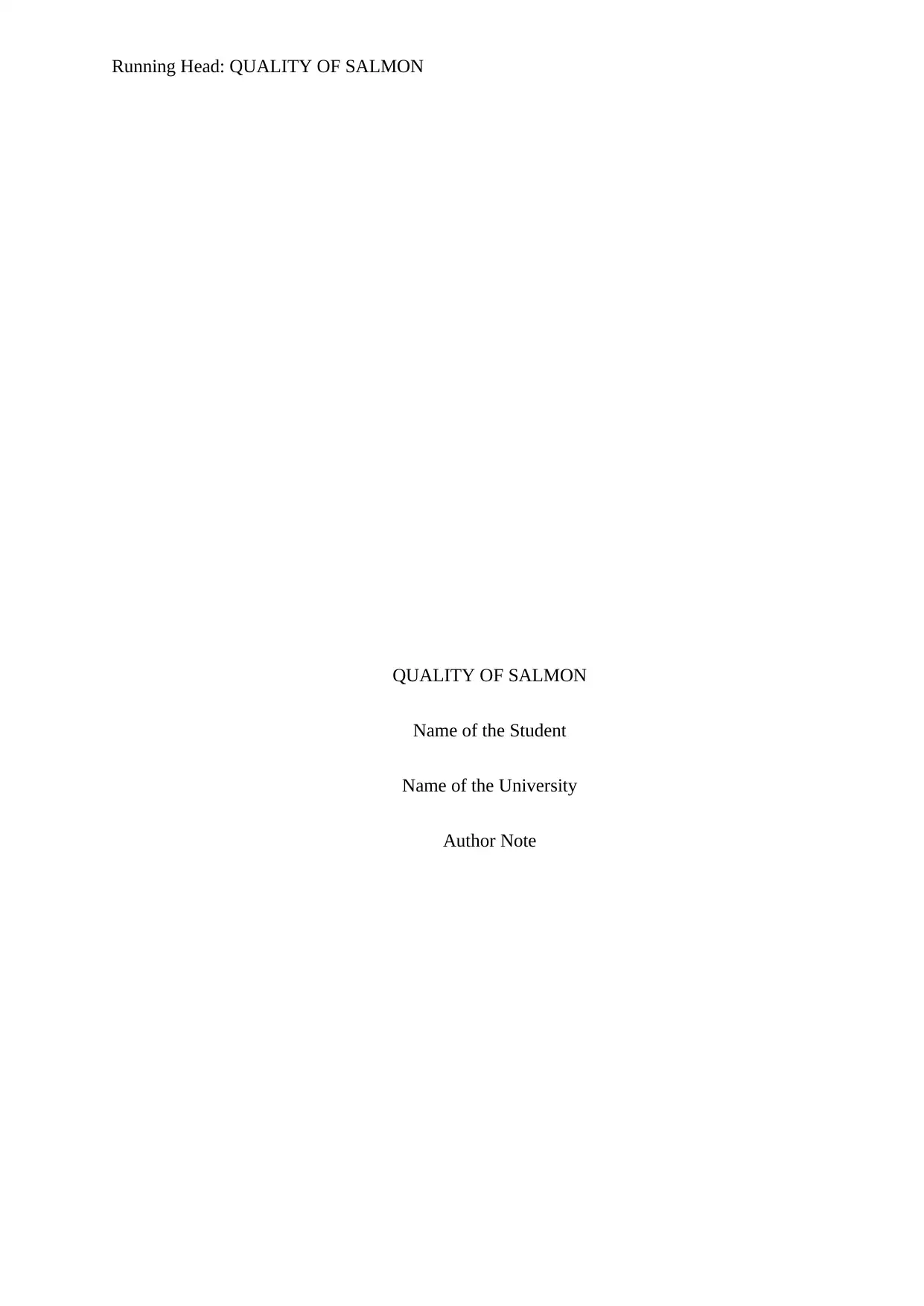
Running Head: QUALITY OF SALMON
QUALITY OF SALMON
Name of the Student
Name of the University
Author Note
QUALITY OF SALMON
Name of the Student
Name of the University
Author Note
Secure Best Marks with AI Grader
Need help grading? Try our AI Grader for instant feedback on your assignments.
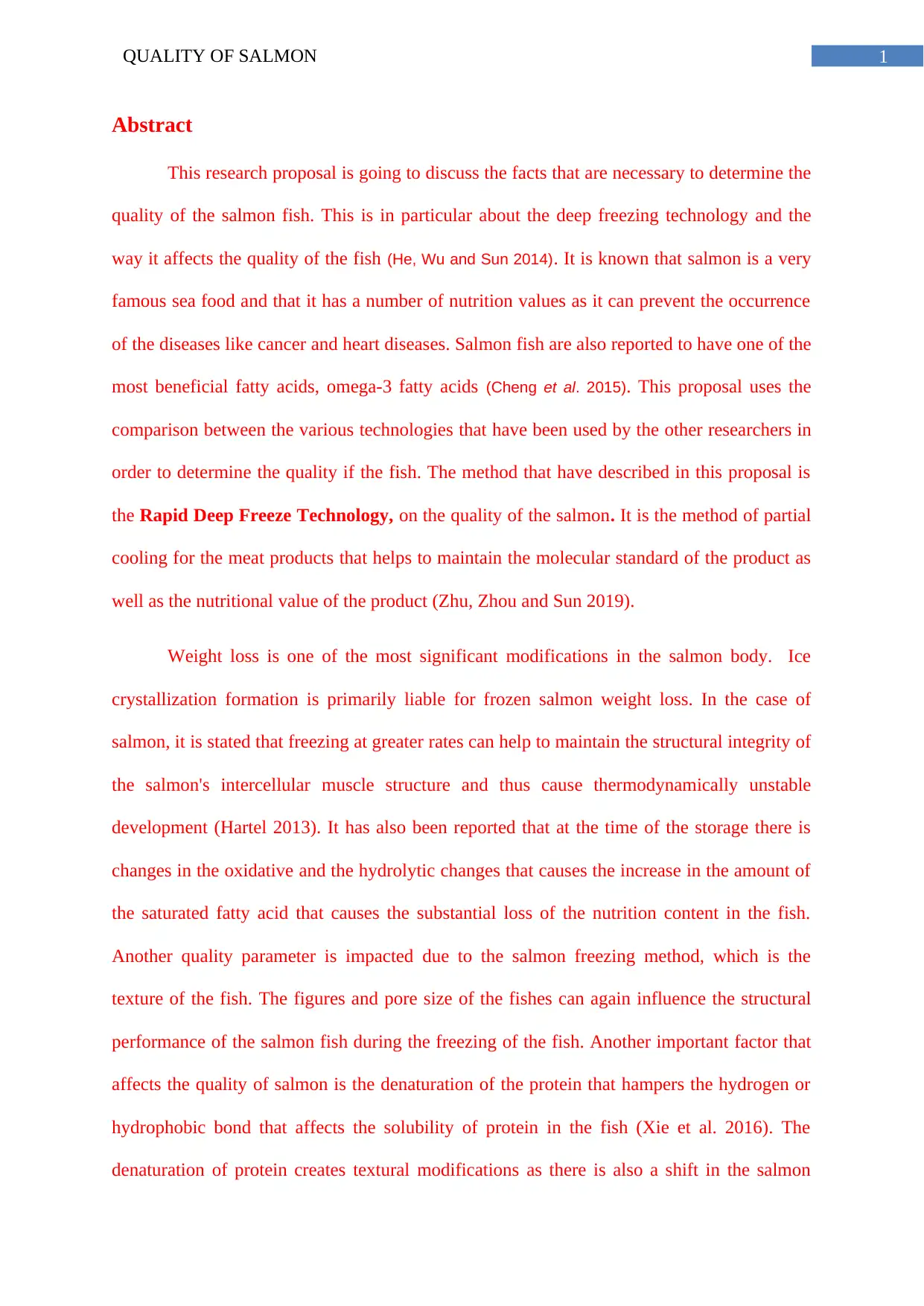
1QUALITY OF SALMON
Abstract
This research proposal is going to discuss the facts that are necessary to determine the
quality of the salmon fish. This is in particular about the deep freezing technology and the
way it affects the quality of the fish (He, Wu and Sun 2014). It is known that salmon is a very
famous sea food and that it has a number of nutrition values as it can prevent the occurrence
of the diseases like cancer and heart diseases. Salmon fish are also reported to have one of the
most beneficial fatty acids, omega-3 fatty acids (Cheng et al. 2015). This proposal uses the
comparison between the various technologies that have been used by the other researchers in
order to determine the quality if the fish. The method that have described in this proposal is
the Rapid Deep Freeze Technology, on the quality of the salmon. It is the method of partial
cooling for the meat products that helps to maintain the molecular standard of the product as
well as the nutritional value of the product (Zhu, Zhou and Sun 2019).
Weight loss is one of the most significant modifications in the salmon body. Ice
crystallization formation is primarily liable for frozen salmon weight loss. In the case of
salmon, it is stated that freezing at greater rates can help to maintain the structural integrity of
the salmon's intercellular muscle structure and thus cause thermodynamically unstable
development (Hartel 2013). It has also been reported that at the time of the storage there is
changes in the oxidative and the hydrolytic changes that causes the increase in the amount of
the saturated fatty acid that causes the substantial loss of the nutrition content in the fish.
Another quality parameter is impacted due to the salmon freezing method, which is the
texture of the fish. The figures and pore size of the fishes can again influence the structural
performance of the salmon fish during the freezing of the fish. Another important factor that
affects the quality of salmon is the denaturation of the protein that hampers the hydrogen or
hydrophobic bond that affects the solubility of protein in the fish (Xie et al. 2016). The
denaturation of protein creates textural modifications as there is also a shift in the salmon
Abstract
This research proposal is going to discuss the facts that are necessary to determine the
quality of the salmon fish. This is in particular about the deep freezing technology and the
way it affects the quality of the fish (He, Wu and Sun 2014). It is known that salmon is a very
famous sea food and that it has a number of nutrition values as it can prevent the occurrence
of the diseases like cancer and heart diseases. Salmon fish are also reported to have one of the
most beneficial fatty acids, omega-3 fatty acids (Cheng et al. 2015). This proposal uses the
comparison between the various technologies that have been used by the other researchers in
order to determine the quality if the fish. The method that have described in this proposal is
the Rapid Deep Freeze Technology, on the quality of the salmon. It is the method of partial
cooling for the meat products that helps to maintain the molecular standard of the product as
well as the nutritional value of the product (Zhu, Zhou and Sun 2019).
Weight loss is one of the most significant modifications in the salmon body. Ice
crystallization formation is primarily liable for frozen salmon weight loss. In the case of
salmon, it is stated that freezing at greater rates can help to maintain the structural integrity of
the salmon's intercellular muscle structure and thus cause thermodynamically unstable
development (Hartel 2013). It has also been reported that at the time of the storage there is
changes in the oxidative and the hydrolytic changes that causes the increase in the amount of
the saturated fatty acid that causes the substantial loss of the nutrition content in the fish.
Another quality parameter is impacted due to the salmon freezing method, which is the
texture of the fish. The figures and pore size of the fishes can again influence the structural
performance of the salmon fish during the freezing of the fish. Another important factor that
affects the quality of salmon is the denaturation of the protein that hampers the hydrogen or
hydrophobic bond that affects the solubility of protein in the fish (Xie et al. 2016). The
denaturation of protein creates textural modifications as there is also a shift in the salmon
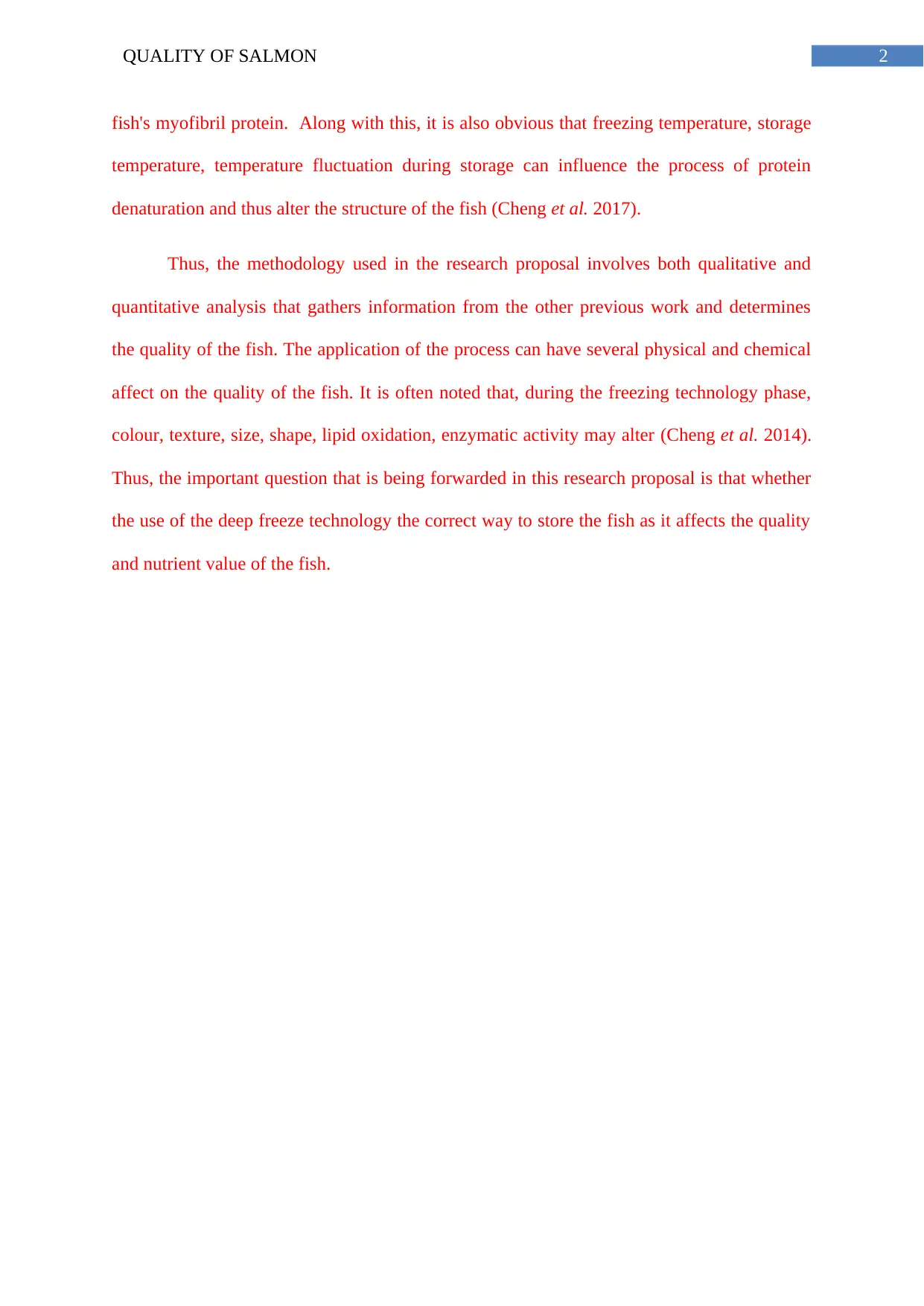
2QUALITY OF SALMON
fish's myofibril protein. Along with this, it is also obvious that freezing temperature, storage
temperature, temperature fluctuation during storage can influence the process of protein
denaturation and thus alter the structure of the fish (Cheng et al. 2017).
Thus, the methodology used in the research proposal involves both qualitative and
quantitative analysis that gathers information from the other previous work and determines
the quality of the fish. The application of the process can have several physical and chemical
affect on the quality of the fish. It is often noted that, during the freezing technology phase,
colour, texture, size, shape, lipid oxidation, enzymatic activity may alter (Cheng et al. 2014).
Thus, the important question that is being forwarded in this research proposal is that whether
the use of the deep freeze technology the correct way to store the fish as it affects the quality
and nutrient value of the fish.
fish's myofibril protein. Along with this, it is also obvious that freezing temperature, storage
temperature, temperature fluctuation during storage can influence the process of protein
denaturation and thus alter the structure of the fish (Cheng et al. 2017).
Thus, the methodology used in the research proposal involves both qualitative and
quantitative analysis that gathers information from the other previous work and determines
the quality of the fish. The application of the process can have several physical and chemical
affect on the quality of the fish. It is often noted that, during the freezing technology phase,
colour, texture, size, shape, lipid oxidation, enzymatic activity may alter (Cheng et al. 2014).
Thus, the important question that is being forwarded in this research proposal is that whether
the use of the deep freeze technology the correct way to store the fish as it affects the quality
and nutrient value of the fish.
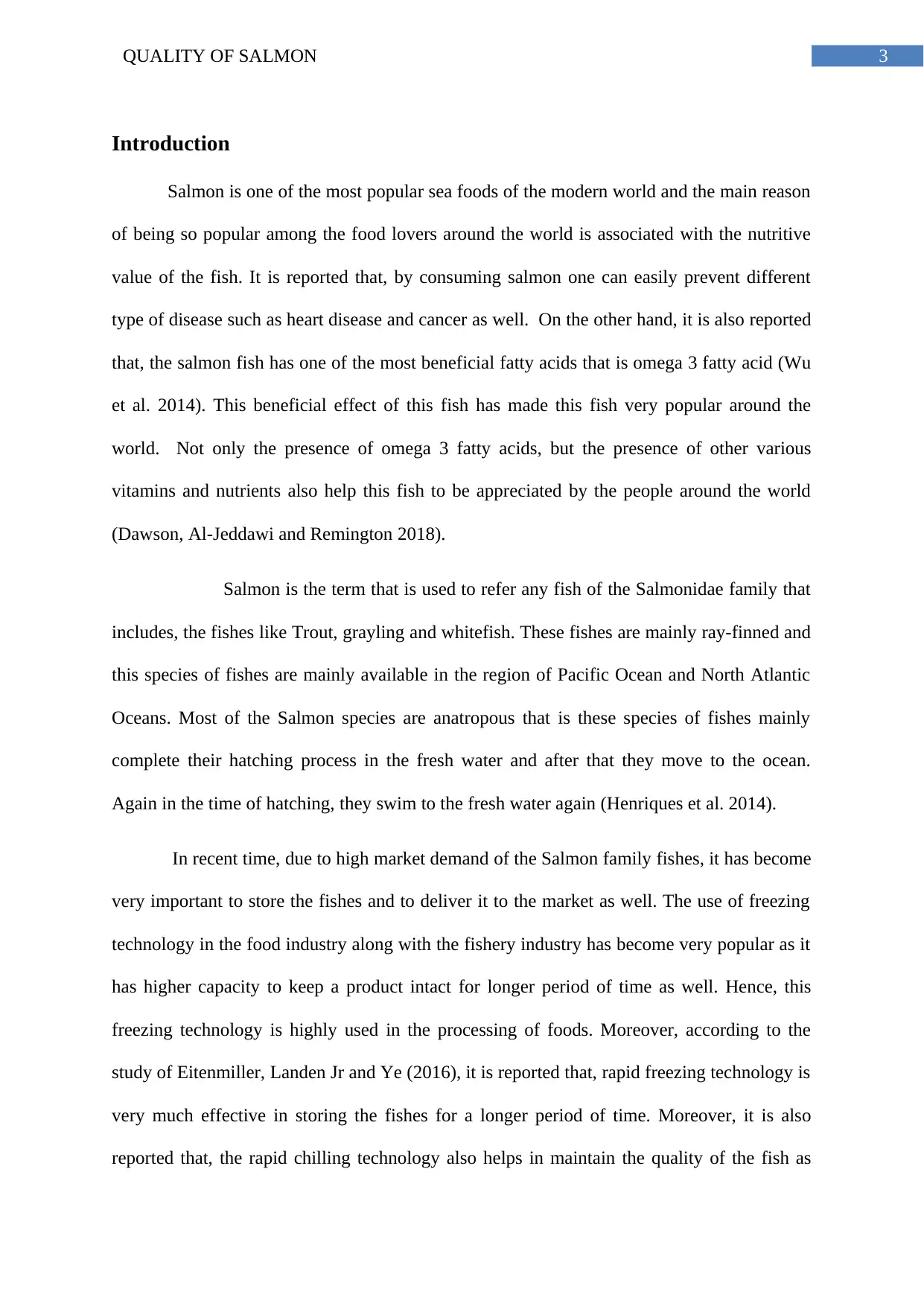
3QUALITY OF SALMON
Introduction
Salmon is one of the most popular sea foods of the modern world and the main reason
of being so popular among the food lovers around the world is associated with the nutritive
value of the fish. It is reported that, by consuming salmon one can easily prevent different
type of disease such as heart disease and cancer as well. On the other hand, it is also reported
that, the salmon fish has one of the most beneficial fatty acids that is omega 3 fatty acid (Wu
et al. 2014). This beneficial effect of this fish has made this fish very popular around the
world. Not only the presence of omega 3 fatty acids, but the presence of other various
vitamins and nutrients also help this fish to be appreciated by the people around the world
(Dawson, Al-Jeddawi and Remington 2018).
Salmon is the term that is used to refer any fish of the Salmonidae family that
includes, the fishes like Trout, grayling and whitefish. These fishes are mainly ray-finned and
this species of fishes are mainly available in the region of Pacific Ocean and North Atlantic
Oceans. Most of the Salmon species are anatropous that is these species of fishes mainly
complete their hatching process in the fresh water and after that they move to the ocean.
Again in the time of hatching, they swim to the fresh water again (Henriques et al. 2014).
In recent time, due to high market demand of the Salmon family fishes, it has become
very important to store the fishes and to deliver it to the market as well. The use of freezing
technology in the food industry along with the fishery industry has become very popular as it
has higher capacity to keep a product intact for longer period of time as well. Hence, this
freezing technology is highly used in the processing of foods. Moreover, according to the
study of Eitenmiller, Landen Jr and Ye (2016), it is reported that, rapid freezing technology is
very much effective in storing the fishes for a longer period of time. Moreover, it is also
reported that, the rapid chilling technology also helps in maintain the quality of the fish as
Introduction
Salmon is one of the most popular sea foods of the modern world and the main reason
of being so popular among the food lovers around the world is associated with the nutritive
value of the fish. It is reported that, by consuming salmon one can easily prevent different
type of disease such as heart disease and cancer as well. On the other hand, it is also reported
that, the salmon fish has one of the most beneficial fatty acids that is omega 3 fatty acid (Wu
et al. 2014). This beneficial effect of this fish has made this fish very popular around the
world. Not only the presence of omega 3 fatty acids, but the presence of other various
vitamins and nutrients also help this fish to be appreciated by the people around the world
(Dawson, Al-Jeddawi and Remington 2018).
Salmon is the term that is used to refer any fish of the Salmonidae family that
includes, the fishes like Trout, grayling and whitefish. These fishes are mainly ray-finned and
this species of fishes are mainly available in the region of Pacific Ocean and North Atlantic
Oceans. Most of the Salmon species are anatropous that is these species of fishes mainly
complete their hatching process in the fresh water and after that they move to the ocean.
Again in the time of hatching, they swim to the fresh water again (Henriques et al. 2014).
In recent time, due to high market demand of the Salmon family fishes, it has become
very important to store the fishes and to deliver it to the market as well. The use of freezing
technology in the food industry along with the fishery industry has become very popular as it
has higher capacity to keep a product intact for longer period of time as well. Hence, this
freezing technology is highly used in the processing of foods. Moreover, according to the
study of Eitenmiller, Landen Jr and Ye (2016), it is reported that, rapid freezing technology is
very much effective in storing the fishes for a longer period of time. Moreover, it is also
reported that, the rapid chilling technology also helps in maintain the quality of the fish as
Secure Best Marks with AI Grader
Need help grading? Try our AI Grader for instant feedback on your assignments.

4QUALITY OF SALMON
well. As with the time, the consumers are become very conscious about their health and diet
and so they are more concentrating on the quality of the food product that they are consuming
as part of their daily diet (Kaale et al. 2013). Therefore the vitamin and mineral enriched
property of the Salmon fish is a good reason for having Salmon as a part of their daily diet.
So, it is the duty of the companies supplying Salmon to the various market of the world to
provide a good quality salmon to the consumers. The existence of the freezing technology has
made the responsibilities of the companies easier as they can easily store the salmon fish for a
long period of time without making it disrupted. Moreover, in multiple studies, it is reported
that, rapid freezing has multiple positive sides while compared with the normal freezing
process and thus in most of the cases, salmon is stored by using this rapid freezing process
(Kaale and Eikevik 2013). Although, all of the fresh foods along with Salomon fishes shows
good nutritious value while they are consumed in a fresh manner. Hence, some people likes
to consume it as a fresh. However, it is not possible to consume a fresh salmon all the time
due to its availability only in the ocean. On the contrary, it is also reported that, frozen fish
are capable of maintaining good colour, structure and nutritional while fresh salmon can lose
the colour and textures if they are not stored in a proper manner ((Kaale and Eikevik 2012).
In this literature review, the comparison in between the fresh salmon and effect of
rapid refrigeration on the quality of salmon in a brief manner.
Literature Review
Quality of Fresh Salmon
In a fresh Salmon, it is reported that, the fish generally contains 16-21% of high
quality animal protein and the amount of fat in a fresh salmon is almost 0.2-5%. Along with
this, the fish also contains different type of minerals, and vitamins as well. From the several
studies, it is reported that in the fish, the amount of minerals is almost 1.2% to 1.5% and the
well. As with the time, the consumers are become very conscious about their health and diet
and so they are more concentrating on the quality of the food product that they are consuming
as part of their daily diet (Kaale et al. 2013). Therefore the vitamin and mineral enriched
property of the Salmon fish is a good reason for having Salmon as a part of their daily diet.
So, it is the duty of the companies supplying Salmon to the various market of the world to
provide a good quality salmon to the consumers. The existence of the freezing technology has
made the responsibilities of the companies easier as they can easily store the salmon fish for a
long period of time without making it disrupted. Moreover, in multiple studies, it is reported
that, rapid freezing has multiple positive sides while compared with the normal freezing
process and thus in most of the cases, salmon is stored by using this rapid freezing process
(Kaale and Eikevik 2013). Although, all of the fresh foods along with Salomon fishes shows
good nutritious value while they are consumed in a fresh manner. Hence, some people likes
to consume it as a fresh. However, it is not possible to consume a fresh salmon all the time
due to its availability only in the ocean. On the contrary, it is also reported that, frozen fish
are capable of maintaining good colour, structure and nutritional while fresh salmon can lose
the colour and textures if they are not stored in a proper manner ((Kaale and Eikevik 2012).
In this literature review, the comparison in between the fresh salmon and effect of
rapid refrigeration on the quality of salmon in a brief manner.
Literature Review
Quality of Fresh Salmon
In a fresh Salmon, it is reported that, the fish generally contains 16-21% of high
quality animal protein and the amount of fat in a fresh salmon is almost 0.2-5%. Along with
this, the fish also contains different type of minerals, and vitamins as well. From the several
studies, it is reported that in the fish, the amount of minerals is almost 1.2% to 1.5% and the
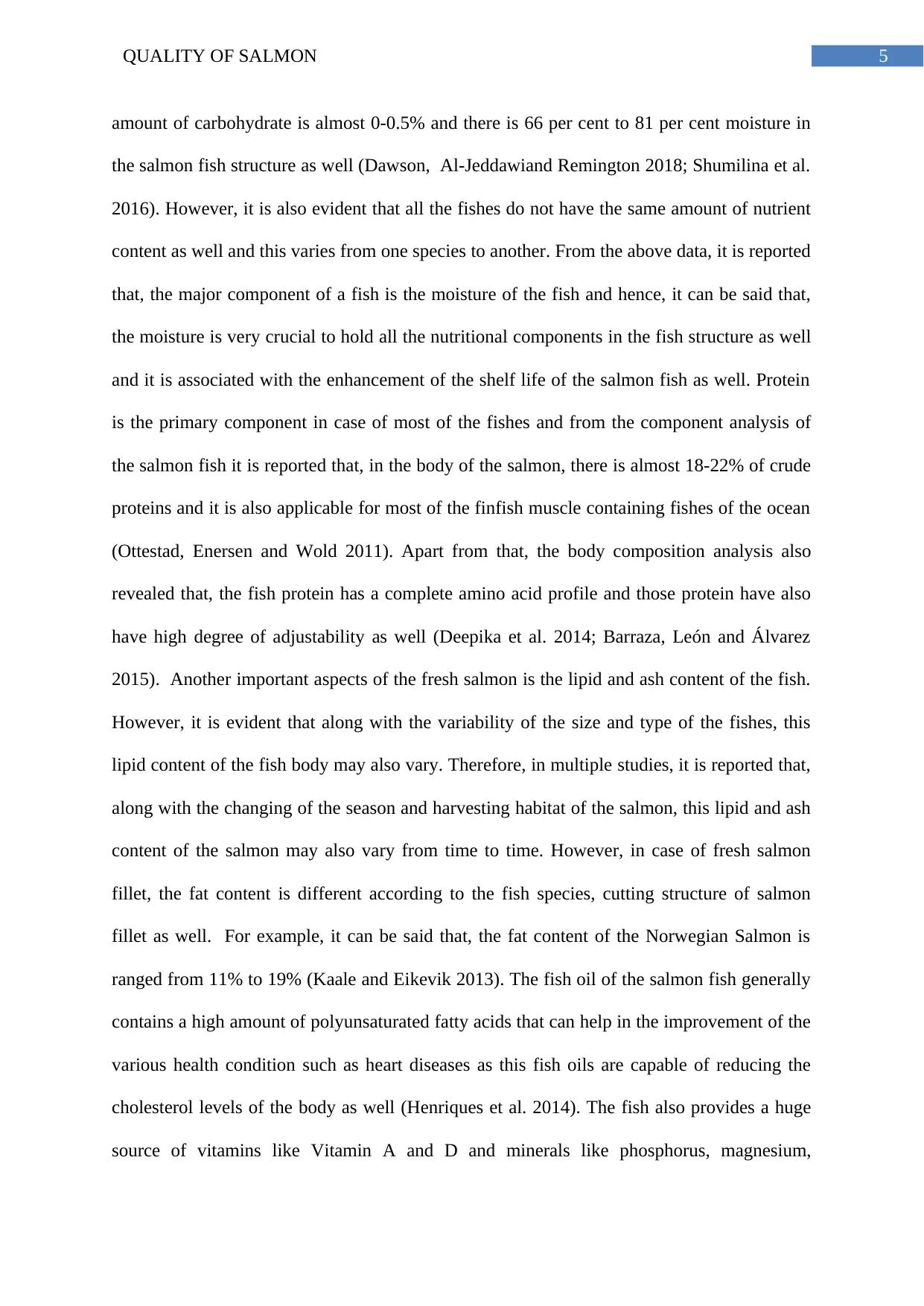
5QUALITY OF SALMON
amount of carbohydrate is almost 0-0.5% and there is 66 per cent to 81 per cent moisture in
the salmon fish structure as well (Dawson, Al-Jeddawiand Remington 2018; Shumilina et al.
2016). However, it is also evident that all the fishes do not have the same amount of nutrient
content as well and this varies from one species to another. From the above data, it is reported
that, the major component of a fish is the moisture of the fish and hence, it can be said that,
the moisture is very crucial to hold all the nutritional components in the fish structure as well
and it is associated with the enhancement of the shelf life of the salmon fish as well. Protein
is the primary component in case of most of the fishes and from the component analysis of
the salmon fish it is reported that, in the body of the salmon, there is almost 18-22% of crude
proteins and it is also applicable for most of the finfish muscle containing fishes of the ocean
(Ottestad, Enersen and Wold 2011). Apart from that, the body composition analysis also
revealed that, the fish protein has a complete amino acid profile and those protein have also
have high degree of adjustability as well (Deepika et al. 2014; Barraza, León and Álvarez
2015). Another important aspects of the fresh salmon is the lipid and ash content of the fish.
However, it is evident that along with the variability of the size and type of the fishes, this
lipid content of the fish body may also vary. Therefore, in multiple studies, it is reported that,
along with the changing of the season and harvesting habitat of the salmon, this lipid and ash
content of the salmon may also vary from time to time. However, in case of fresh salmon
fillet, the fat content is different according to the fish species, cutting structure of salmon
fillet as well. For example, it can be said that, the fat content of the Norwegian Salmon is
ranged from 11% to 19% (Kaale and Eikevik 2013). The fish oil of the salmon fish generally
contains a high amount of polyunsaturated fatty acids that can help in the improvement of the
various health condition such as heart diseases as this fish oils are capable of reducing the
cholesterol levels of the body as well (Henriques et al. 2014). The fish also provides a huge
source of vitamins like Vitamin A and D and minerals like phosphorus, magnesium,
amount of carbohydrate is almost 0-0.5% and there is 66 per cent to 81 per cent moisture in
the salmon fish structure as well (Dawson, Al-Jeddawiand Remington 2018; Shumilina et al.
2016). However, it is also evident that all the fishes do not have the same amount of nutrient
content as well and this varies from one species to another. From the above data, it is reported
that, the major component of a fish is the moisture of the fish and hence, it can be said that,
the moisture is very crucial to hold all the nutritional components in the fish structure as well
and it is associated with the enhancement of the shelf life of the salmon fish as well. Protein
is the primary component in case of most of the fishes and from the component analysis of
the salmon fish it is reported that, in the body of the salmon, there is almost 18-22% of crude
proteins and it is also applicable for most of the finfish muscle containing fishes of the ocean
(Ottestad, Enersen and Wold 2011). Apart from that, the body composition analysis also
revealed that, the fish protein has a complete amino acid profile and those protein have also
have high degree of adjustability as well (Deepika et al. 2014; Barraza, León and Álvarez
2015). Another important aspects of the fresh salmon is the lipid and ash content of the fish.
However, it is evident that along with the variability of the size and type of the fishes, this
lipid content of the fish body may also vary. Therefore, in multiple studies, it is reported that,
along with the changing of the season and harvesting habitat of the salmon, this lipid and ash
content of the salmon may also vary from time to time. However, in case of fresh salmon
fillet, the fat content is different according to the fish species, cutting structure of salmon
fillet as well. For example, it can be said that, the fat content of the Norwegian Salmon is
ranged from 11% to 19% (Kaale and Eikevik 2013). The fish oil of the salmon fish generally
contains a high amount of polyunsaturated fatty acids that can help in the improvement of the
various health condition such as heart diseases as this fish oils are capable of reducing the
cholesterol levels of the body as well (Henriques et al. 2014). The fish also provides a huge
source of vitamins like Vitamin A and D and minerals like phosphorus, magnesium,
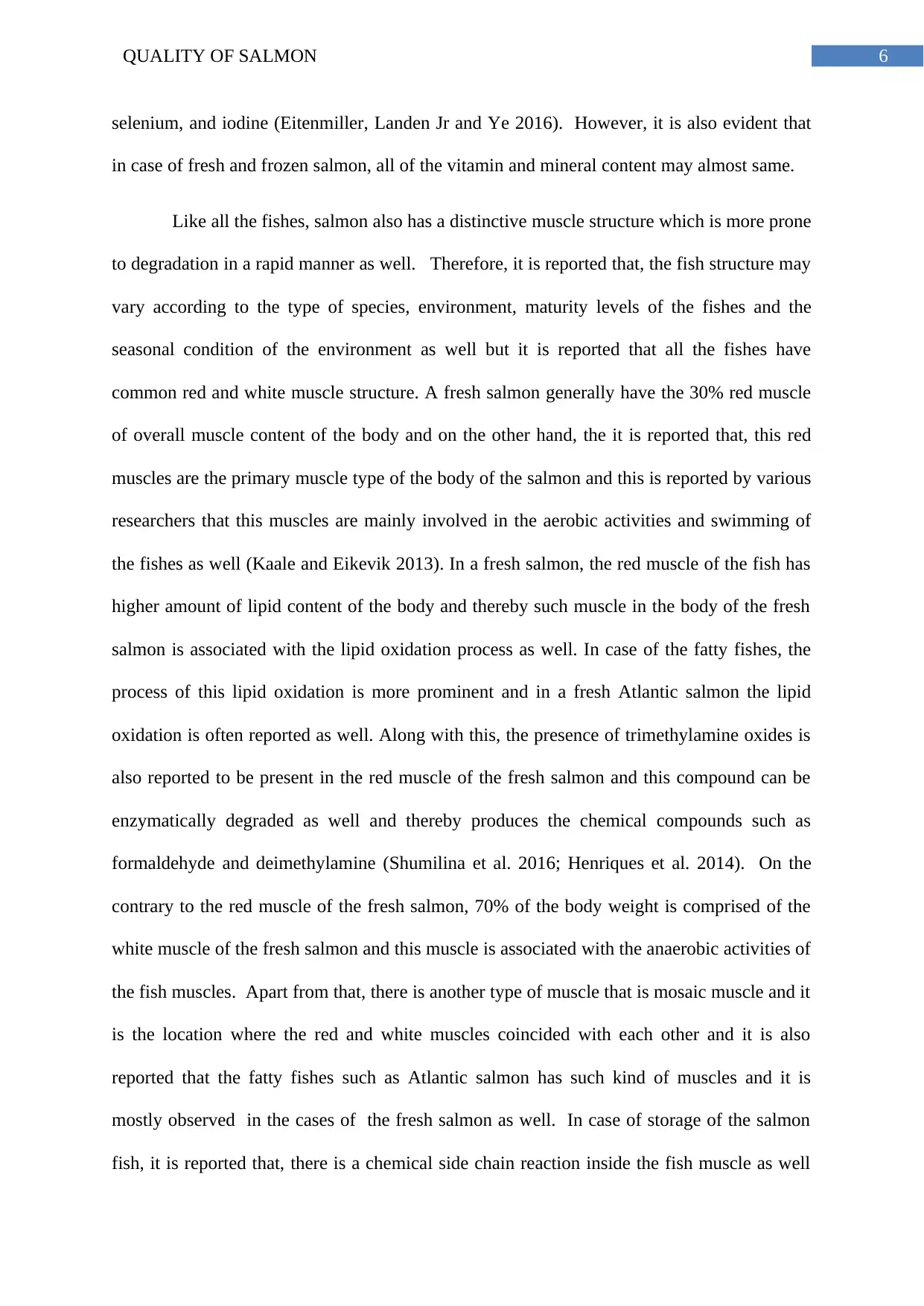
6QUALITY OF SALMON
selenium, and iodine (Eitenmiller, Landen Jr and Ye 2016). However, it is also evident that
in case of fresh and frozen salmon, all of the vitamin and mineral content may almost same.
Like all the fishes, salmon also has a distinctive muscle structure which is more prone
to degradation in a rapid manner as well. Therefore, it is reported that, the fish structure may
vary according to the type of species, environment, maturity levels of the fishes and the
seasonal condition of the environment as well but it is reported that all the fishes have
common red and white muscle structure. A fresh salmon generally have the 30% red muscle
of overall muscle content of the body and on the other hand, the it is reported that, this red
muscles are the primary muscle type of the body of the salmon and this is reported by various
researchers that this muscles are mainly involved in the aerobic activities and swimming of
the fishes as well (Kaale and Eikevik 2013). In a fresh salmon, the red muscle of the fish has
higher amount of lipid content of the body and thereby such muscle in the body of the fresh
salmon is associated with the lipid oxidation process as well. In case of the fatty fishes, the
process of this lipid oxidation is more prominent and in a fresh Atlantic salmon the lipid
oxidation is often reported as well. Along with this, the presence of trimethylamine oxides is
also reported to be present in the red muscle of the fresh salmon and this compound can be
enzymatically degraded as well and thereby produces the chemical compounds such as
formaldehyde and deimethylamine (Shumilina et al. 2016; Henriques et al. 2014). On the
contrary to the red muscle of the fresh salmon, 70% of the body weight is comprised of the
white muscle of the fresh salmon and this muscle is associated with the anaerobic activities of
the fish muscles. Apart from that, there is another type of muscle that is mosaic muscle and it
is the location where the red and white muscles coincided with each other and it is also
reported that the fatty fishes such as Atlantic salmon has such kind of muscles and it is
mostly observed in the cases of the fresh salmon as well. In case of storage of the salmon
fish, it is reported that, there is a chemical side chain reaction inside the fish muscle as well
selenium, and iodine (Eitenmiller, Landen Jr and Ye 2016). However, it is also evident that
in case of fresh and frozen salmon, all of the vitamin and mineral content may almost same.
Like all the fishes, salmon also has a distinctive muscle structure which is more prone
to degradation in a rapid manner as well. Therefore, it is reported that, the fish structure may
vary according to the type of species, environment, maturity levels of the fishes and the
seasonal condition of the environment as well but it is reported that all the fishes have
common red and white muscle structure. A fresh salmon generally have the 30% red muscle
of overall muscle content of the body and on the other hand, the it is reported that, this red
muscles are the primary muscle type of the body of the salmon and this is reported by various
researchers that this muscles are mainly involved in the aerobic activities and swimming of
the fishes as well (Kaale and Eikevik 2013). In a fresh salmon, the red muscle of the fish has
higher amount of lipid content of the body and thereby such muscle in the body of the fresh
salmon is associated with the lipid oxidation process as well. In case of the fatty fishes, the
process of this lipid oxidation is more prominent and in a fresh Atlantic salmon the lipid
oxidation is often reported as well. Along with this, the presence of trimethylamine oxides is
also reported to be present in the red muscle of the fresh salmon and this compound can be
enzymatically degraded as well and thereby produces the chemical compounds such as
formaldehyde and deimethylamine (Shumilina et al. 2016; Henriques et al. 2014). On the
contrary to the red muscle of the fresh salmon, 70% of the body weight is comprised of the
white muscle of the fresh salmon and this muscle is associated with the anaerobic activities of
the fish muscles. Apart from that, there is another type of muscle that is mosaic muscle and it
is the location where the red and white muscles coincided with each other and it is also
reported that the fatty fishes such as Atlantic salmon has such kind of muscles and it is
mostly observed in the cases of the fresh salmon as well. In case of storage of the salmon
fish, it is reported that, there is a chemical side chain reaction inside the fish muscle as well
Paraphrase This Document
Need a fresh take? Get an instant paraphrase of this document with our AI Paraphraser
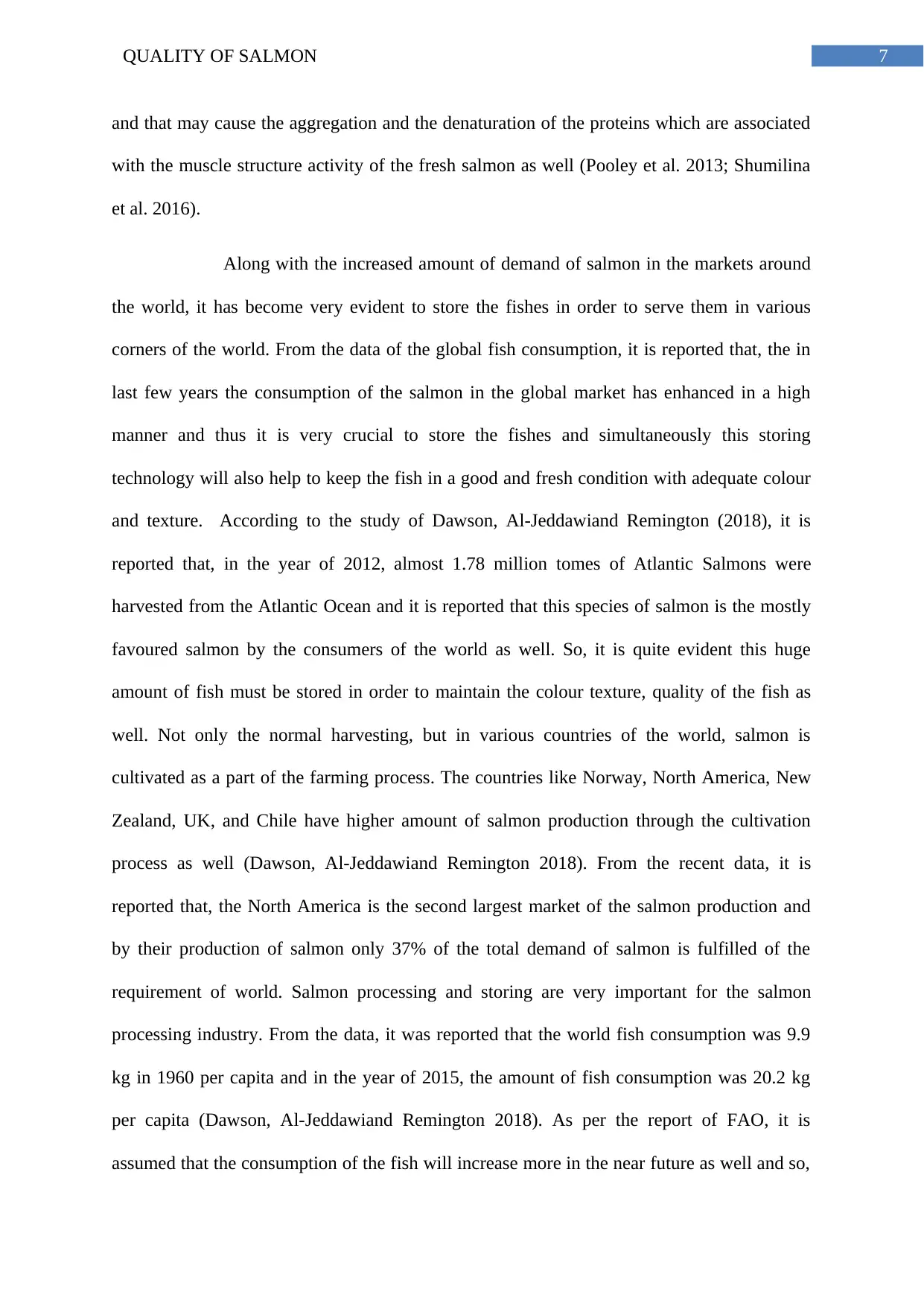
7QUALITY OF SALMON
and that may cause the aggregation and the denaturation of the proteins which are associated
with the muscle structure activity of the fresh salmon as well (Pooley et al. 2013; Shumilina
et al. 2016).
Along with the increased amount of demand of salmon in the markets around
the world, it has become very evident to store the fishes in order to serve them in various
corners of the world. From the data of the global fish consumption, it is reported that, the in
last few years the consumption of the salmon in the global market has enhanced in a high
manner and thus it is very crucial to store the fishes and simultaneously this storing
technology will also help to keep the fish in a good and fresh condition with adequate colour
and texture. According to the study of Dawson, Al-Jeddawiand Remington (2018), it is
reported that, in the year of 2012, almost 1.78 million tomes of Atlantic Salmons were
harvested from the Atlantic Ocean and it is reported that this species of salmon is the mostly
favoured salmon by the consumers of the world as well. So, it is quite evident this huge
amount of fish must be stored in order to maintain the colour texture, quality of the fish as
well. Not only the normal harvesting, but in various countries of the world, salmon is
cultivated as a part of the farming process. The countries like Norway, North America, New
Zealand, UK, and Chile have higher amount of salmon production through the cultivation
process as well (Dawson, Al-Jeddawiand Remington 2018). From the recent data, it is
reported that, the North America is the second largest market of the salmon production and
by their production of salmon only 37% of the total demand of salmon is fulfilled of the
requirement of world. Salmon processing and storing are very important for the salmon
processing industry. From the data, it was reported that the world fish consumption was 9.9
kg in 1960 per capita and in the year of 2015, the amount of fish consumption was 20.2 kg
per capita (Dawson, Al-Jeddawiand Remington 2018). As per the report of FAO, it is
assumed that the consumption of the fish will increase more in the near future as well and so,
and that may cause the aggregation and the denaturation of the proteins which are associated
with the muscle structure activity of the fresh salmon as well (Pooley et al. 2013; Shumilina
et al. 2016).
Along with the increased amount of demand of salmon in the markets around
the world, it has become very evident to store the fishes in order to serve them in various
corners of the world. From the data of the global fish consumption, it is reported that, the in
last few years the consumption of the salmon in the global market has enhanced in a high
manner and thus it is very crucial to store the fishes and simultaneously this storing
technology will also help to keep the fish in a good and fresh condition with adequate colour
and texture. According to the study of Dawson, Al-Jeddawiand Remington (2018), it is
reported that, in the year of 2012, almost 1.78 million tomes of Atlantic Salmons were
harvested from the Atlantic Ocean and it is reported that this species of salmon is the mostly
favoured salmon by the consumers of the world as well. So, it is quite evident this huge
amount of fish must be stored in order to maintain the colour texture, quality of the fish as
well. Not only the normal harvesting, but in various countries of the world, salmon is
cultivated as a part of the farming process. The countries like Norway, North America, New
Zealand, UK, and Chile have higher amount of salmon production through the cultivation
process as well (Dawson, Al-Jeddawiand Remington 2018). From the recent data, it is
reported that, the North America is the second largest market of the salmon production and
by their production of salmon only 37% of the total demand of salmon is fulfilled of the
requirement of world. Salmon processing and storing are very important for the salmon
processing industry. From the data, it was reported that the world fish consumption was 9.9
kg in 1960 per capita and in the year of 2015, the amount of fish consumption was 20.2 kg
per capita (Dawson, Al-Jeddawiand Remington 2018). As per the report of FAO, it is
assumed that the consumption of the fish will increase more in the near future as well and so,
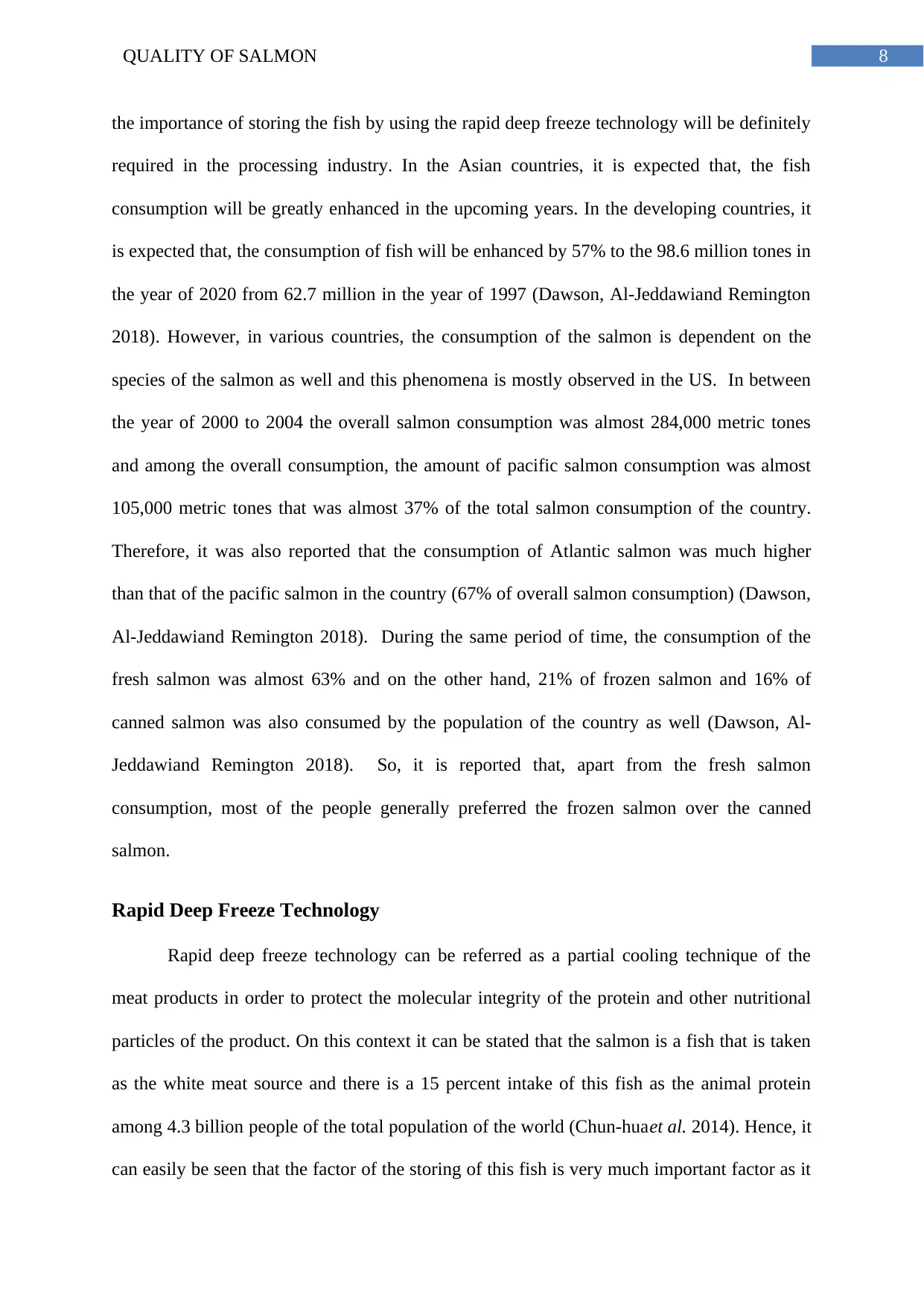
8QUALITY OF SALMON
the importance of storing the fish by using the rapid deep freeze technology will be definitely
required in the processing industry. In the Asian countries, it is expected that, the fish
consumption will be greatly enhanced in the upcoming years. In the developing countries, it
is expected that, the consumption of fish will be enhanced by 57% to the 98.6 million tones in
the year of 2020 from 62.7 million in the year of 1997 (Dawson, Al-Jeddawiand Remington
2018). However, in various countries, the consumption of the salmon is dependent on the
species of the salmon as well and this phenomena is mostly observed in the US. In between
the year of 2000 to 2004 the overall salmon consumption was almost 284,000 metric tones
and among the overall consumption, the amount of pacific salmon consumption was almost
105,000 metric tones that was almost 37% of the total salmon consumption of the country.
Therefore, it was also reported that the consumption of Atlantic salmon was much higher
than that of the pacific salmon in the country (67% of overall salmon consumption) (Dawson,
Al-Jeddawiand Remington 2018). During the same period of time, the consumption of the
fresh salmon was almost 63% and on the other hand, 21% of frozen salmon and 16% of
canned salmon was also consumed by the population of the country as well (Dawson, Al-
Jeddawiand Remington 2018). So, it is reported that, apart from the fresh salmon
consumption, most of the people generally preferred the frozen salmon over the canned
salmon.
Rapid Deep Freeze Technology
Rapid deep freeze technology can be referred as a partial cooling technique of the
meat products in order to protect the molecular integrity of the protein and other nutritional
particles of the product. On this context it can be stated that the salmon is a fish that is taken
as the white meat source and there is a 15 percent intake of this fish as the animal protein
among 4.3 billion people of the total population of the world (Chun-huaet al. 2014). Hence, it
can easily be seen that the factor of the storing of this fish is very much important factor as it
the importance of storing the fish by using the rapid deep freeze technology will be definitely
required in the processing industry. In the Asian countries, it is expected that, the fish
consumption will be greatly enhanced in the upcoming years. In the developing countries, it
is expected that, the consumption of fish will be enhanced by 57% to the 98.6 million tones in
the year of 2020 from 62.7 million in the year of 1997 (Dawson, Al-Jeddawiand Remington
2018). However, in various countries, the consumption of the salmon is dependent on the
species of the salmon as well and this phenomena is mostly observed in the US. In between
the year of 2000 to 2004 the overall salmon consumption was almost 284,000 metric tones
and among the overall consumption, the amount of pacific salmon consumption was almost
105,000 metric tones that was almost 37% of the total salmon consumption of the country.
Therefore, it was also reported that the consumption of Atlantic salmon was much higher
than that of the pacific salmon in the country (67% of overall salmon consumption) (Dawson,
Al-Jeddawiand Remington 2018). During the same period of time, the consumption of the
fresh salmon was almost 63% and on the other hand, 21% of frozen salmon and 16% of
canned salmon was also consumed by the population of the country as well (Dawson, Al-
Jeddawiand Remington 2018). So, it is reported that, apart from the fresh salmon
consumption, most of the people generally preferred the frozen salmon over the canned
salmon.
Rapid Deep Freeze Technology
Rapid deep freeze technology can be referred as a partial cooling technique of the
meat products in order to protect the molecular integrity of the protein and other nutritional
particles of the product. On this context it can be stated that the salmon is a fish that is taken
as the white meat source and there is a 15 percent intake of this fish as the animal protein
among 4.3 billion people of the total population of the world (Chun-huaet al. 2014). Hence, it
can easily be seen that the factor of the storing of this fish is very much important factor as it
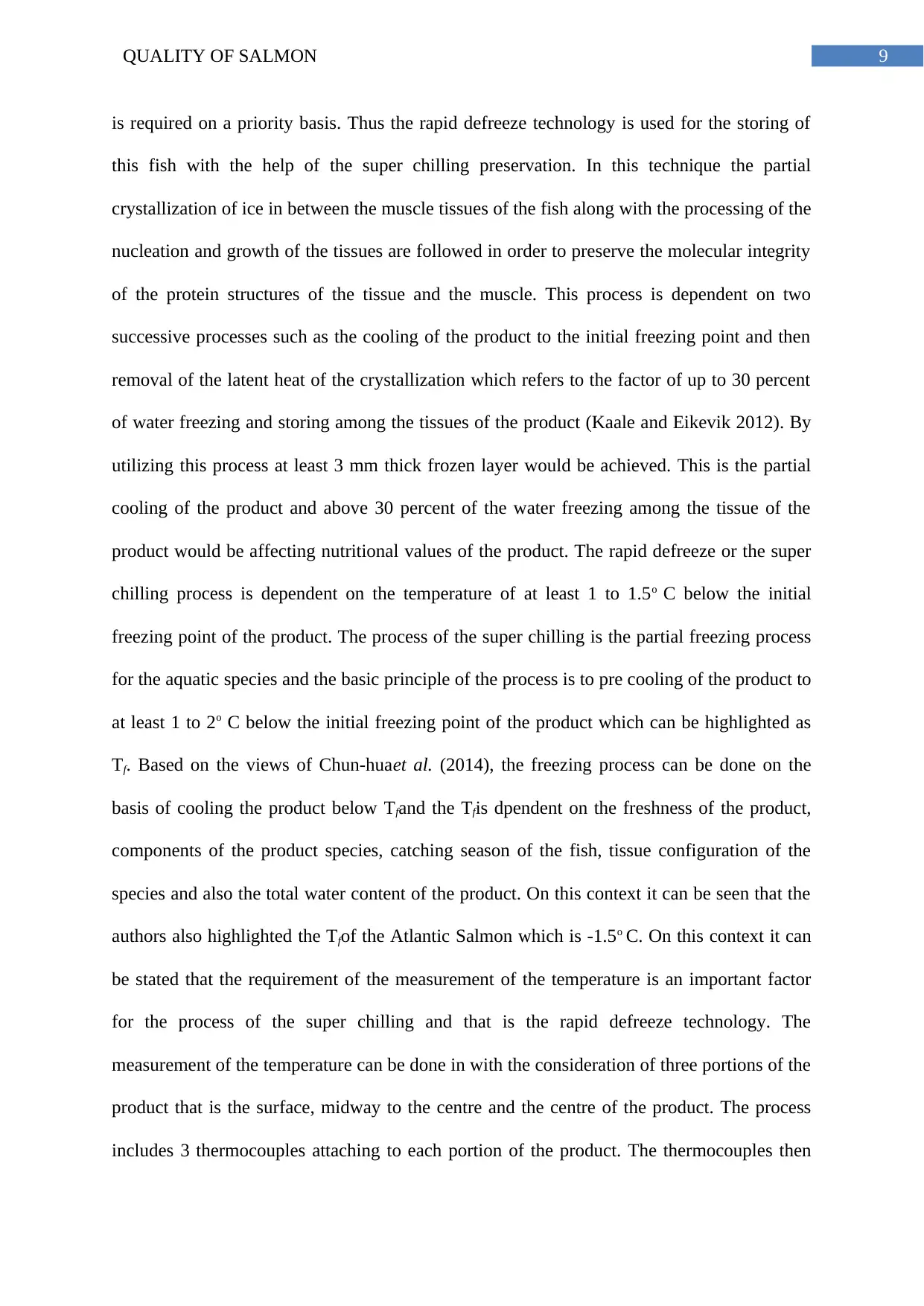
9QUALITY OF SALMON
is required on a priority basis. Thus the rapid defreeze technology is used for the storing of
this fish with the help of the super chilling preservation. In this technique the partial
crystallization of ice in between the muscle tissues of the fish along with the processing of the
nucleation and growth of the tissues are followed in order to preserve the molecular integrity
of the protein structures of the tissue and the muscle. This process is dependent on two
successive processes such as the cooling of the product to the initial freezing point and then
removal of the latent heat of the crystallization which refers to the factor of up to 30 percent
of water freezing and storing among the tissues of the product (Kaale and Eikevik 2012). By
utilizing this process at least 3 mm thick frozen layer would be achieved. This is the partial
cooling of the product and above 30 percent of the water freezing among the tissue of the
product would be affecting nutritional values of the product. The rapid defreeze or the super
chilling process is dependent on the temperature of at least 1 to 1.5o C below the initial
freezing point of the product. The process of the super chilling is the partial freezing process
for the aquatic species and the basic principle of the process is to pre cooling of the product to
at least 1 to 2o C below the initial freezing point of the product which can be highlighted as
Tf. Based on the views of Chun-huaet al. (2014), the freezing process can be done on the
basis of cooling the product below Tfand the Tfis dpendent on the freshness of the product,
components of the product species, catching season of the fish, tissue configuration of the
species and also the total water content of the product. On this context it can be seen that the
authors also highlighted the Tfof the Atlantic Salmon which is -1.5o C. On this context it can
be stated that the requirement of the measurement of the temperature is an important factor
for the process of the super chilling and that is the rapid defreeze technology. The
measurement of the temperature can be done in with the consideration of three portions of the
product that is the surface, midway to the centre and the centre of the product. The process
includes 3 thermocouples attaching to each portion of the product. The thermocouples then
is required on a priority basis. Thus the rapid defreeze technology is used for the storing of
this fish with the help of the super chilling preservation. In this technique the partial
crystallization of ice in between the muscle tissues of the fish along with the processing of the
nucleation and growth of the tissues are followed in order to preserve the molecular integrity
of the protein structures of the tissue and the muscle. This process is dependent on two
successive processes such as the cooling of the product to the initial freezing point and then
removal of the latent heat of the crystallization which refers to the factor of up to 30 percent
of water freezing and storing among the tissues of the product (Kaale and Eikevik 2012). By
utilizing this process at least 3 mm thick frozen layer would be achieved. This is the partial
cooling of the product and above 30 percent of the water freezing among the tissue of the
product would be affecting nutritional values of the product. The rapid defreeze or the super
chilling process is dependent on the temperature of at least 1 to 1.5o C below the initial
freezing point of the product. The process of the super chilling is the partial freezing process
for the aquatic species and the basic principle of the process is to pre cooling of the product to
at least 1 to 2o C below the initial freezing point of the product which can be highlighted as
Tf. Based on the views of Chun-huaet al. (2014), the freezing process can be done on the
basis of cooling the product below Tfand the Tfis dpendent on the freshness of the product,
components of the product species, catching season of the fish, tissue configuration of the
species and also the total water content of the product. On this context it can be seen that the
authors also highlighted the Tfof the Atlantic Salmon which is -1.5o C. On this context it can
be stated that the requirement of the measurement of the temperature is an important factor
for the process of the super chilling and that is the rapid defreeze technology. The
measurement of the temperature can be done in with the consideration of three portions of the
product that is the surface, midway to the centre and the centre of the product. The process
includes 3 thermocouples attaching to each portion of the product. The thermocouples then
Secure Best Marks with AI Grader
Need help grading? Try our AI Grader for instant feedback on your assignments.
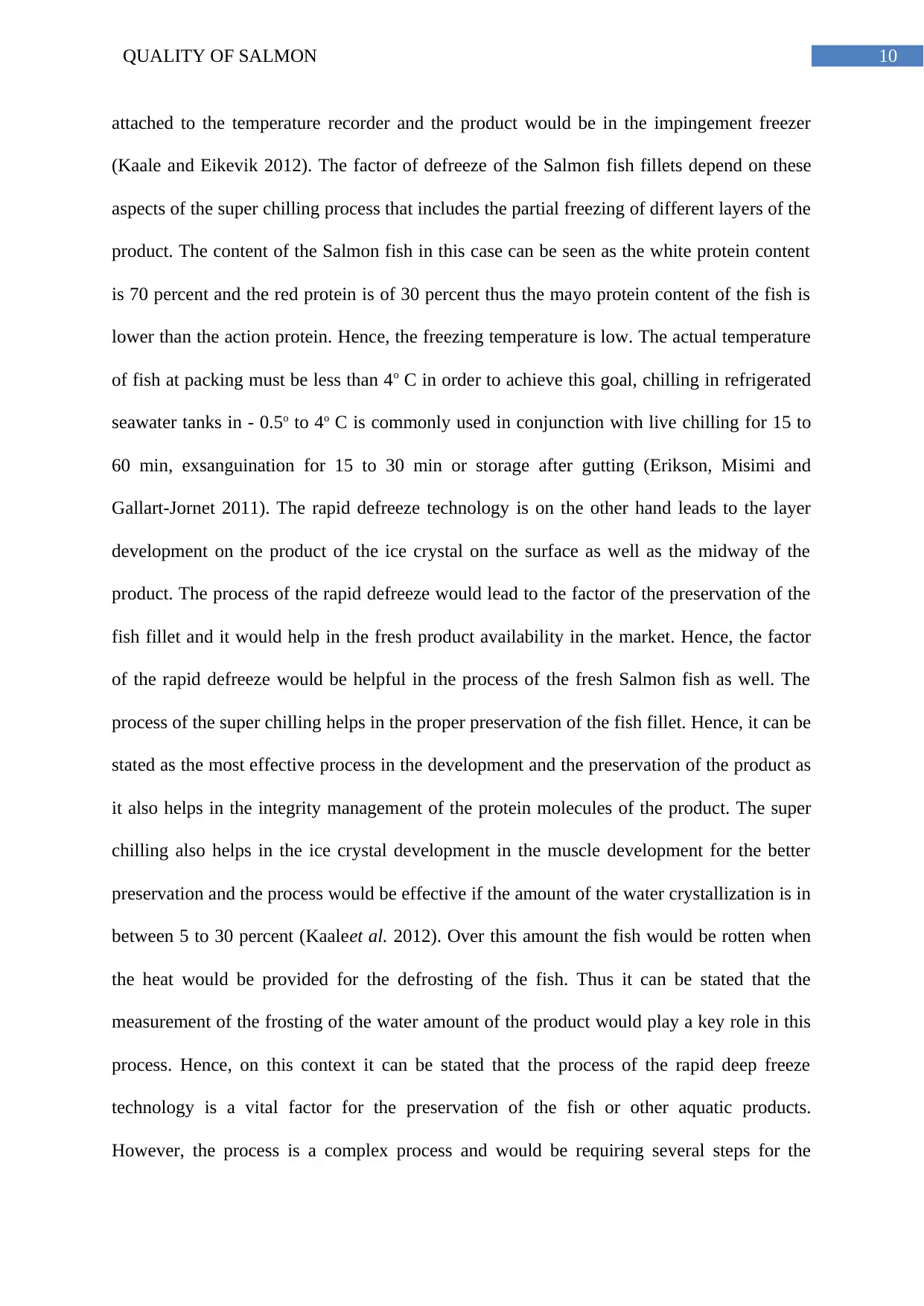
10QUALITY OF SALMON
attached to the temperature recorder and the product would be in the impingement freezer
(Kaale and Eikevik 2012). The factor of defreeze of the Salmon fish fillets depend on these
aspects of the super chilling process that includes the partial freezing of different layers of the
product. The content of the Salmon fish in this case can be seen as the white protein content
is 70 percent and the red protein is of 30 percent thus the mayo protein content of the fish is
lower than the action protein. Hence, the freezing temperature is low. The actual temperature
of fish at packing must be less than 4o C in order to achieve this goal, chilling in refrigerated
seawater tanks in - 0.5o to 4o C is commonly used in conjunction with live chilling for 15 to
60 min, exsanguination for 15 to 30 min or storage after gutting (Erikson, Misimi and
Gallart-Jornet 2011). The rapid defreeze technology is on the other hand leads to the layer
development on the product of the ice crystal on the surface as well as the midway of the
product. The process of the rapid defreeze would lead to the factor of the preservation of the
fish fillet and it would help in the fresh product availability in the market. Hence, the factor
of the rapid defreeze would be helpful in the process of the fresh Salmon fish as well. The
process of the super chilling helps in the proper preservation of the fish fillet. Hence, it can be
stated as the most effective process in the development and the preservation of the product as
it also helps in the integrity management of the protein molecules of the product. The super
chilling also helps in the ice crystal development in the muscle development for the better
preservation and the process would be effective if the amount of the water crystallization is in
between 5 to 30 percent (Kaaleet al. 2012). Over this amount the fish would be rotten when
the heat would be provided for the defrosting of the fish. Thus it can be stated that the
measurement of the frosting of the water amount of the product would play a key role in this
process. Hence, on this context it can be stated that the process of the rapid deep freeze
technology is a vital factor for the preservation of the fish or other aquatic products.
However, the process is a complex process and would be requiring several steps for the
attached to the temperature recorder and the product would be in the impingement freezer
(Kaale and Eikevik 2012). The factor of defreeze of the Salmon fish fillets depend on these
aspects of the super chilling process that includes the partial freezing of different layers of the
product. The content of the Salmon fish in this case can be seen as the white protein content
is 70 percent and the red protein is of 30 percent thus the mayo protein content of the fish is
lower than the action protein. Hence, the freezing temperature is low. The actual temperature
of fish at packing must be less than 4o C in order to achieve this goal, chilling in refrigerated
seawater tanks in - 0.5o to 4o C is commonly used in conjunction with live chilling for 15 to
60 min, exsanguination for 15 to 30 min or storage after gutting (Erikson, Misimi and
Gallart-Jornet 2011). The rapid defreeze technology is on the other hand leads to the layer
development on the product of the ice crystal on the surface as well as the midway of the
product. The process of the rapid defreeze would lead to the factor of the preservation of the
fish fillet and it would help in the fresh product availability in the market. Hence, the factor
of the rapid defreeze would be helpful in the process of the fresh Salmon fish as well. The
process of the super chilling helps in the proper preservation of the fish fillet. Hence, it can be
stated as the most effective process in the development and the preservation of the product as
it also helps in the integrity management of the protein molecules of the product. The super
chilling also helps in the ice crystal development in the muscle development for the better
preservation and the process would be effective if the amount of the water crystallization is in
between 5 to 30 percent (Kaaleet al. 2012). Over this amount the fish would be rotten when
the heat would be provided for the defrosting of the fish. Thus it can be stated that the
measurement of the frosting of the water amount of the product would play a key role in this
process. Hence, on this context it can be stated that the process of the rapid deep freeze
technology is a vital factor for the preservation of the fish or other aquatic products.
However, the process is a complex process and would be requiring several steps for the
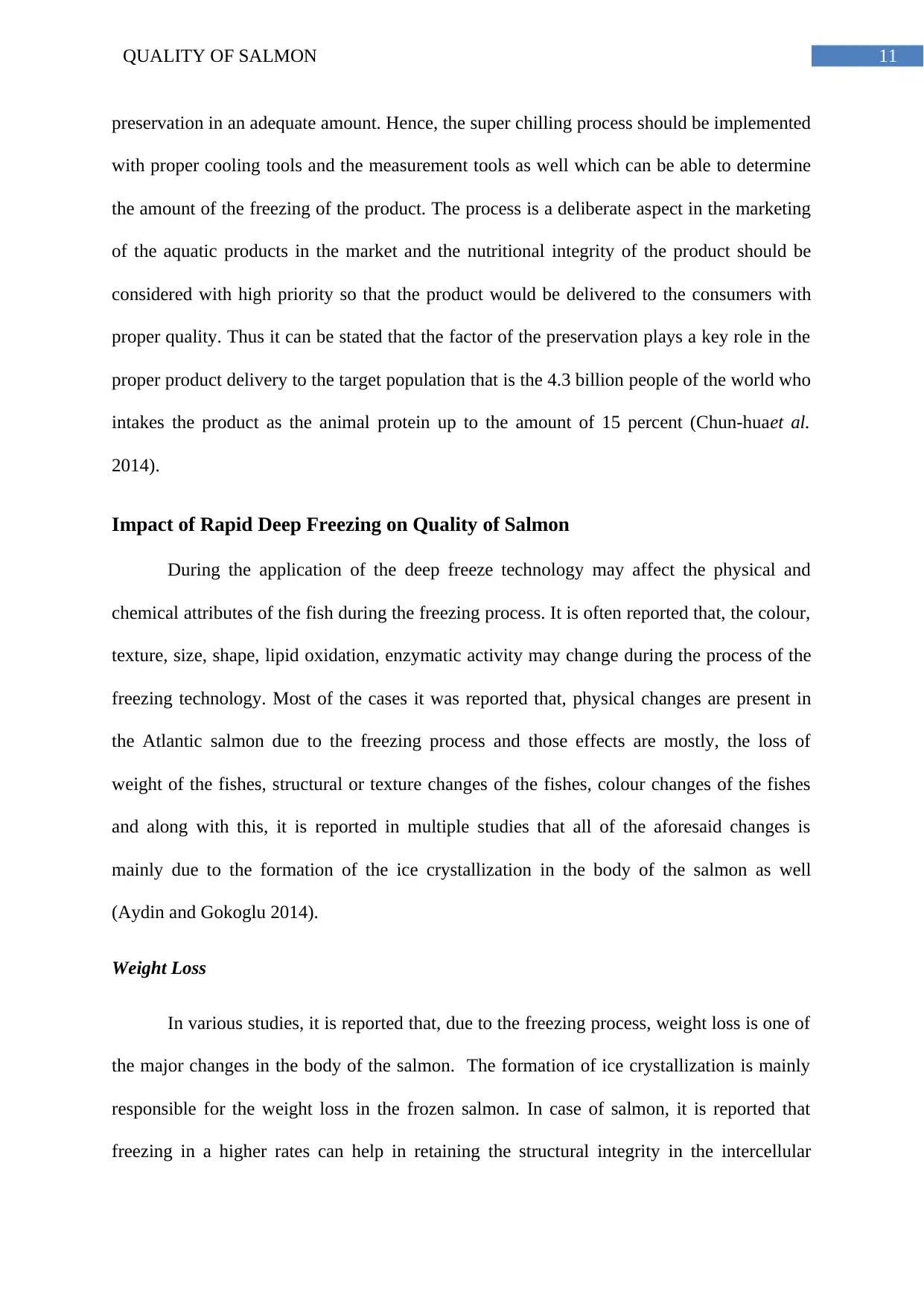
11QUALITY OF SALMON
preservation in an adequate amount. Hence, the super chilling process should be implemented
with proper cooling tools and the measurement tools as well which can be able to determine
the amount of the freezing of the product. The process is a deliberate aspect in the marketing
of the aquatic products in the market and the nutritional integrity of the product should be
considered with high priority so that the product would be delivered to the consumers with
proper quality. Thus it can be stated that the factor of the preservation plays a key role in the
proper product delivery to the target population that is the 4.3 billion people of the world who
intakes the product as the animal protein up to the amount of 15 percent (Chun-huaet al.
2014).
Impact of Rapid Deep Freezing on Quality of Salmon
During the application of the deep freeze technology may affect the physical and
chemical attributes of the fish during the freezing process. It is often reported that, the colour,
texture, size, shape, lipid oxidation, enzymatic activity may change during the process of the
freezing technology. Most of the cases it was reported that, physical changes are present in
the Atlantic salmon due to the freezing process and those effects are mostly, the loss of
weight of the fishes, structural or texture changes of the fishes, colour changes of the fishes
and along with this, it is reported in multiple studies that all of the aforesaid changes is
mainly due to the formation of the ice crystallization in the body of the salmon as well
(Aydin and Gokoglu 2014).
Weight Loss
In various studies, it is reported that, due to the freezing process, weight loss is one of
the major changes in the body of the salmon. The formation of ice crystallization is mainly
responsible for the weight loss in the frozen salmon. In case of salmon, it is reported that
freezing in a higher rates can help in retaining the structural integrity in the intercellular
preservation in an adequate amount. Hence, the super chilling process should be implemented
with proper cooling tools and the measurement tools as well which can be able to determine
the amount of the freezing of the product. The process is a deliberate aspect in the marketing
of the aquatic products in the market and the nutritional integrity of the product should be
considered with high priority so that the product would be delivered to the consumers with
proper quality. Thus it can be stated that the factor of the preservation plays a key role in the
proper product delivery to the target population that is the 4.3 billion people of the world who
intakes the product as the animal protein up to the amount of 15 percent (Chun-huaet al.
2014).
Impact of Rapid Deep Freezing on Quality of Salmon
During the application of the deep freeze technology may affect the physical and
chemical attributes of the fish during the freezing process. It is often reported that, the colour,
texture, size, shape, lipid oxidation, enzymatic activity may change during the process of the
freezing technology. Most of the cases it was reported that, physical changes are present in
the Atlantic salmon due to the freezing process and those effects are mostly, the loss of
weight of the fishes, structural or texture changes of the fishes, colour changes of the fishes
and along with this, it is reported in multiple studies that all of the aforesaid changes is
mainly due to the formation of the ice crystallization in the body of the salmon as well
(Aydin and Gokoglu 2014).
Weight Loss
In various studies, it is reported that, due to the freezing process, weight loss is one of
the major changes in the body of the salmon. The formation of ice crystallization is mainly
responsible for the weight loss in the frozen salmon. In case of salmon, it is reported that
freezing in a higher rates can help in retaining the structural integrity in the intercellular
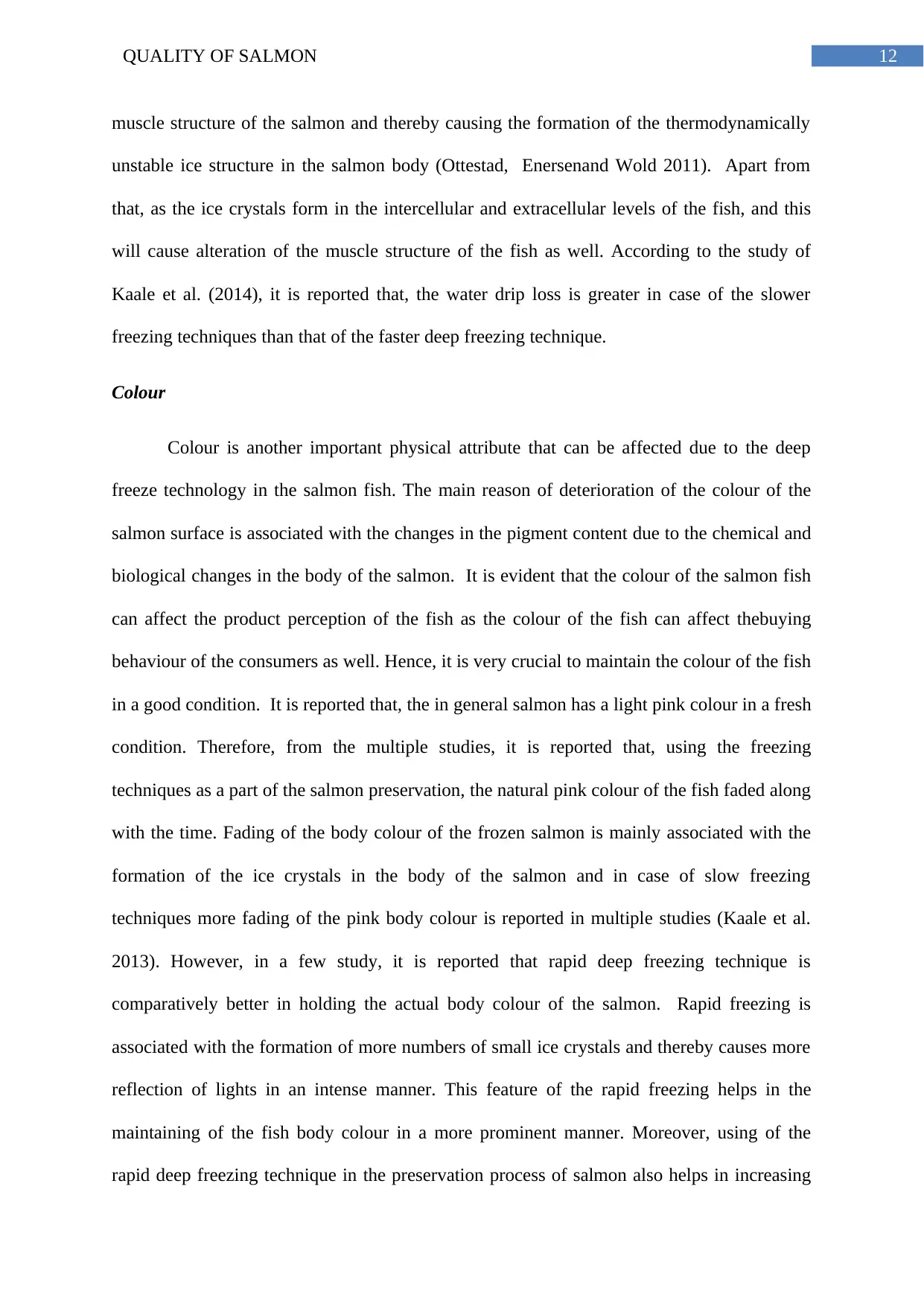
12QUALITY OF SALMON
muscle structure of the salmon and thereby causing the formation of the thermodynamically
unstable ice structure in the salmon body (Ottestad, Enersenand Wold 2011). Apart from
that, as the ice crystals form in the intercellular and extracellular levels of the fish, and this
will cause alteration of the muscle structure of the fish as well. According to the study of
Kaale et al. (2014), it is reported that, the water drip loss is greater in case of the slower
freezing techniques than that of the faster deep freezing technique.
Colour
Colour is another important physical attribute that can be affected due to the deep
freeze technology in the salmon fish. The main reason of deterioration of the colour of the
salmon surface is associated with the changes in the pigment content due to the chemical and
biological changes in the body of the salmon. It is evident that the colour of the salmon fish
can affect the product perception of the fish as the colour of the fish can affect thebuying
behaviour of the consumers as well. Hence, it is very crucial to maintain the colour of the fish
in a good condition. It is reported that, the in general salmon has a light pink colour in a fresh
condition. Therefore, from the multiple studies, it is reported that, using the freezing
techniques as a part of the salmon preservation, the natural pink colour of the fish faded along
with the time. Fading of the body colour of the frozen salmon is mainly associated with the
formation of the ice crystals in the body of the salmon and in case of slow freezing
techniques more fading of the pink body colour is reported in multiple studies (Kaale et al.
2013). However, in a few study, it is reported that rapid deep freezing technique is
comparatively better in holding the actual body colour of the salmon. Rapid freezing is
associated with the formation of more numbers of small ice crystals and thereby causes more
reflection of lights in an intense manner. This feature of the rapid freezing helps in the
maintaining of the fish body colour in a more prominent manner. Moreover, using of the
rapid deep freezing technique in the preservation process of salmon also helps in increasing
muscle structure of the salmon and thereby causing the formation of the thermodynamically
unstable ice structure in the salmon body (Ottestad, Enersenand Wold 2011). Apart from
that, as the ice crystals form in the intercellular and extracellular levels of the fish, and this
will cause alteration of the muscle structure of the fish as well. According to the study of
Kaale et al. (2014), it is reported that, the water drip loss is greater in case of the slower
freezing techniques than that of the faster deep freezing technique.
Colour
Colour is another important physical attribute that can be affected due to the deep
freeze technology in the salmon fish. The main reason of deterioration of the colour of the
salmon surface is associated with the changes in the pigment content due to the chemical and
biological changes in the body of the salmon. It is evident that the colour of the salmon fish
can affect the product perception of the fish as the colour of the fish can affect thebuying
behaviour of the consumers as well. Hence, it is very crucial to maintain the colour of the fish
in a good condition. It is reported that, the in general salmon has a light pink colour in a fresh
condition. Therefore, from the multiple studies, it is reported that, using the freezing
techniques as a part of the salmon preservation, the natural pink colour of the fish faded along
with the time. Fading of the body colour of the frozen salmon is mainly associated with the
formation of the ice crystals in the body of the salmon and in case of slow freezing
techniques more fading of the pink body colour is reported in multiple studies (Kaale et al.
2013). However, in a few study, it is reported that rapid deep freezing technique is
comparatively better in holding the actual body colour of the salmon. Rapid freezing is
associated with the formation of more numbers of small ice crystals and thereby causes more
reflection of lights in an intense manner. This feature of the rapid freezing helps in the
maintaining of the fish body colour in a more prominent manner. Moreover, using of the
rapid deep freezing technique in the preservation process of salmon also helps in increasing
Paraphrase This Document
Need a fresh take? Get an instant paraphrase of this document with our AI Paraphraser
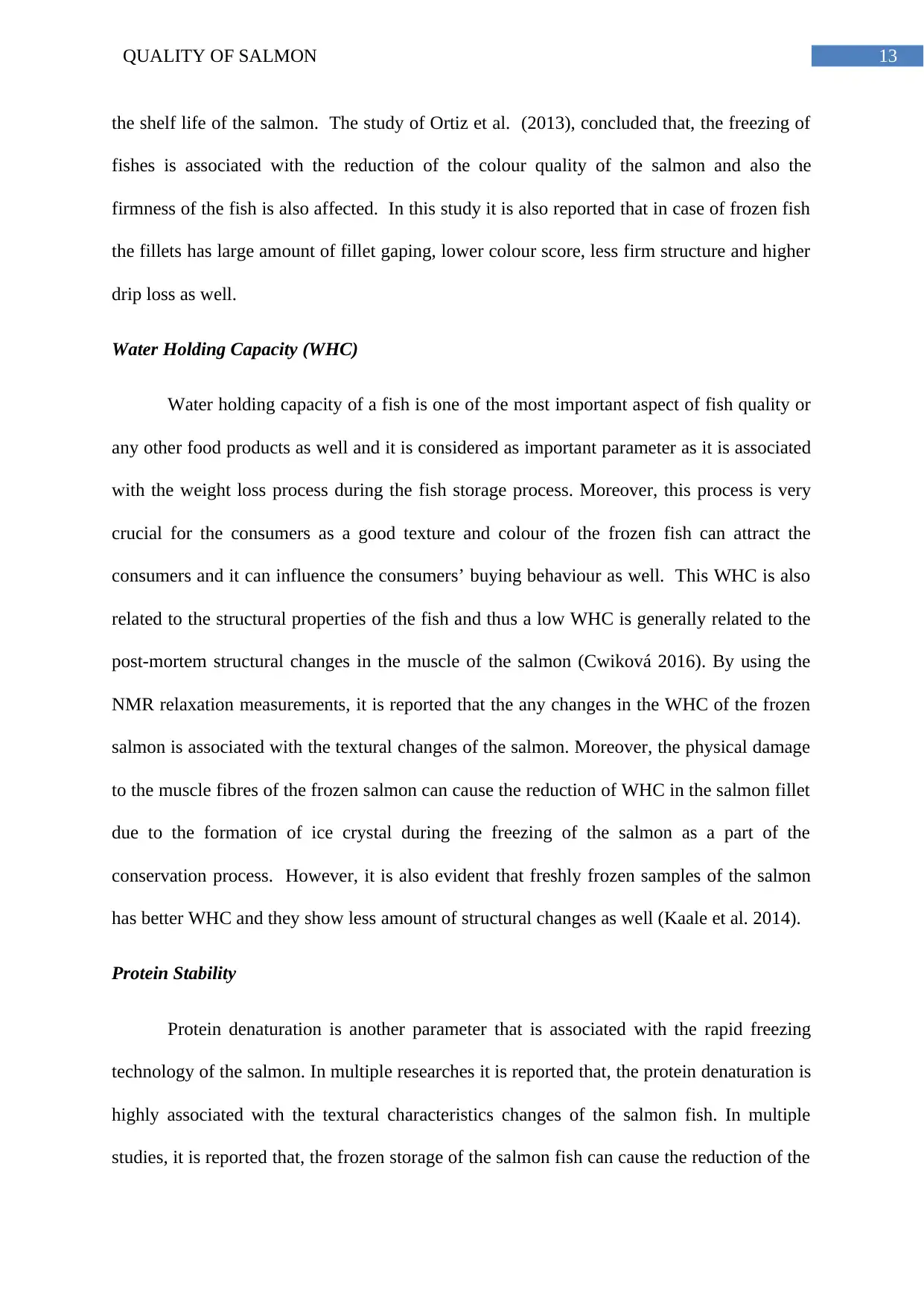
13QUALITY OF SALMON
the shelf life of the salmon. The study of Ortiz et al. (2013), concluded that, the freezing of
fishes is associated with the reduction of the colour quality of the salmon and also the
firmness of the fish is also affected. In this study it is also reported that in case of frozen fish
the fillets has large amount of fillet gaping, lower colour score, less firm structure and higher
drip loss as well.
Water Holding Capacity (WHC)
Water holding capacity of a fish is one of the most important aspect of fish quality or
any other food products as well and it is considered as important parameter as it is associated
with the weight loss process during the fish storage process. Moreover, this process is very
crucial for the consumers as a good texture and colour of the frozen fish can attract the
consumers and it can influence the consumers’ buying behaviour as well. This WHC is also
related to the structural properties of the fish and thus a low WHC is generally related to the
post-mortem structural changes in the muscle of the salmon (Cwiková 2016). By using the
NMR relaxation measurements, it is reported that the any changes in the WHC of the frozen
salmon is associated with the textural changes of the salmon. Moreover, the physical damage
to the muscle fibres of the frozen salmon can cause the reduction of WHC in the salmon fillet
due to the formation of ice crystal during the freezing of the salmon as a part of the
conservation process. However, it is also evident that freshly frozen samples of the salmon
has better WHC and they show less amount of structural changes as well (Kaale et al. 2014).
Protein Stability
Protein denaturation is another parameter that is associated with the rapid freezing
technology of the salmon. In multiple researches it is reported that, the protein denaturation is
highly associated with the textural characteristics changes of the salmon fish. In multiple
studies, it is reported that, the frozen storage of the salmon fish can cause the reduction of the
the shelf life of the salmon. The study of Ortiz et al. (2013), concluded that, the freezing of
fishes is associated with the reduction of the colour quality of the salmon and also the
firmness of the fish is also affected. In this study it is also reported that in case of frozen fish
the fillets has large amount of fillet gaping, lower colour score, less firm structure and higher
drip loss as well.
Water Holding Capacity (WHC)
Water holding capacity of a fish is one of the most important aspect of fish quality or
any other food products as well and it is considered as important parameter as it is associated
with the weight loss process during the fish storage process. Moreover, this process is very
crucial for the consumers as a good texture and colour of the frozen fish can attract the
consumers and it can influence the consumers’ buying behaviour as well. This WHC is also
related to the structural properties of the fish and thus a low WHC is generally related to the
post-mortem structural changes in the muscle of the salmon (Cwiková 2016). By using the
NMR relaxation measurements, it is reported that the any changes in the WHC of the frozen
salmon is associated with the textural changes of the salmon. Moreover, the physical damage
to the muscle fibres of the frozen salmon can cause the reduction of WHC in the salmon fillet
due to the formation of ice crystal during the freezing of the salmon as a part of the
conservation process. However, it is also evident that freshly frozen samples of the salmon
has better WHC and they show less amount of structural changes as well (Kaale et al. 2014).
Protein Stability
Protein denaturation is another parameter that is associated with the rapid freezing
technology of the salmon. In multiple researches it is reported that, the protein denaturation is
highly associated with the textural characteristics changes of the salmon fish. In multiple
studies, it is reported that, the frozen storage of the salmon fish can cause the reduction of the

14QUALITY OF SALMON
protein quality of the salmon fish and it is just because of the protein denaturation of the fish
due to freezing. Apart from, it is also reported in multiple studies, the denaturation of the
protein during the frozen storage process of the salmon can cause reduction of the protein
solubility due to the destruction of the intermolecular hydrogen or hydrophobic bonds, as
well as disulphide bonds and ionic interactions. The protein denaturation causes textural
changes as there is a change in the myofibril protein of the salmon fish as well. Along with
this, it is also evident that freezing temperature, storage temperature, temperature fluctuation
during the storage process can affect the protein denaturation process and thereby causing the
alteration of the fish structure as well (Barraza, León and Álvarez 2015). However, on the
contrary, the during the freezing process of the salmon the salt-soluble protein in the salmon
is reported to be enhanced during the freezing process of the salmon as a result of the
denaturation of the protein and enhanced excitability of the proteases. The combined activity
of the protein aggregation and protein denaturation due to freezing of the fish will reduce the
efficiency of the antioxidants (Tolstorebrov, Eikevik and Bantle 2016).
Pore Size due to Freezing
The numbers and pore size of the fishes during the freezing of the fishes again can
affect the structural quality of the salmon fish as well. The less uniform pores in the frozen
salmon can cause dehydration in the fish muscle and damaging of cell walls may cause due to
the production of ununiformed ice crystal during the freezing process. The pore numbers and
average size of the pores in the frozen fish are affected by the freezing rate of the fish as well
(Tolstorebrov, Eikevik and Bantle 2016).
Texture
Due to the freezing process of the salmon another quality parameter is affected and
that is the texture of the fish. However, this parameter is correlated with several other factors
protein quality of the salmon fish and it is just because of the protein denaturation of the fish
due to freezing. Apart from, it is also reported in multiple studies, the denaturation of the
protein during the frozen storage process of the salmon can cause reduction of the protein
solubility due to the destruction of the intermolecular hydrogen or hydrophobic bonds, as
well as disulphide bonds and ionic interactions. The protein denaturation causes textural
changes as there is a change in the myofibril protein of the salmon fish as well. Along with
this, it is also evident that freezing temperature, storage temperature, temperature fluctuation
during the storage process can affect the protein denaturation process and thereby causing the
alteration of the fish structure as well (Barraza, León and Álvarez 2015). However, on the
contrary, the during the freezing process of the salmon the salt-soluble protein in the salmon
is reported to be enhanced during the freezing process of the salmon as a result of the
denaturation of the protein and enhanced excitability of the proteases. The combined activity
of the protein aggregation and protein denaturation due to freezing of the fish will reduce the
efficiency of the antioxidants (Tolstorebrov, Eikevik and Bantle 2016).
Pore Size due to Freezing
The numbers and pore size of the fishes during the freezing of the fishes again can
affect the structural quality of the salmon fish as well. The less uniform pores in the frozen
salmon can cause dehydration in the fish muscle and damaging of cell walls may cause due to
the production of ununiformed ice crystal during the freezing process. The pore numbers and
average size of the pores in the frozen fish are affected by the freezing rate of the fish as well
(Tolstorebrov, Eikevik and Bantle 2016).
Texture
Due to the freezing process of the salmon another quality parameter is affected and
that is the texture of the fish. However, this parameter is correlated with several other factors
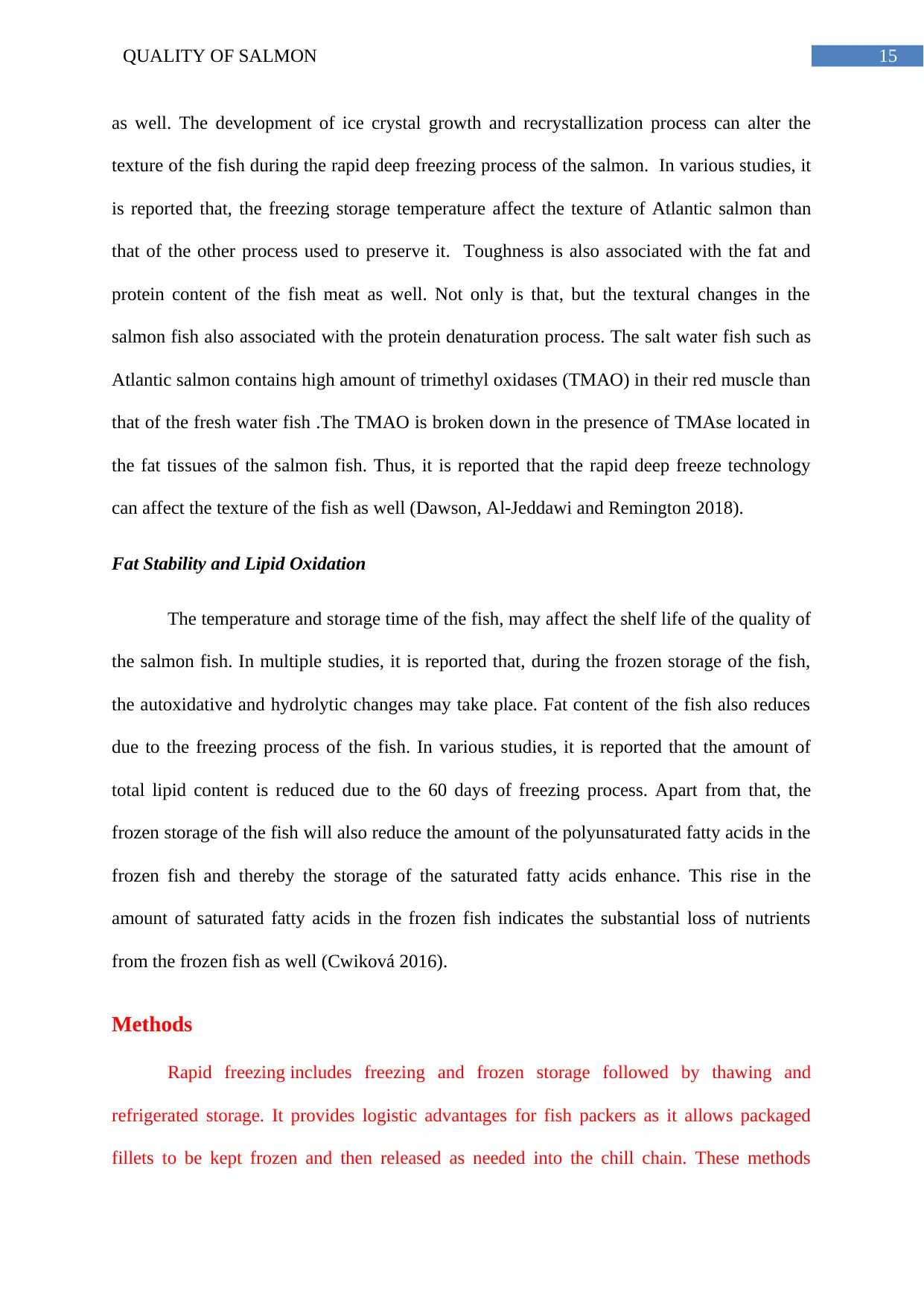
15QUALITY OF SALMON
as well. The development of ice crystal growth and recrystallization process can alter the
texture of the fish during the rapid deep freezing process of the salmon. In various studies, it
is reported that, the freezing storage temperature affect the texture of Atlantic salmon than
that of the other process used to preserve it. Toughness is also associated with the fat and
protein content of the fish meat as well. Not only is that, but the textural changes in the
salmon fish also associated with the protein denaturation process. The salt water fish such as
Atlantic salmon contains high amount of trimethyl oxidases (TMAO) in their red muscle than
that of the fresh water fish .The TMAO is broken down in the presence of TMAse located in
the fat tissues of the salmon fish. Thus, it is reported that the rapid deep freeze technology
can affect the texture of the fish as well (Dawson, Al-Jeddawi and Remington 2018).
Fat Stability and Lipid Oxidation
The temperature and storage time of the fish, may affect the shelf life of the quality of
the salmon fish. In multiple studies, it is reported that, during the frozen storage of the fish,
the autoxidative and hydrolytic changes may take place. Fat content of the fish also reduces
due to the freezing process of the fish. In various studies, it is reported that the amount of
total lipid content is reduced due to the 60 days of freezing process. Apart from that, the
frozen storage of the fish will also reduce the amount of the polyunsaturated fatty acids in the
frozen fish and thereby the storage of the saturated fatty acids enhance. This rise in the
amount of saturated fatty acids in the frozen fish indicates the substantial loss of nutrients
from the frozen fish as well (Cwiková 2016).
Methods
Rapid freezing includes freezing and frozen storage followed by thawing and
refrigerated storage. It provides logistic advantages for fish packers as it allows packaged
fillets to be kept frozen and then released as needed into the chill chain. These methods
as well. The development of ice crystal growth and recrystallization process can alter the
texture of the fish during the rapid deep freezing process of the salmon. In various studies, it
is reported that, the freezing storage temperature affect the texture of Atlantic salmon than
that of the other process used to preserve it. Toughness is also associated with the fat and
protein content of the fish meat as well. Not only is that, but the textural changes in the
salmon fish also associated with the protein denaturation process. The salt water fish such as
Atlantic salmon contains high amount of trimethyl oxidases (TMAO) in their red muscle than
that of the fresh water fish .The TMAO is broken down in the presence of TMAse located in
the fat tissues of the salmon fish. Thus, it is reported that the rapid deep freeze technology
can affect the texture of the fish as well (Dawson, Al-Jeddawi and Remington 2018).
Fat Stability and Lipid Oxidation
The temperature and storage time of the fish, may affect the shelf life of the quality of
the salmon fish. In multiple studies, it is reported that, during the frozen storage of the fish,
the autoxidative and hydrolytic changes may take place. Fat content of the fish also reduces
due to the freezing process of the fish. In various studies, it is reported that the amount of
total lipid content is reduced due to the 60 days of freezing process. Apart from that, the
frozen storage of the fish will also reduce the amount of the polyunsaturated fatty acids in the
frozen fish and thereby the storage of the saturated fatty acids enhance. This rise in the
amount of saturated fatty acids in the frozen fish indicates the substantial loss of nutrients
from the frozen fish as well (Cwiková 2016).
Methods
Rapid freezing includes freezing and frozen storage followed by thawing and
refrigerated storage. It provides logistic advantages for fish packers as it allows packaged
fillets to be kept frozen and then released as needed into the chill chain. These methods
Secure Best Marks with AI Grader
Need help grading? Try our AI Grader for instant feedback on your assignments.
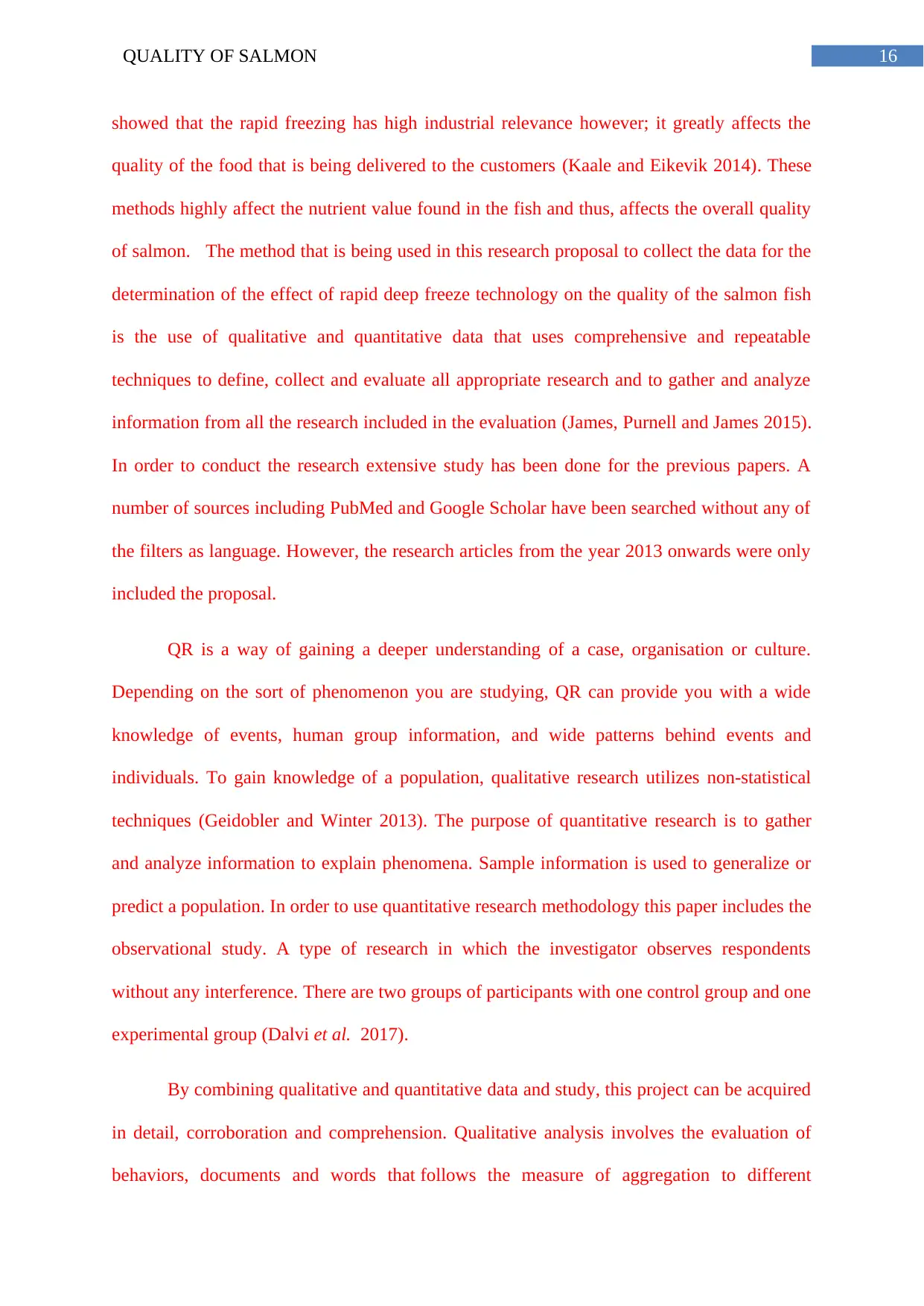
16QUALITY OF SALMON
showed that the rapid freezing has high industrial relevance however; it greatly affects the
quality of the food that is being delivered to the customers (Kaale and Eikevik 2014). These
methods highly affect the nutrient value found in the fish and thus, affects the overall quality
of salmon. The method that is being used in this research proposal to collect the data for the
determination of the effect of rapid deep freeze technology on the quality of the salmon fish
is the use of qualitative and quantitative data that uses comprehensive and repeatable
techniques to define, collect and evaluate all appropriate research and to gather and analyze
information from all the research included in the evaluation (James, Purnell and James 2015).
In order to conduct the research extensive study has been done for the previous papers. A
number of sources including PubMed and Google Scholar have been searched without any of
the filters as language. However, the research articles from the year 2013 onwards were only
included the proposal.
QR is a way of gaining a deeper understanding of a case, organisation or culture.
Depending on the sort of phenomenon you are studying, QR can provide you with a wide
knowledge of events, human group information, and wide patterns behind events and
individuals. To gain knowledge of a population, qualitative research utilizes non-statistical
techniques (Geidobler and Winter 2013). The purpose of quantitative research is to gather
and analyze information to explain phenomena. Sample information is used to generalize or
predict a population. In order to use quantitative research methodology this paper includes the
observational study. A type of research in which the investigator observes respondents
without any interference. There are two groups of participants with one control group and one
experimental group (Dalvi et al. 2017).
By combining qualitative and quantitative data and study, this project can be acquired
in detail, corroboration and comprehension. Qualitative analysis involves the evaluation of
behaviors, documents and words that follows the measure of aggregation to different
showed that the rapid freezing has high industrial relevance however; it greatly affects the
quality of the food that is being delivered to the customers (Kaale and Eikevik 2014). These
methods highly affect the nutrient value found in the fish and thus, affects the overall quality
of salmon. The method that is being used in this research proposal to collect the data for the
determination of the effect of rapid deep freeze technology on the quality of the salmon fish
is the use of qualitative and quantitative data that uses comprehensive and repeatable
techniques to define, collect and evaluate all appropriate research and to gather and analyze
information from all the research included in the evaluation (James, Purnell and James 2015).
In order to conduct the research extensive study has been done for the previous papers. A
number of sources including PubMed and Google Scholar have been searched without any of
the filters as language. However, the research articles from the year 2013 onwards were only
included the proposal.
QR is a way of gaining a deeper understanding of a case, organisation or culture.
Depending on the sort of phenomenon you are studying, QR can provide you with a wide
knowledge of events, human group information, and wide patterns behind events and
individuals. To gain knowledge of a population, qualitative research utilizes non-statistical
techniques (Geidobler and Winter 2013). The purpose of quantitative research is to gather
and analyze information to explain phenomena. Sample information is used to generalize or
predict a population. In order to use quantitative research methodology this paper includes the
observational study. A type of research in which the investigator observes respondents
without any interference. There are two groups of participants with one control group and one
experimental group (Dalvi et al. 2017).
By combining qualitative and quantitative data and study, this project can be acquired
in detail, corroboration and comprehension. Qualitative analysis involves the evaluation of
behaviors, documents and words that follows the measure of aggregation to different
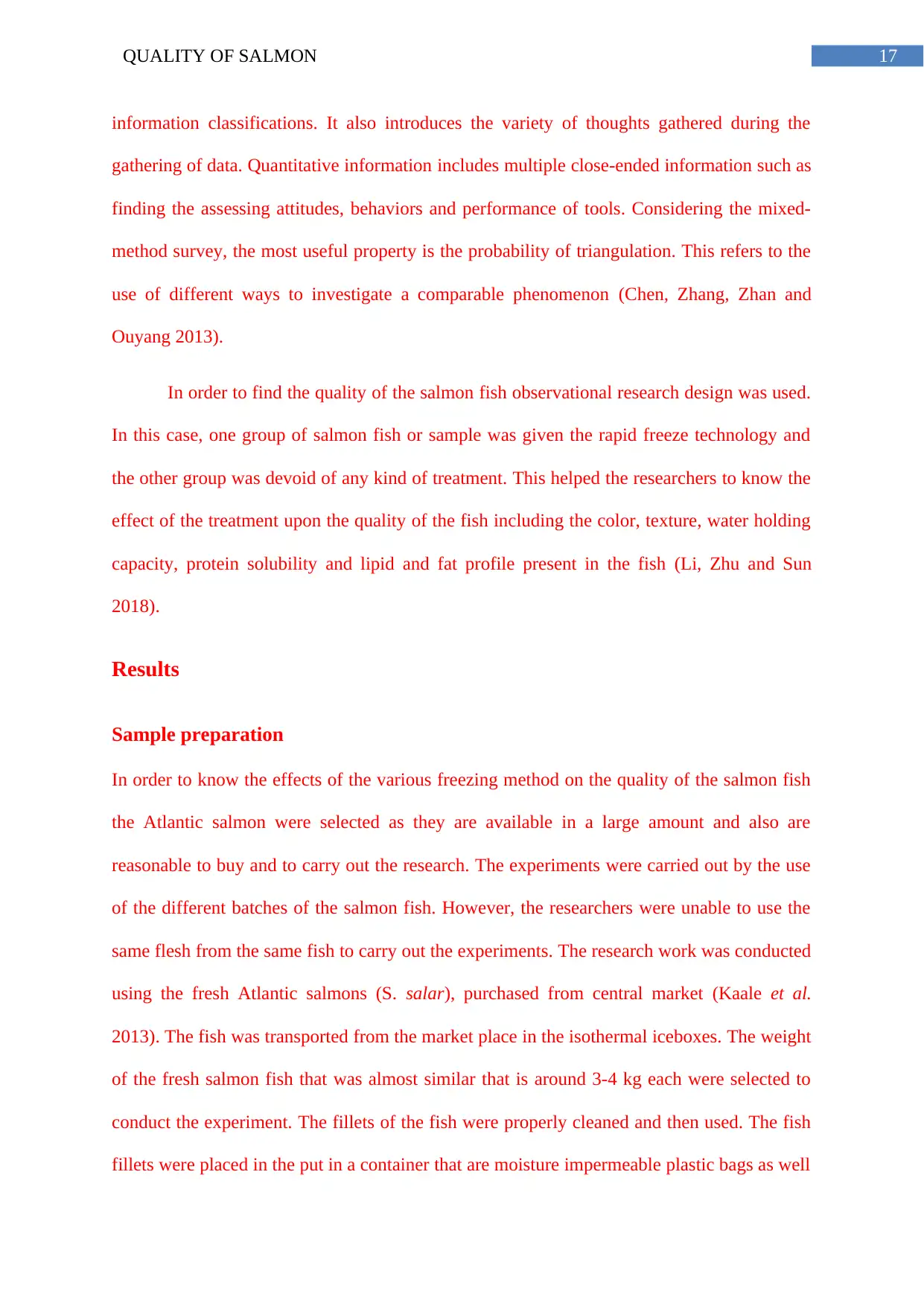
17QUALITY OF SALMON
information classifications. It also introduces the variety of thoughts gathered during the
gathering of data. Quantitative information includes multiple close-ended information such as
finding the assessing attitudes, behaviors and performance of tools. Considering the mixed-
method survey, the most useful property is the probability of triangulation. This refers to the
use of different ways to investigate a comparable phenomenon (Chen, Zhang, Zhan and
Ouyang 2013).
In order to find the quality of the salmon fish observational research design was used.
In this case, one group of salmon fish or sample was given the rapid freeze technology and
the other group was devoid of any kind of treatment. This helped the researchers to know the
effect of the treatment upon the quality of the fish including the color, texture, water holding
capacity, protein solubility and lipid and fat profile present in the fish (Li, Zhu and Sun
2018).
Results
Sample preparation
In order to know the effects of the various freezing method on the quality of the salmon fish
the Atlantic salmon were selected as they are available in a large amount and also are
reasonable to buy and to carry out the research. The experiments were carried out by the use
of the different batches of the salmon fish. However, the researchers were unable to use the
same flesh from the same fish to carry out the experiments. The research work was conducted
using the fresh Atlantic salmons (S. salar), purchased from central market (Kaale et al.
2013). The fish was transported from the market place in the isothermal iceboxes. The weight
of the fresh salmon fish that was almost similar that is around 3-4 kg each were selected to
conduct the experiment. The fillets of the fish were properly cleaned and then used. The fish
fillets were placed in the put in a container that are moisture impermeable plastic bags as well
information classifications. It also introduces the variety of thoughts gathered during the
gathering of data. Quantitative information includes multiple close-ended information such as
finding the assessing attitudes, behaviors and performance of tools. Considering the mixed-
method survey, the most useful property is the probability of triangulation. This refers to the
use of different ways to investigate a comparable phenomenon (Chen, Zhang, Zhan and
Ouyang 2013).
In order to find the quality of the salmon fish observational research design was used.
In this case, one group of salmon fish or sample was given the rapid freeze technology and
the other group was devoid of any kind of treatment. This helped the researchers to know the
effect of the treatment upon the quality of the fish including the color, texture, water holding
capacity, protein solubility and lipid and fat profile present in the fish (Li, Zhu and Sun
2018).
Results
Sample preparation
In order to know the effects of the various freezing method on the quality of the salmon fish
the Atlantic salmon were selected as they are available in a large amount and also are
reasonable to buy and to carry out the research. The experiments were carried out by the use
of the different batches of the salmon fish. However, the researchers were unable to use the
same flesh from the same fish to carry out the experiments. The research work was conducted
using the fresh Atlantic salmons (S. salar), purchased from central market (Kaale et al.
2013). The fish was transported from the market place in the isothermal iceboxes. The weight
of the fresh salmon fish that was almost similar that is around 3-4 kg each were selected to
conduct the experiment. The fillets of the fish were properly cleaned and then used. The fish
fillets were placed in the put in a container that are moisture impermeable plastic bags as well
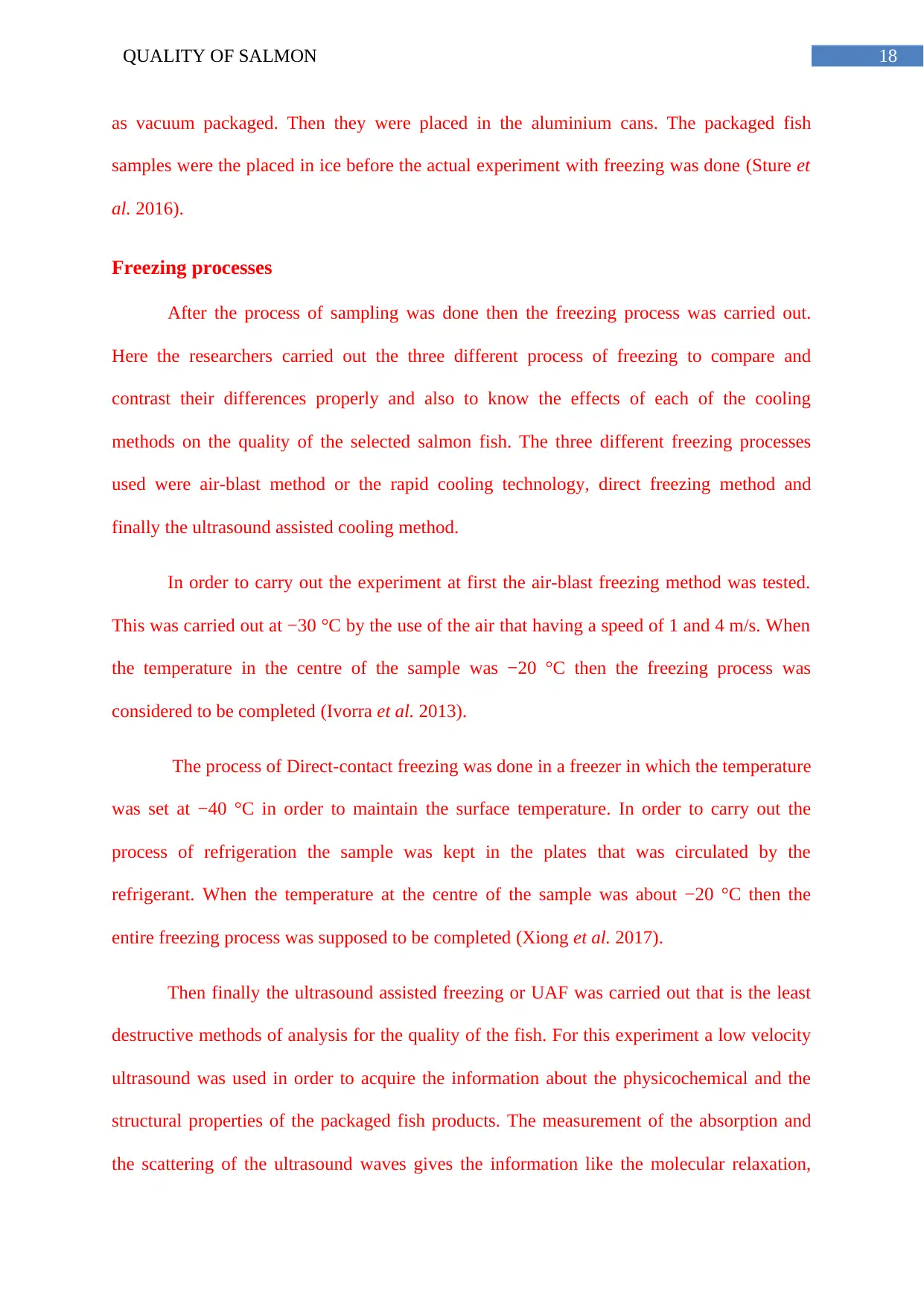
18QUALITY OF SALMON
as vacuum packaged. Then they were placed in the aluminium cans. The packaged fish
samples were the placed in ice before the actual experiment with freezing was done (Sture et
al. 2016).
Freezing processes
After the process of sampling was done then the freezing process was carried out.
Here the researchers carried out the three different process of freezing to compare and
contrast their differences properly and also to know the effects of each of the cooling
methods on the quality of the selected salmon fish. The three different freezing processes
used were air-blast method or the rapid cooling technology, direct freezing method and
finally the ultrasound assisted cooling method.
In order to carry out the experiment at first the air-blast freezing method was tested.
This was carried out at −30 °C by the use of the air that having a speed of 1 and 4 m/s. When
the temperature in the centre of the sample was −20 °C then the freezing process was
considered to be completed (Ivorra et al. 2013).
The process of Direct-contact freezing was done in a freezer in which the temperature
was set at −40 °C in order to maintain the surface temperature. In order to carry out the
process of refrigeration the sample was kept in the plates that was circulated by the
refrigerant. When the temperature at the centre of the sample was about −20 °C then the
entire freezing process was supposed to be completed (Xiong et al. 2017).
Then finally the ultrasound assisted freezing or UAF was carried out that is the least
destructive methods of analysis for the quality of the fish. For this experiment a low velocity
ultrasound was used in order to acquire the information about the physicochemical and the
structural properties of the packaged fish products. The measurement of the absorption and
the scattering of the ultrasound waves gives the information like the molecular relaxation,
as vacuum packaged. Then they were placed in the aluminium cans. The packaged fish
samples were the placed in ice before the actual experiment with freezing was done (Sture et
al. 2016).
Freezing processes
After the process of sampling was done then the freezing process was carried out.
Here the researchers carried out the three different process of freezing to compare and
contrast their differences properly and also to know the effects of each of the cooling
methods on the quality of the selected salmon fish. The three different freezing processes
used were air-blast method or the rapid cooling technology, direct freezing method and
finally the ultrasound assisted cooling method.
In order to carry out the experiment at first the air-blast freezing method was tested.
This was carried out at −30 °C by the use of the air that having a speed of 1 and 4 m/s. When
the temperature in the centre of the sample was −20 °C then the freezing process was
considered to be completed (Ivorra et al. 2013).
The process of Direct-contact freezing was done in a freezer in which the temperature
was set at −40 °C in order to maintain the surface temperature. In order to carry out the
process of refrigeration the sample was kept in the plates that was circulated by the
refrigerant. When the temperature at the centre of the sample was about −20 °C then the
entire freezing process was supposed to be completed (Xiong et al. 2017).
Then finally the ultrasound assisted freezing or UAF was carried out that is the least
destructive methods of analysis for the quality of the fish. For this experiment a low velocity
ultrasound was used in order to acquire the information about the physicochemical and the
structural properties of the packaged fish products. The measurement of the absorption and
the scattering of the ultrasound waves gives the information like the molecular relaxation,
Paraphrase This Document
Need a fresh take? Get an instant paraphrase of this document with our AI Paraphraser
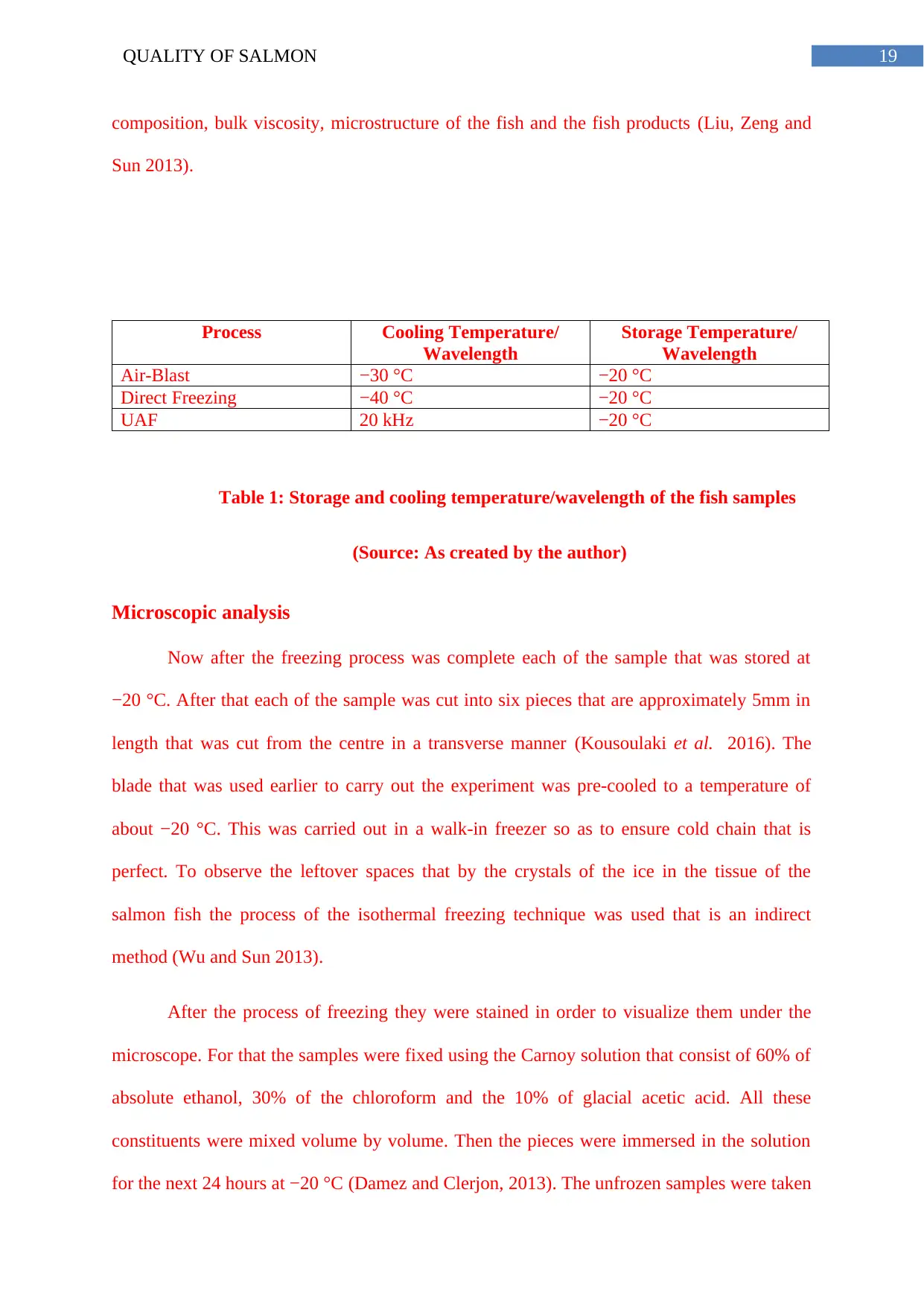
19QUALITY OF SALMON
composition, bulk viscosity, microstructure of the fish and the fish products (Liu, Zeng and
Sun 2013).
Process Cooling Temperature/
Wavelength
Storage Temperature/
Wavelength
Air-Blast −30 °C −20 °C
Direct Freezing −40 °C −20 °C
UAF 20 kHz −20 °C
Table 1: Storage and cooling temperature/wavelength of the fish samples
(Source: As created by the author)
Microscopic analysis
Now after the freezing process was complete each of the sample that was stored at
−20 °C. After that each of the sample was cut into six pieces that are approximately 5mm in
length that was cut from the centre in a transverse manner (Kousoulaki et al. 2016). The
blade that was used earlier to carry out the experiment was pre-cooled to a temperature of
about −20 °C. This was carried out in a walk-in freezer so as to ensure cold chain that is
perfect. To observe the leftover spaces that by the crystals of the ice in the tissue of the
salmon fish the process of the isothermal freezing technique was used that is an indirect
method (Wu and Sun 2013).
After the process of freezing they were stained in order to visualize them under the
microscope. For that the samples were fixed using the Carnoy solution that consist of 60% of
absolute ethanol, 30% of the chloroform and the 10% of glacial acetic acid. All these
constituents were mixed volume by volume. Then the pieces were immersed in the solution
for the next 24 hours at −20 °C (Damez and Clerjon, 2013). The unfrozen samples were taken
composition, bulk viscosity, microstructure of the fish and the fish products (Liu, Zeng and
Sun 2013).
Process Cooling Temperature/
Wavelength
Storage Temperature/
Wavelength
Air-Blast −30 °C −20 °C
Direct Freezing −40 °C −20 °C
UAF 20 kHz −20 °C
Table 1: Storage and cooling temperature/wavelength of the fish samples
(Source: As created by the author)
Microscopic analysis
Now after the freezing process was complete each of the sample that was stored at
−20 °C. After that each of the sample was cut into six pieces that are approximately 5mm in
length that was cut from the centre in a transverse manner (Kousoulaki et al. 2016). The
blade that was used earlier to carry out the experiment was pre-cooled to a temperature of
about −20 °C. This was carried out in a walk-in freezer so as to ensure cold chain that is
perfect. To observe the leftover spaces that by the crystals of the ice in the tissue of the
salmon fish the process of the isothermal freezing technique was used that is an indirect
method (Wu and Sun 2013).
After the process of freezing they were stained in order to visualize them under the
microscope. For that the samples were fixed using the Carnoy solution that consist of 60% of
absolute ethanol, 30% of the chloroform and the 10% of glacial acetic acid. All these
constituents were mixed volume by volume. Then the pieces were immersed in the solution
for the next 24 hours at −20 °C (Damez and Clerjon, 2013). The unfrozen samples were taken
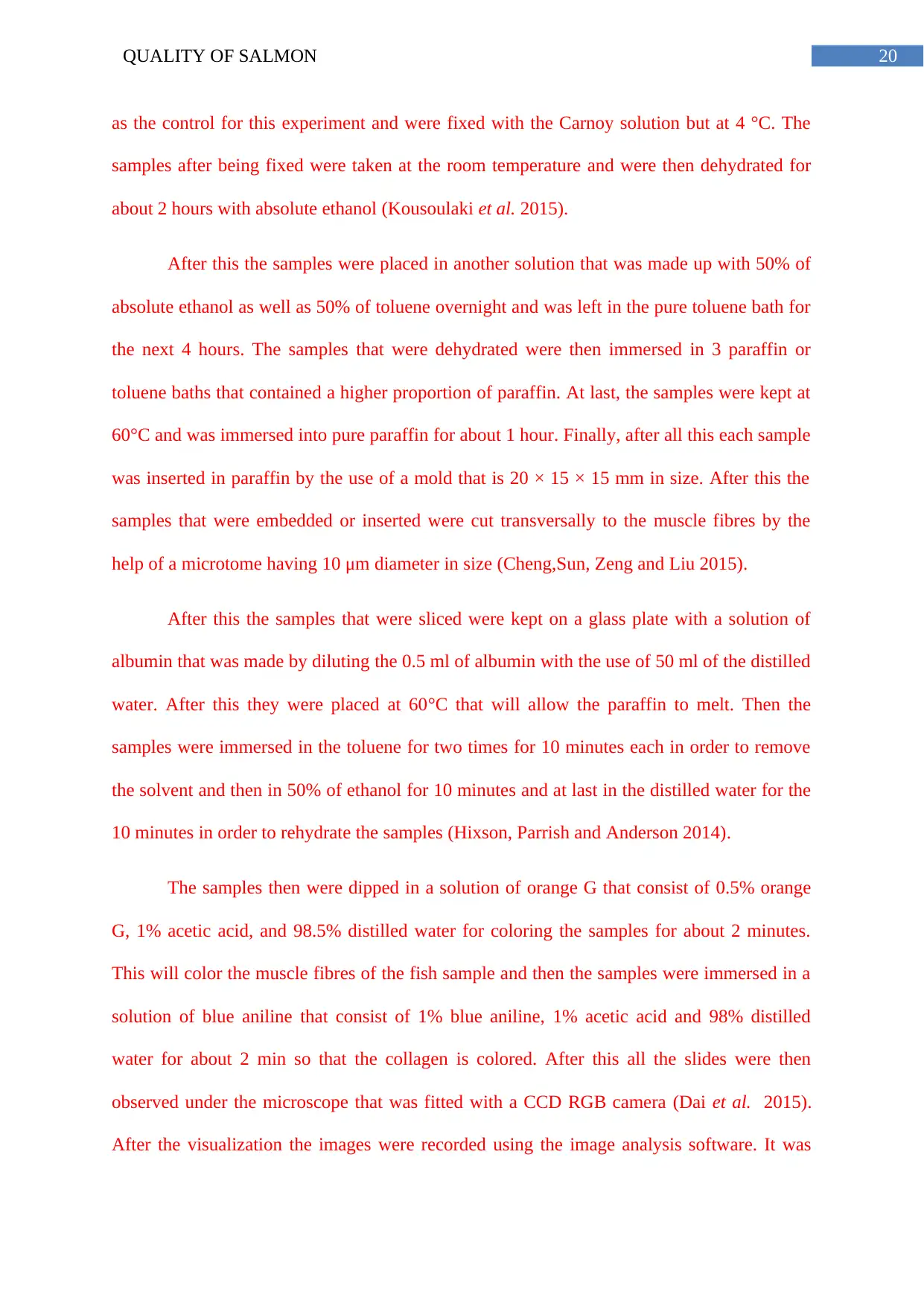
20QUALITY OF SALMON
as the control for this experiment and were fixed with the Carnoy solution but at 4 °C. The
samples after being fixed were taken at the room temperature and were then dehydrated for
about 2 hours with absolute ethanol (Kousoulaki et al. 2015).
After this the samples were placed in another solution that was made up with 50% of
absolute ethanol as well as 50% of toluene overnight and was left in the pure toluene bath for
the next 4 hours. The samples that were dehydrated were then immersed in 3 paraffin or
toluene baths that contained a higher proportion of paraffin. At last, the samples were kept at
60°C and was immersed into pure paraffin for about 1 hour. Finally, after all this each sample
was inserted in paraffin by the use of a mold that is 20 × 15 × 15 mm in size. After this the
samples that were embedded or inserted were cut transversally to the muscle fibres by the
help of a microtome having 10 μm diameter in size (Cheng,Sun, Zeng and Liu 2015).
After this the samples that were sliced were kept on a glass plate with a solution of
albumin that was made by diluting the 0.5 ml of albumin with the use of 50 ml of the distilled
water. After this they were placed at 60°C that will allow the paraffin to melt. Then the
samples were immersed in the toluene for two times for 10 minutes each in order to remove
the solvent and then in 50% of ethanol for 10 minutes and at last in the distilled water for the
10 minutes in order to rehydrate the samples (Hixson, Parrish and Anderson 2014).
The samples then were dipped in a solution of orange G that consist of 0.5% orange
G, 1% acetic acid, and 98.5% distilled water for coloring the samples for about 2 minutes.
This will color the muscle fibres of the fish sample and then the samples were immersed in a
solution of blue aniline that consist of 1% blue aniline, 1% acetic acid and 98% distilled
water for about 2 min so that the collagen is colored. After this all the slides were then
observed under the microscope that was fitted with a CCD RGB camera (Dai et al. 2015).
After the visualization the images were recorded using the image analysis software. It was
as the control for this experiment and were fixed with the Carnoy solution but at 4 °C. The
samples after being fixed were taken at the room temperature and were then dehydrated for
about 2 hours with absolute ethanol (Kousoulaki et al. 2015).
After this the samples were placed in another solution that was made up with 50% of
absolute ethanol as well as 50% of toluene overnight and was left in the pure toluene bath for
the next 4 hours. The samples that were dehydrated were then immersed in 3 paraffin or
toluene baths that contained a higher proportion of paraffin. At last, the samples were kept at
60°C and was immersed into pure paraffin for about 1 hour. Finally, after all this each sample
was inserted in paraffin by the use of a mold that is 20 × 15 × 15 mm in size. After this the
samples that were embedded or inserted were cut transversally to the muscle fibres by the
help of a microtome having 10 μm diameter in size (Cheng,Sun, Zeng and Liu 2015).
After this the samples that were sliced were kept on a glass plate with a solution of
albumin that was made by diluting the 0.5 ml of albumin with the use of 50 ml of the distilled
water. After this they were placed at 60°C that will allow the paraffin to melt. Then the
samples were immersed in the toluene for two times for 10 minutes each in order to remove
the solvent and then in 50% of ethanol for 10 minutes and at last in the distilled water for the
10 minutes in order to rehydrate the samples (Hixson, Parrish and Anderson 2014).
The samples then were dipped in a solution of orange G that consist of 0.5% orange
G, 1% acetic acid, and 98.5% distilled water for coloring the samples for about 2 minutes.
This will color the muscle fibres of the fish sample and then the samples were immersed in a
solution of blue aniline that consist of 1% blue aniline, 1% acetic acid and 98% distilled
water for about 2 min so that the collagen is colored. After this all the slides were then
observed under the microscope that was fitted with a CCD RGB camera (Dai et al. 2015).
After the visualization the images were recorded using the image analysis software. It was

21QUALITY OF SALMON
seen that the spatial measurements of the fish fillets were taken for the process of analysis
and evaluation (Ortiz, Vivanco and Aubourg 2014).
Solutions used Components
Carnoy Solution 60% of absolute ethanol, 30% of the
chloroform and the 10% of glacial acetic acid
Albumin Solution 0.5 ml of albumin with the use of 50 ml of
the distilled water
Orange G 0.5% orange G, 1% acetic acid, and 98.5%
distilled water
Blue Aniline 1% blue aniline, 1% acetic acid and 98%
distilled water
Table 2: Solution Used for Microscopy
(Source: As created by the author)
Fig 1: Temperature and the surface and the centre of the sample
Discussion
Around 20 years earlier, the first research on ultrasound aided freezing can be traced
back. A big number of researches have been released since then, confirming the improvement
by sonication of freezing. The way ultrasound is performed on a liquid medium is based on
the impact of acoustic cavitation and micro-streaming produced by cavitation bubbles
rupture, which helps to create a greater degree of under-cooling (Kamruzzaman, Makino and
Oshita 2015). Small cavitation bubbles promote ice nucleation, particularly in main
nucleation, by offering many ice nucleation locations. In addition, the improvement of heat
seen that the spatial measurements of the fish fillets were taken for the process of analysis
and evaluation (Ortiz, Vivanco and Aubourg 2014).
Solutions used Components
Carnoy Solution 60% of absolute ethanol, 30% of the
chloroform and the 10% of glacial acetic acid
Albumin Solution 0.5 ml of albumin with the use of 50 ml of
the distilled water
Orange G 0.5% orange G, 1% acetic acid, and 98.5%
distilled water
Blue Aniline 1% blue aniline, 1% acetic acid and 98%
distilled water
Table 2: Solution Used for Microscopy
(Source: As created by the author)
Fig 1: Temperature and the surface and the centre of the sample
Discussion
Around 20 years earlier, the first research on ultrasound aided freezing can be traced
back. A big number of researches have been released since then, confirming the improvement
by sonication of freezing. The way ultrasound is performed on a liquid medium is based on
the impact of acoustic cavitation and micro-streaming produced by cavitation bubbles
rupture, which helps to create a greater degree of under-cooling (Kamruzzaman, Makino and
Oshita 2015). Small cavitation bubbles promote ice nucleation, particularly in main
nucleation, by offering many ice nucleation locations. In addition, the improvement of heat
Secure Best Marks with AI Grader
Need help grading? Try our AI Grader for instant feedback on your assignments.
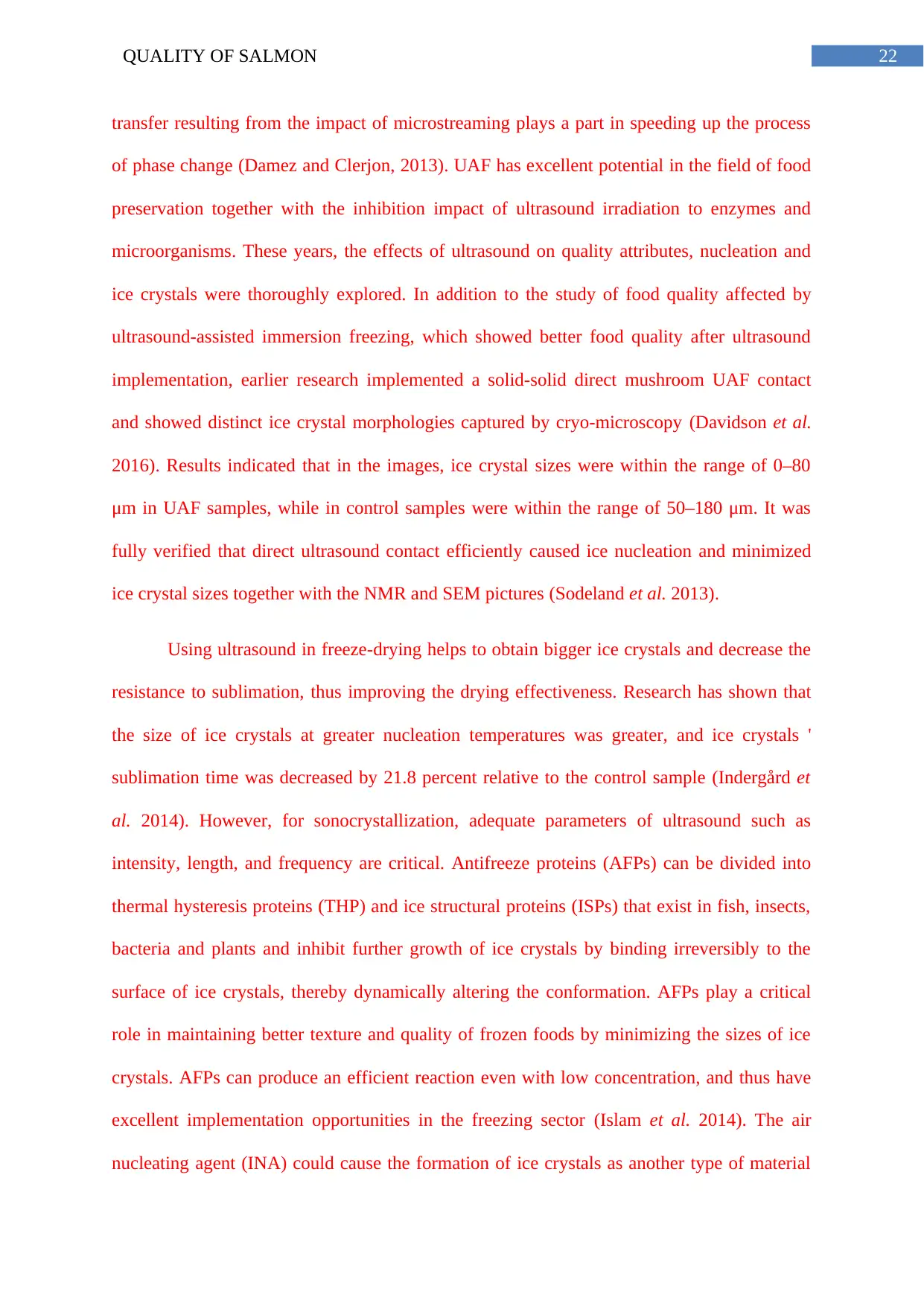
22QUALITY OF SALMON
transfer resulting from the impact of microstreaming plays a part in speeding up the process
of phase change (Damez and Clerjon, 2013). UAF has excellent potential in the field of food
preservation together with the inhibition impact of ultrasound irradiation to enzymes and
microorganisms. These years, the effects of ultrasound on quality attributes, nucleation and
ice crystals were thoroughly explored. In addition to the study of food quality affected by
ultrasound-assisted immersion freezing, which showed better food quality after ultrasound
implementation, earlier research implemented a solid-solid direct mushroom UAF contact
and showed distinct ice crystal morphologies captured by cryo-microscopy (Davidson et al.
2016). Results indicated that in the images, ice crystal sizes were within the range of 0–80
μm in UAF samples, while in control samples were within the range of 50–180 μm. It was
fully verified that direct ultrasound contact efficiently caused ice nucleation and minimized
ice crystal sizes together with the NMR and SEM pictures (Sodeland et al. 2013).
Using ultrasound in freeze-drying helps to obtain bigger ice crystals and decrease the
resistance to sublimation, thus improving the drying effectiveness. Research has shown that
the size of ice crystals at greater nucleation temperatures was greater, and ice crystals '
sublimation time was decreased by 21.8 percent relative to the control sample (Indergård et
al. 2014). However, for sonocrystallization, adequate parameters of ultrasound such as
intensity, length, and frequency are critical. Antifreeze proteins (AFPs) can be divided into
thermal hysteresis proteins (THP) and ice structural proteins (ISPs) that exist in fish, insects,
bacteria and plants and inhibit further growth of ice crystals by binding irreversibly to the
surface of ice crystals, thereby dynamically altering the conformation. AFPs play a critical
role in maintaining better texture and quality of frozen foods by minimizing the sizes of ice
crystals. AFPs can produce an efficient reaction even with low concentration, and thus have
excellent implementation opportunities in the freezing sector (Islam et al. 2014). The air
nucleating agent (INA) could cause the formation of ice crystals as another type of material
transfer resulting from the impact of microstreaming plays a part in speeding up the process
of phase change (Damez and Clerjon, 2013). UAF has excellent potential in the field of food
preservation together with the inhibition impact of ultrasound irradiation to enzymes and
microorganisms. These years, the effects of ultrasound on quality attributes, nucleation and
ice crystals were thoroughly explored. In addition to the study of food quality affected by
ultrasound-assisted immersion freezing, which showed better food quality after ultrasound
implementation, earlier research implemented a solid-solid direct mushroom UAF contact
and showed distinct ice crystal morphologies captured by cryo-microscopy (Davidson et al.
2016). Results indicated that in the images, ice crystal sizes were within the range of 0–80
μm in UAF samples, while in control samples were within the range of 50–180 μm. It was
fully verified that direct ultrasound contact efficiently caused ice nucleation and minimized
ice crystal sizes together with the NMR and SEM pictures (Sodeland et al. 2013).
Using ultrasound in freeze-drying helps to obtain bigger ice crystals and decrease the
resistance to sublimation, thus improving the drying effectiveness. Research has shown that
the size of ice crystals at greater nucleation temperatures was greater, and ice crystals '
sublimation time was decreased by 21.8 percent relative to the control sample (Indergård et
al. 2014). However, for sonocrystallization, adequate parameters of ultrasound such as
intensity, length, and frequency are critical. Antifreeze proteins (AFPs) can be divided into
thermal hysteresis proteins (THP) and ice structural proteins (ISPs) that exist in fish, insects,
bacteria and plants and inhibit further growth of ice crystals by binding irreversibly to the
surface of ice crystals, thereby dynamically altering the conformation. AFPs play a critical
role in maintaining better texture and quality of frozen foods by minimizing the sizes of ice
crystals. AFPs can produce an efficient reaction even with low concentration, and thus have
excellent implementation opportunities in the freezing sector (Islam et al. 2014). The air
nucleating agent (INA) could cause the formation of ice crystals as another type of material
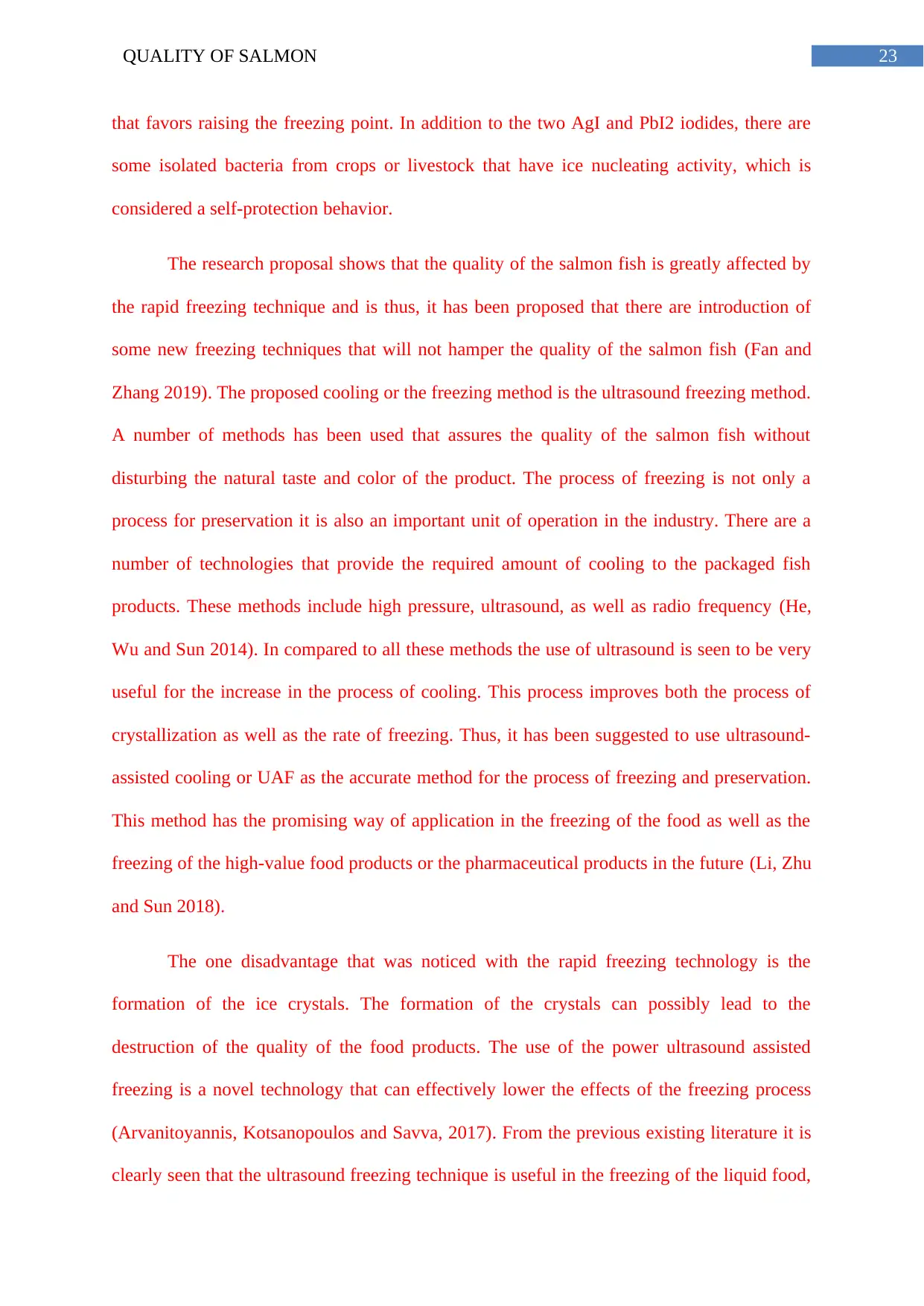
23QUALITY OF SALMON
that favors raising the freezing point. In addition to the two AgI and PbI2 iodides, there are
some isolated bacteria from crops or livestock that have ice nucleating activity, which is
considered a self-protection behavior.
The research proposal shows that the quality of the salmon fish is greatly affected by
the rapid freezing technique and is thus, it has been proposed that there are introduction of
some new freezing techniques that will not hamper the quality of the salmon fish (Fan and
Zhang 2019). The proposed cooling or the freezing method is the ultrasound freezing method.
A number of methods has been used that assures the quality of the salmon fish without
disturbing the natural taste and color of the product. The process of freezing is not only a
process for preservation it is also an important unit of operation in the industry. There are a
number of technologies that provide the required amount of cooling to the packaged fish
products. These methods include high pressure, ultrasound, as well as radio frequency (He,
Wu and Sun 2014). In compared to all these methods the use of ultrasound is seen to be very
useful for the increase in the process of cooling. This process improves both the process of
crystallization as well as the rate of freezing. Thus, it has been suggested to use ultrasound-
assisted cooling or UAF as the accurate method for the process of freezing and preservation.
This method has the promising way of application in the freezing of the food as well as the
freezing of the high-value food products or the pharmaceutical products in the future (Li, Zhu
and Sun 2018).
The one disadvantage that was noticed with the rapid freezing technology is the
formation of the ice crystals. The formation of the crystals can possibly lead to the
destruction of the quality of the food products. The use of the power ultrasound assisted
freezing is a novel technology that can effectively lower the effects of the freezing process
(Arvanitoyannis, Kotsanopoulos and Savva, 2017). From the previous existing literature it is
clearly seen that the ultrasound freezing technique is useful in the freezing of the liquid food,
that favors raising the freezing point. In addition to the two AgI and PbI2 iodides, there are
some isolated bacteria from crops or livestock that have ice nucleating activity, which is
considered a self-protection behavior.
The research proposal shows that the quality of the salmon fish is greatly affected by
the rapid freezing technique and is thus, it has been proposed that there are introduction of
some new freezing techniques that will not hamper the quality of the salmon fish (Fan and
Zhang 2019). The proposed cooling or the freezing method is the ultrasound freezing method.
A number of methods has been used that assures the quality of the salmon fish without
disturbing the natural taste and color of the product. The process of freezing is not only a
process for preservation it is also an important unit of operation in the industry. There are a
number of technologies that provide the required amount of cooling to the packaged fish
products. These methods include high pressure, ultrasound, as well as radio frequency (He,
Wu and Sun 2014). In compared to all these methods the use of ultrasound is seen to be very
useful for the increase in the process of cooling. This process improves both the process of
crystallization as well as the rate of freezing. Thus, it has been suggested to use ultrasound-
assisted cooling or UAF as the accurate method for the process of freezing and preservation.
This method has the promising way of application in the freezing of the food as well as the
freezing of the high-value food products or the pharmaceutical products in the future (Li, Zhu
and Sun 2018).
The one disadvantage that was noticed with the rapid freezing technology is the
formation of the ice crystals. The formation of the crystals can possibly lead to the
destruction of the quality of the food products. The use of the power ultrasound assisted
freezing is a novel technology that can effectively lower the effects of the freezing process
(Arvanitoyannis, Kotsanopoulos and Savva, 2017). From the previous existing literature it is
clearly seen that the ultrasound freezing technique is useful in the freezing of the liquid food,
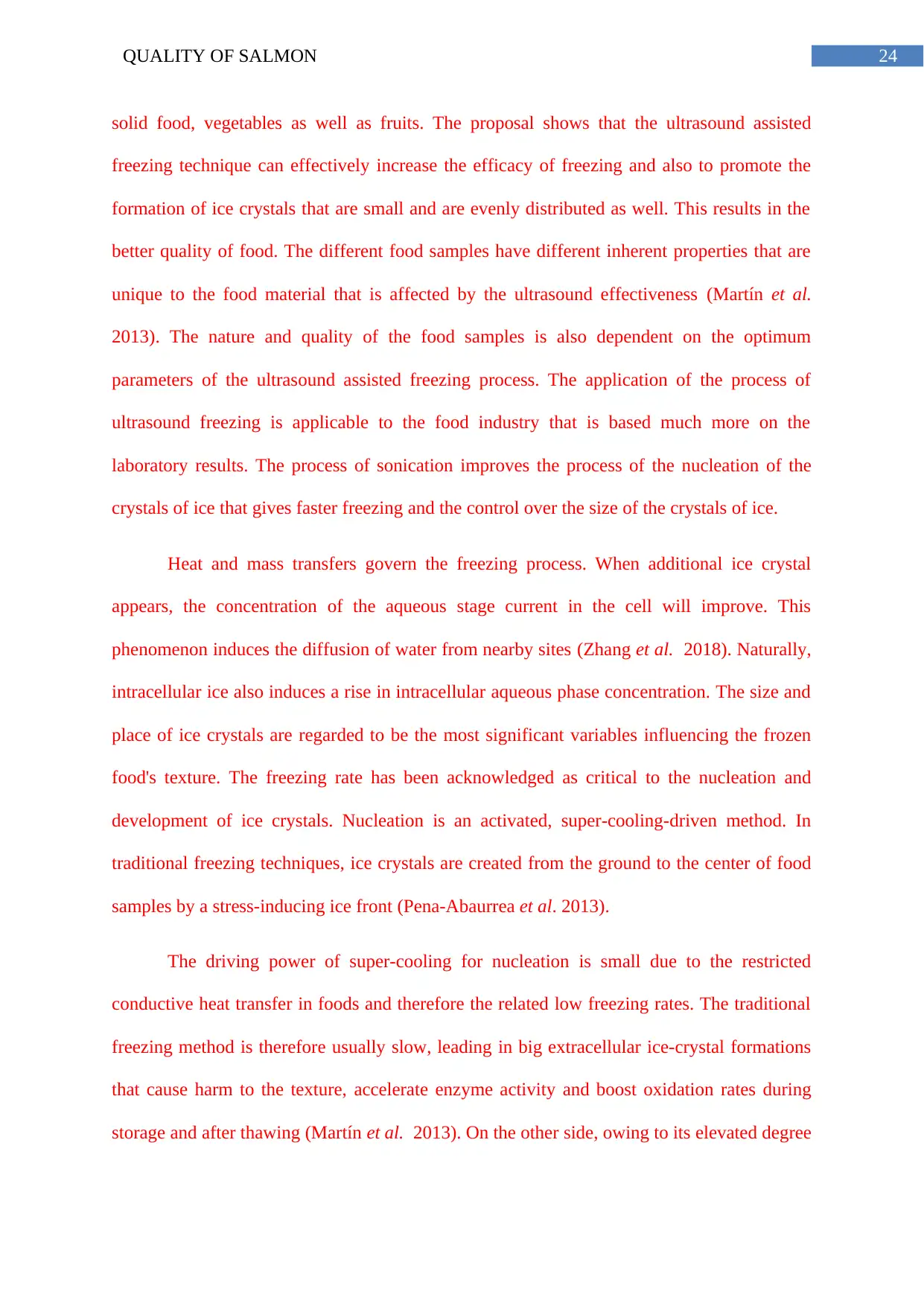
24QUALITY OF SALMON
solid food, vegetables as well as fruits. The proposal shows that the ultrasound assisted
freezing technique can effectively increase the efficacy of freezing and also to promote the
formation of ice crystals that are small and are evenly distributed as well. This results in the
better quality of food. The different food samples have different inherent properties that are
unique to the food material that is affected by the ultrasound effectiveness (Martín et al.
2013). The nature and quality of the food samples is also dependent on the optimum
parameters of the ultrasound assisted freezing process. The application of the process of
ultrasound freezing is applicable to the food industry that is based much more on the
laboratory results. The process of sonication improves the process of the nucleation of the
crystals of ice that gives faster freezing and the control over the size of the crystals of ice.
Heat and mass transfers govern the freezing process. When additional ice crystal
appears, the concentration of the aqueous stage current in the cell will improve. This
phenomenon induces the diffusion of water from nearby sites (Zhang et al. 2018). Naturally,
intracellular ice also induces a rise in intracellular aqueous phase concentration. The size and
place of ice crystals are regarded to be the most significant variables influencing the frozen
food's texture. The freezing rate has been acknowledged as critical to the nucleation and
development of ice crystals. Nucleation is an activated, super-cooling-driven method. In
traditional freezing techniques, ice crystals are created from the ground to the center of food
samples by a stress-inducing ice front (Pena-Abaurrea et al. 2013).
The driving power of super-cooling for nucleation is small due to the restricted
conductive heat transfer in foods and therefore the related low freezing rates. The traditional
freezing method is therefore usually slow, leading in big extracellular ice-crystal formations
that cause harm to the texture, accelerate enzyme activity and boost oxidation rates during
storage and after thawing (Martín et al. 2013). On the other side, owing to its elevated degree
solid food, vegetables as well as fruits. The proposal shows that the ultrasound assisted
freezing technique can effectively increase the efficacy of freezing and also to promote the
formation of ice crystals that are small and are evenly distributed as well. This results in the
better quality of food. The different food samples have different inherent properties that are
unique to the food material that is affected by the ultrasound effectiveness (Martín et al.
2013). The nature and quality of the food samples is also dependent on the optimum
parameters of the ultrasound assisted freezing process. The application of the process of
ultrasound freezing is applicable to the food industry that is based much more on the
laboratory results. The process of sonication improves the process of the nucleation of the
crystals of ice that gives faster freezing and the control over the size of the crystals of ice.
Heat and mass transfers govern the freezing process. When additional ice crystal
appears, the concentration of the aqueous stage current in the cell will improve. This
phenomenon induces the diffusion of water from nearby sites (Zhang et al. 2018). Naturally,
intracellular ice also induces a rise in intracellular aqueous phase concentration. The size and
place of ice crystals are regarded to be the most significant variables influencing the frozen
food's texture. The freezing rate has been acknowledged as critical to the nucleation and
development of ice crystals. Nucleation is an activated, super-cooling-driven method. In
traditional freezing techniques, ice crystals are created from the ground to the center of food
samples by a stress-inducing ice front (Pena-Abaurrea et al. 2013).
The driving power of super-cooling for nucleation is small due to the restricted
conductive heat transfer in foods and therefore the related low freezing rates. The traditional
freezing method is therefore usually slow, leading in big extracellular ice-crystal formations
that cause harm to the texture, accelerate enzyme activity and boost oxidation rates during
storage and after thawing (Martín et al. 2013). On the other side, owing to its elevated degree
Paraphrase This Document
Need a fresh take? Get an instant paraphrase of this document with our AI Paraphraser

25QUALITY OF SALMON
of super-cooling, fast freezing (e.g. cryogenic freezing) can decrease ice-crystal size, but it
can cause deadly intracellular ice crystallization in living cells and mechanical cracking.
High-intensity ultrasound applications for improving the effectiveness of the drying
method, controlling the size and size distribution of ice crystals, and improving the quality of
frozen foods have been discussed in detail (Martín et al. 2013). Also highlighted was the use
of low-intensity ultrasound to monitor the ice content and the progress of the freezing
process. The range of ultrasound applied can be categorized into two subclasses: diagnostic
ultrasound of low intensity (5-10 MHz) and ultrasound of elevated intensity (20-100 kHz).
Fresh foods are susceptible to development of microorganisms and chemical reactions during
storage due to the presence of a big quantity of water, leading in food spoilage.
To better preserve the quality of the fresh and packaged foods, many minimal-
temperature handling techniques, including cooling, freezing, drying and
freeze concentration, are used to ensure quality of food and to extend the shelf life. Freezing
and frozen storage are among them popular in the food industry to keep food for a relatively
long period of time. Proper characterization and control of the crystal structure is crucial in
order to better manage crystallization and reach a desired crystalline state. Direct or indirect
techniques are continuously being studied and developed to observe ice crystals (Pena-
Abaurrea et al. 2013). The data acquired offers a more extensive and reliable knowledge of
the freezing method with ongoing improvements in imaging and spectroscopic techniques.
On the other side, air blasting, plate contact, cryogenic freezing, fluidized bed freezing and
immersion freezing, as well as the mixture of these techniques, which have distinct
constraints in freezing rates and impacts, are the most commonly used freezing techniques in
the sector.
of super-cooling, fast freezing (e.g. cryogenic freezing) can decrease ice-crystal size, but it
can cause deadly intracellular ice crystallization in living cells and mechanical cracking.
High-intensity ultrasound applications for improving the effectiveness of the drying
method, controlling the size and size distribution of ice crystals, and improving the quality of
frozen foods have been discussed in detail (Martín et al. 2013). Also highlighted was the use
of low-intensity ultrasound to monitor the ice content and the progress of the freezing
process. The range of ultrasound applied can be categorized into two subclasses: diagnostic
ultrasound of low intensity (5-10 MHz) and ultrasound of elevated intensity (20-100 kHz).
Fresh foods are susceptible to development of microorganisms and chemical reactions during
storage due to the presence of a big quantity of water, leading in food spoilage.
To better preserve the quality of the fresh and packaged foods, many minimal-
temperature handling techniques, including cooling, freezing, drying and
freeze concentration, are used to ensure quality of food and to extend the shelf life. Freezing
and frozen storage are among them popular in the food industry to keep food for a relatively
long period of time. Proper characterization and control of the crystal structure is crucial in
order to better manage crystallization and reach a desired crystalline state. Direct or indirect
techniques are continuously being studied and developed to observe ice crystals (Pena-
Abaurrea et al. 2013). The data acquired offers a more extensive and reliable knowledge of
the freezing method with ongoing improvements in imaging and spectroscopic techniques.
On the other side, air blasting, plate contact, cryogenic freezing, fluidized bed freezing and
immersion freezing, as well as the mixture of these techniques, which have distinct
constraints in freezing rates and impacts, are the most commonly used freezing techniques in
the sector.
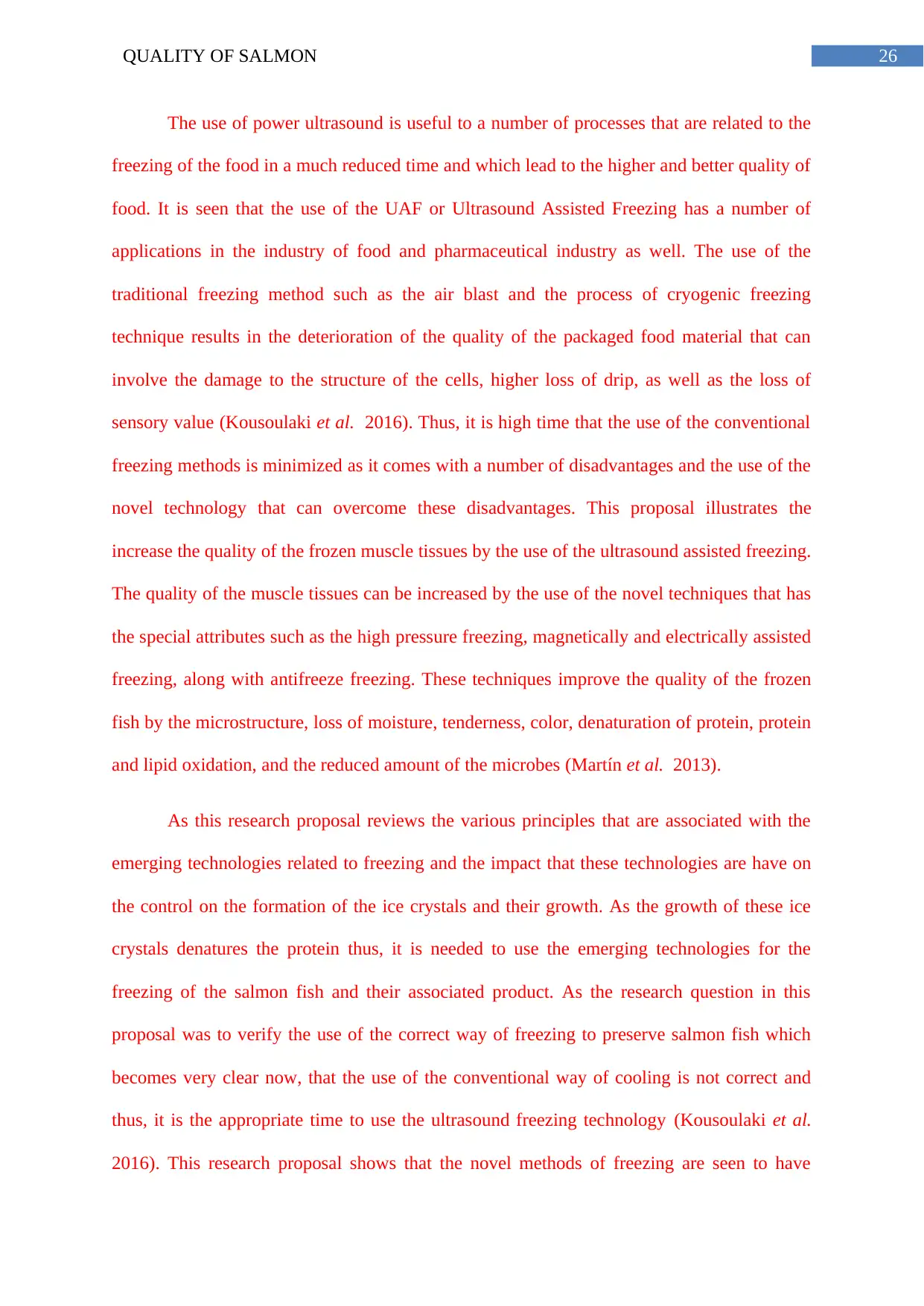
26QUALITY OF SALMON
The use of power ultrasound is useful to a number of processes that are related to the
freezing of the food in a much reduced time and which lead to the higher and better quality of
food. It is seen that the use of the UAF or Ultrasound Assisted Freezing has a number of
applications in the industry of food and pharmaceutical industry as well. The use of the
traditional freezing method such as the air blast and the process of cryogenic freezing
technique results in the deterioration of the quality of the packaged food material that can
involve the damage to the structure of the cells, higher loss of drip, as well as the loss of
sensory value (Kousoulaki et al. 2016). Thus, it is high time that the use of the conventional
freezing methods is minimized as it comes with a number of disadvantages and the use of the
novel technology that can overcome these disadvantages. This proposal illustrates the
increase the quality of the frozen muscle tissues by the use of the ultrasound assisted freezing.
The quality of the muscle tissues can be increased by the use of the novel techniques that has
the special attributes such as the high pressure freezing, magnetically and electrically assisted
freezing, along with antifreeze freezing. These techniques improve the quality of the frozen
fish by the microstructure, loss of moisture, tenderness, color, denaturation of protein, protein
and lipid oxidation, and the reduced amount of the microbes (Martín et al. 2013).
As this research proposal reviews the various principles that are associated with the
emerging technologies related to freezing and the impact that these technologies are have on
the control on the formation of the ice crystals and their growth. As the growth of these ice
crystals denatures the protein thus, it is needed to use the emerging technologies for the
freezing of the salmon fish and their associated product. As the research question in this
proposal was to verify the use of the correct way of freezing to preserve salmon fish which
becomes very clear now, that the use of the conventional way of cooling is not correct and
thus, it is the appropriate time to use the ultrasound freezing technology (Kousoulaki et al.
2016). This research proposal shows that the novel methods of freezing are seen to have
The use of power ultrasound is useful to a number of processes that are related to the
freezing of the food in a much reduced time and which lead to the higher and better quality of
food. It is seen that the use of the UAF or Ultrasound Assisted Freezing has a number of
applications in the industry of food and pharmaceutical industry as well. The use of the
traditional freezing method such as the air blast and the process of cryogenic freezing
technique results in the deterioration of the quality of the packaged food material that can
involve the damage to the structure of the cells, higher loss of drip, as well as the loss of
sensory value (Kousoulaki et al. 2016). Thus, it is high time that the use of the conventional
freezing methods is minimized as it comes with a number of disadvantages and the use of the
novel technology that can overcome these disadvantages. This proposal illustrates the
increase the quality of the frozen muscle tissues by the use of the ultrasound assisted freezing.
The quality of the muscle tissues can be increased by the use of the novel techniques that has
the special attributes such as the high pressure freezing, magnetically and electrically assisted
freezing, along with antifreeze freezing. These techniques improve the quality of the frozen
fish by the microstructure, loss of moisture, tenderness, color, denaturation of protein, protein
and lipid oxidation, and the reduced amount of the microbes (Martín et al. 2013).
As this research proposal reviews the various principles that are associated with the
emerging technologies related to freezing and the impact that these technologies are have on
the control on the formation of the ice crystals and their growth. As the growth of these ice
crystals denatures the protein thus, it is needed to use the emerging technologies for the
freezing of the salmon fish and their associated product. As the research question in this
proposal was to verify the use of the correct way of freezing to preserve salmon fish which
becomes very clear now, that the use of the conventional way of cooling is not correct and
thus, it is the appropriate time to use the ultrasound freezing technology (Kousoulaki et al.
2016). This research proposal shows that the novel methods of freezing are seen to have
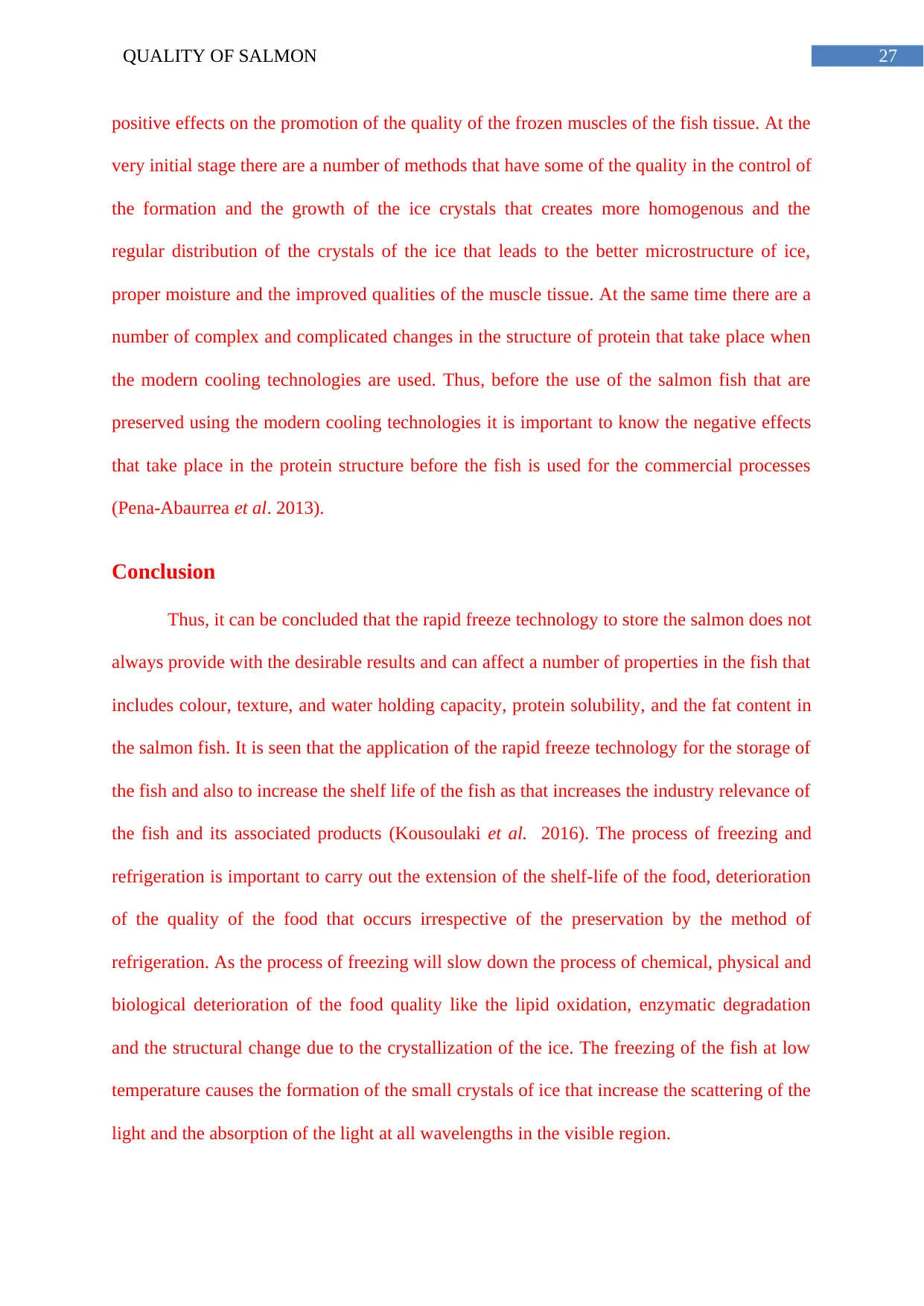
27QUALITY OF SALMON
positive effects on the promotion of the quality of the frozen muscles of the fish tissue. At the
very initial stage there are a number of methods that have some of the quality in the control of
the formation and the growth of the ice crystals that creates more homogenous and the
regular distribution of the crystals of the ice that leads to the better microstructure of ice,
proper moisture and the improved qualities of the muscle tissue. At the same time there are a
number of complex and complicated changes in the structure of protein that take place when
the modern cooling technologies are used. Thus, before the use of the salmon fish that are
preserved using the modern cooling technologies it is important to know the negative effects
that take place in the protein structure before the fish is used for the commercial processes
(Pena-Abaurrea et al. 2013).
Conclusion
Thus, it can be concluded that the rapid freeze technology to store the salmon does not
always provide with the desirable results and can affect a number of properties in the fish that
includes colour, texture, and water holding capacity, protein solubility, and the fat content in
the salmon fish. It is seen that the application of the rapid freeze technology for the storage of
the fish and also to increase the shelf life of the fish as that increases the industry relevance of
the fish and its associated products (Kousoulaki et al. 2016). The process of freezing and
refrigeration is important to carry out the extension of the shelf-life of the food, deterioration
of the quality of the food that occurs irrespective of the preservation by the method of
refrigeration. As the process of freezing will slow down the process of chemical, physical and
biological deterioration of the food quality like the lipid oxidation, enzymatic degradation
and the structural change due to the crystallization of the ice. The freezing of the fish at low
temperature causes the formation of the small crystals of ice that increase the scattering of the
light and the absorption of the light at all wavelengths in the visible region.
positive effects on the promotion of the quality of the frozen muscles of the fish tissue. At the
very initial stage there are a number of methods that have some of the quality in the control of
the formation and the growth of the ice crystals that creates more homogenous and the
regular distribution of the crystals of the ice that leads to the better microstructure of ice,
proper moisture and the improved qualities of the muscle tissue. At the same time there are a
number of complex and complicated changes in the structure of protein that take place when
the modern cooling technologies are used. Thus, before the use of the salmon fish that are
preserved using the modern cooling technologies it is important to know the negative effects
that take place in the protein structure before the fish is used for the commercial processes
(Pena-Abaurrea et al. 2013).
Conclusion
Thus, it can be concluded that the rapid freeze technology to store the salmon does not
always provide with the desirable results and can affect a number of properties in the fish that
includes colour, texture, and water holding capacity, protein solubility, and the fat content in
the salmon fish. It is seen that the application of the rapid freeze technology for the storage of
the fish and also to increase the shelf life of the fish as that increases the industry relevance of
the fish and its associated products (Kousoulaki et al. 2016). The process of freezing and
refrigeration is important to carry out the extension of the shelf-life of the food, deterioration
of the quality of the food that occurs irrespective of the preservation by the method of
refrigeration. As the process of freezing will slow down the process of chemical, physical and
biological deterioration of the food quality like the lipid oxidation, enzymatic degradation
and the structural change due to the crystallization of the ice. The freezing of the fish at low
temperature causes the formation of the small crystals of ice that increase the scattering of the
light and the absorption of the light at all wavelengths in the visible region.
Secure Best Marks with AI Grader
Need help grading? Try our AI Grader for instant feedback on your assignments.

28QUALITY OF SALMON
It is also seen that the freezing for a longer time can also result in the slow destruction
of the quality of the food that mainly occurs due to the difference in the storage temperature.
Thus, it can be concluded that the quality of the salmon gets affected by the rapid freeze
technology. It is seen that the oxidation of the lipid content of the fish reduces the sensory
quality of the fish due to the free radical chain reaction that results in the deterioration of the
quality of fish such as rancidity and flavour (Geidobler and Winter 2013). These reactions
can often cause the loss of the nutritive content of the product that declines the confidence of
the consumer towards the buying of the product and thus, renders it unfit for the consumption
by the humans. From the research it becomes clear that the consumption of such food in
which the lipid contents are oxidized can alter the proteins, DNA, initiation of the tumor and
the change in the structure of the membrane in the biological system of the humans.
It is clear from the literature review that the process of freezing is helpful for the
storage of the fish however, from the research it becomes clear that the rapid freeze
technology not only deteriorates the quality of the fish also hampers the health of the
consumers. From the conducted research it has become clear that the rapid freezing for the
storage of the fish affects the colour, texture, ice crystal growth and the overall structural
integrity of the fish. It is also seen that there is a threshold level after which the freezing
temperature do not affect the overall quality of the food (Geidobler and Winter 2013). Thus,
the required research is to be conducted in order to find a balance between the maintenance of
the quality of the food, and the also to increase the efficacy of the household freezers and the
commercial freezers.
A number of techniques are available either in the traditional or the conventional
technology that helps for the preservation of the fish and fish products. The preservation
method that is being used should be appropriate for the conditions of the food as the methods
that are available are not capable to maintain the freshness and they are able to maintain the
It is also seen that the freezing for a longer time can also result in the slow destruction
of the quality of the food that mainly occurs due to the difference in the storage temperature.
Thus, it can be concluded that the quality of the salmon gets affected by the rapid freeze
technology. It is seen that the oxidation of the lipid content of the fish reduces the sensory
quality of the fish due to the free radical chain reaction that results in the deterioration of the
quality of fish such as rancidity and flavour (Geidobler and Winter 2013). These reactions
can often cause the loss of the nutritive content of the product that declines the confidence of
the consumer towards the buying of the product and thus, renders it unfit for the consumption
by the humans. From the research it becomes clear that the consumption of such food in
which the lipid contents are oxidized can alter the proteins, DNA, initiation of the tumor and
the change in the structure of the membrane in the biological system of the humans.
It is clear from the literature review that the process of freezing is helpful for the
storage of the fish however, from the research it becomes clear that the rapid freeze
technology not only deteriorates the quality of the fish also hampers the health of the
consumers. From the conducted research it has become clear that the rapid freezing for the
storage of the fish affects the colour, texture, ice crystal growth and the overall structural
integrity of the fish. It is also seen that there is a threshold level after which the freezing
temperature do not affect the overall quality of the food (Geidobler and Winter 2013). Thus,
the required research is to be conducted in order to find a balance between the maintenance of
the quality of the food, and the also to increase the efficacy of the household freezers and the
commercial freezers.
A number of techniques are available either in the traditional or the conventional
technology that helps for the preservation of the fish and fish products. The preservation
method that is being used should be appropriate for the conditions of the food as the methods
that are available are not capable to maintain the freshness and they are able to maintain the
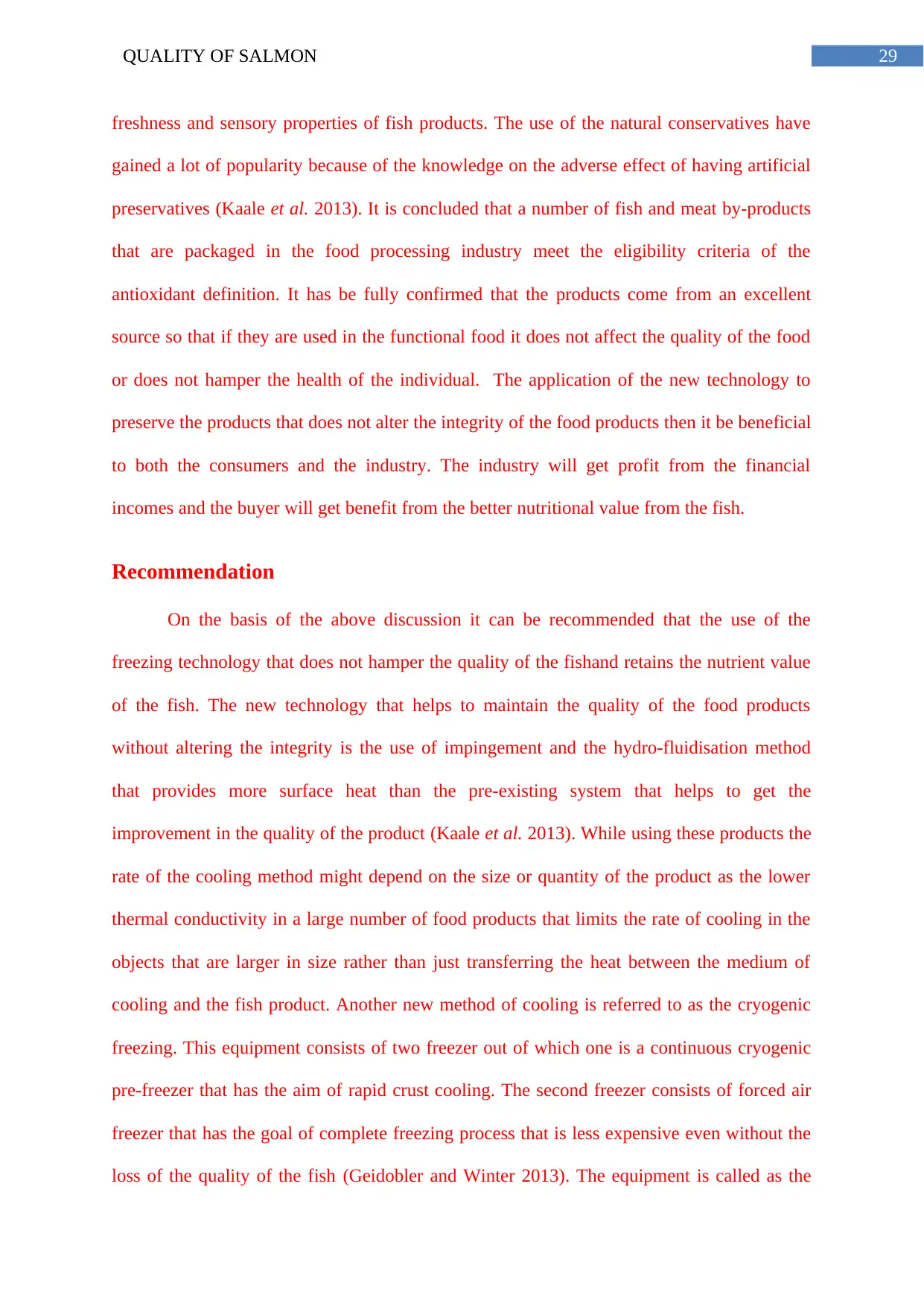
29QUALITY OF SALMON
freshness and sensory properties of fish products. The use of the natural conservatives have
gained a lot of popularity because of the knowledge on the adverse effect of having artificial
preservatives (Kaale et al. 2013). It is concluded that a number of fish and meat by-products
that are packaged in the food processing industry meet the eligibility criteria of the
antioxidant definition. It has be fully confirmed that the products come from an excellent
source so that if they are used in the functional food it does not affect the quality of the food
or does not hamper the health of the individual. The application of the new technology to
preserve the products that does not alter the integrity of the food products then it be beneficial
to both the consumers and the industry. The industry will get profit from the financial
incomes and the buyer will get benefit from the better nutritional value from the fish.
Recommendation
On the basis of the above discussion it can be recommended that the use of the
freezing technology that does not hamper the quality of the fishand retains the nutrient value
of the fish. The new technology that helps to maintain the quality of the food products
without altering the integrity is the use of impingement and the hydro-fluidisation method
that provides more surface heat than the pre-existing system that helps to get the
improvement in the quality of the product (Kaale et al. 2013). While using these products the
rate of the cooling method might depend on the size or quantity of the product as the lower
thermal conductivity in a large number of food products that limits the rate of cooling in the
objects that are larger in size rather than just transferring the heat between the medium of
cooling and the fish product. Another new method of cooling is referred to as the cryogenic
freezing. This equipment consists of two freezer out of which one is a continuous cryogenic
pre-freezer that has the aim of rapid crust cooling. The second freezer consists of forced air
freezer that has the goal of complete freezing process that is less expensive even without the
loss of the quality of the fish (Geidobler and Winter 2013). The equipment is called as the
freshness and sensory properties of fish products. The use of the natural conservatives have
gained a lot of popularity because of the knowledge on the adverse effect of having artificial
preservatives (Kaale et al. 2013). It is concluded that a number of fish and meat by-products
that are packaged in the food processing industry meet the eligibility criteria of the
antioxidant definition. It has be fully confirmed that the products come from an excellent
source so that if they are used in the functional food it does not affect the quality of the food
or does not hamper the health of the individual. The application of the new technology to
preserve the products that does not alter the integrity of the food products then it be beneficial
to both the consumers and the industry. The industry will get profit from the financial
incomes and the buyer will get benefit from the better nutritional value from the fish.
Recommendation
On the basis of the above discussion it can be recommended that the use of the
freezing technology that does not hamper the quality of the fishand retains the nutrient value
of the fish. The new technology that helps to maintain the quality of the food products
without altering the integrity is the use of impingement and the hydro-fluidisation method
that provides more surface heat than the pre-existing system that helps to get the
improvement in the quality of the product (Kaale et al. 2013). While using these products the
rate of the cooling method might depend on the size or quantity of the product as the lower
thermal conductivity in a large number of food products that limits the rate of cooling in the
objects that are larger in size rather than just transferring the heat between the medium of
cooling and the fish product. Another new method of cooling is referred to as the cryogenic
freezing. This equipment consists of two freezer out of which one is a continuous cryogenic
pre-freezer that has the aim of rapid crust cooling. The second freezer consists of forced air
freezer that has the goal of complete freezing process that is less expensive even without the
loss of the quality of the fish (Geidobler and Winter 2013). The equipment is called as the
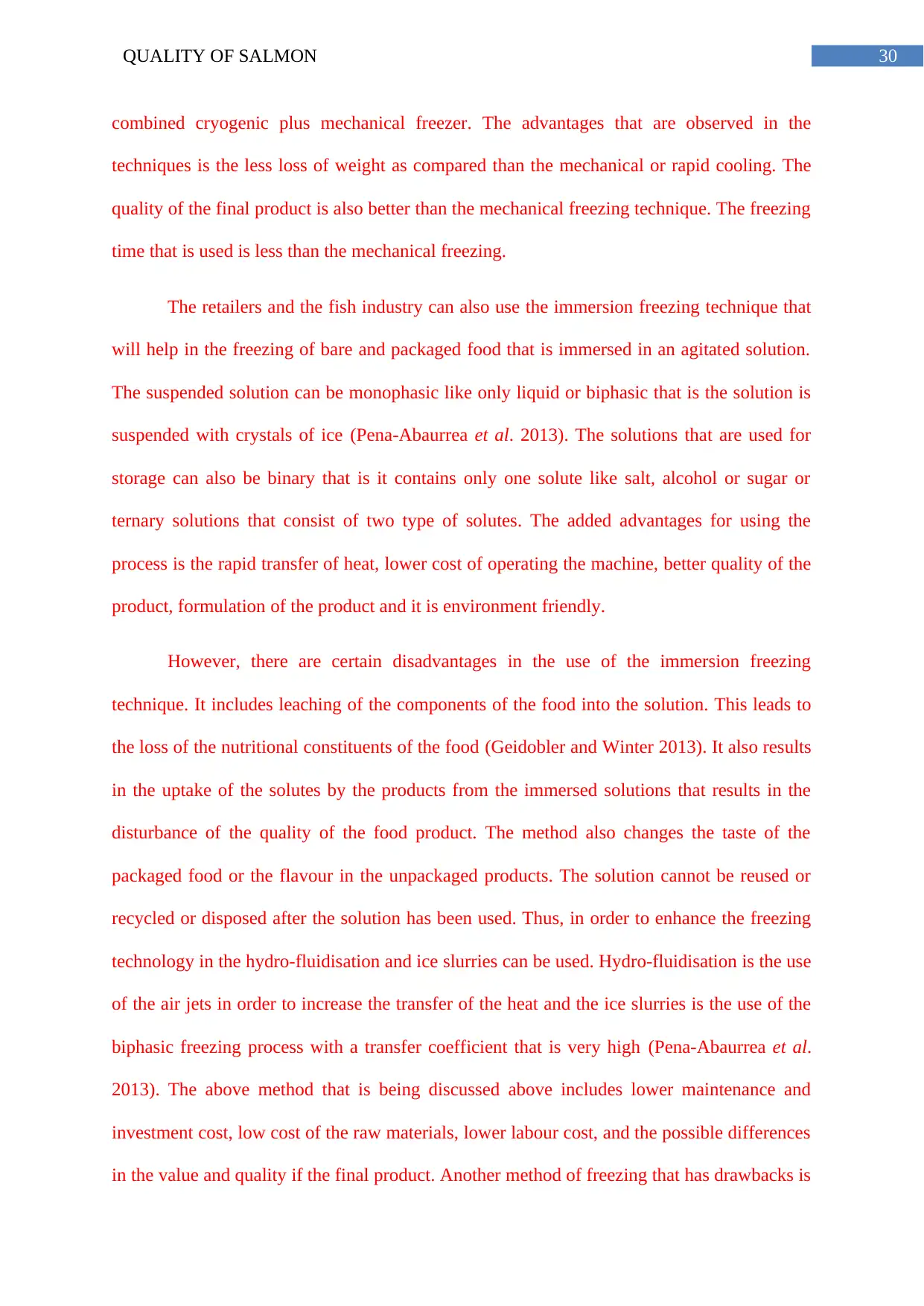
30QUALITY OF SALMON
combined cryogenic plus mechanical freezer. The advantages that are observed in the
techniques is the less loss of weight as compared than the mechanical or rapid cooling. The
quality of the final product is also better than the mechanical freezing technique. The freezing
time that is used is less than the mechanical freezing.
The retailers and the fish industry can also use the immersion freezing technique that
will help in the freezing of bare and packaged food that is immersed in an agitated solution.
The suspended solution can be monophasic like only liquid or biphasic that is the solution is
suspended with crystals of ice (Pena-Abaurrea et al. 2013). The solutions that are used for
storage can also be binary that is it contains only one solute like salt, alcohol or sugar or
ternary solutions that consist of two type of solutes. The added advantages for using the
process is the rapid transfer of heat, lower cost of operating the machine, better quality of the
product, formulation of the product and it is environment friendly.
However, there are certain disadvantages in the use of the immersion freezing
technique. It includes leaching of the components of the food into the solution. This leads to
the loss of the nutritional constituents of the food (Geidobler and Winter 2013). It also results
in the uptake of the solutes by the products from the immersed solutions that results in the
disturbance of the quality of the food product. The method also changes the taste of the
packaged food or the flavour in the unpackaged products. The solution cannot be reused or
recycled or disposed after the solution has been used. Thus, in order to enhance the freezing
technology in the hydro-fluidisation and ice slurries can be used. Hydro-fluidisation is the use
of the air jets in order to increase the transfer of the heat and the ice slurries is the use of the
biphasic freezing process with a transfer coefficient that is very high (Pena-Abaurrea et al.
2013). The above method that is being discussed above includes lower maintenance and
investment cost, low cost of the raw materials, lower labour cost, and the possible differences
in the value and quality if the final product. Another method of freezing that has drawbacks is
combined cryogenic plus mechanical freezer. The advantages that are observed in the
techniques is the less loss of weight as compared than the mechanical or rapid cooling. The
quality of the final product is also better than the mechanical freezing technique. The freezing
time that is used is less than the mechanical freezing.
The retailers and the fish industry can also use the immersion freezing technique that
will help in the freezing of bare and packaged food that is immersed in an agitated solution.
The suspended solution can be monophasic like only liquid or biphasic that is the solution is
suspended with crystals of ice (Pena-Abaurrea et al. 2013). The solutions that are used for
storage can also be binary that is it contains only one solute like salt, alcohol or sugar or
ternary solutions that consist of two type of solutes. The added advantages for using the
process is the rapid transfer of heat, lower cost of operating the machine, better quality of the
product, formulation of the product and it is environment friendly.
However, there are certain disadvantages in the use of the immersion freezing
technique. It includes leaching of the components of the food into the solution. This leads to
the loss of the nutritional constituents of the food (Geidobler and Winter 2013). It also results
in the uptake of the solutes by the products from the immersed solutions that results in the
disturbance of the quality of the food product. The method also changes the taste of the
packaged food or the flavour in the unpackaged products. The solution cannot be reused or
recycled or disposed after the solution has been used. Thus, in order to enhance the freezing
technology in the hydro-fluidisation and ice slurries can be used. Hydro-fluidisation is the use
of the air jets in order to increase the transfer of the heat and the ice slurries is the use of the
biphasic freezing process with a transfer coefficient that is very high (Pena-Abaurrea et al.
2013). The above method that is being discussed above includes lower maintenance and
investment cost, low cost of the raw materials, lower labour cost, and the possible differences
in the value and quality if the final product. Another method of freezing that has drawbacks is
Paraphrase This Document
Need a fresh take? Get an instant paraphrase of this document with our AI Paraphraser
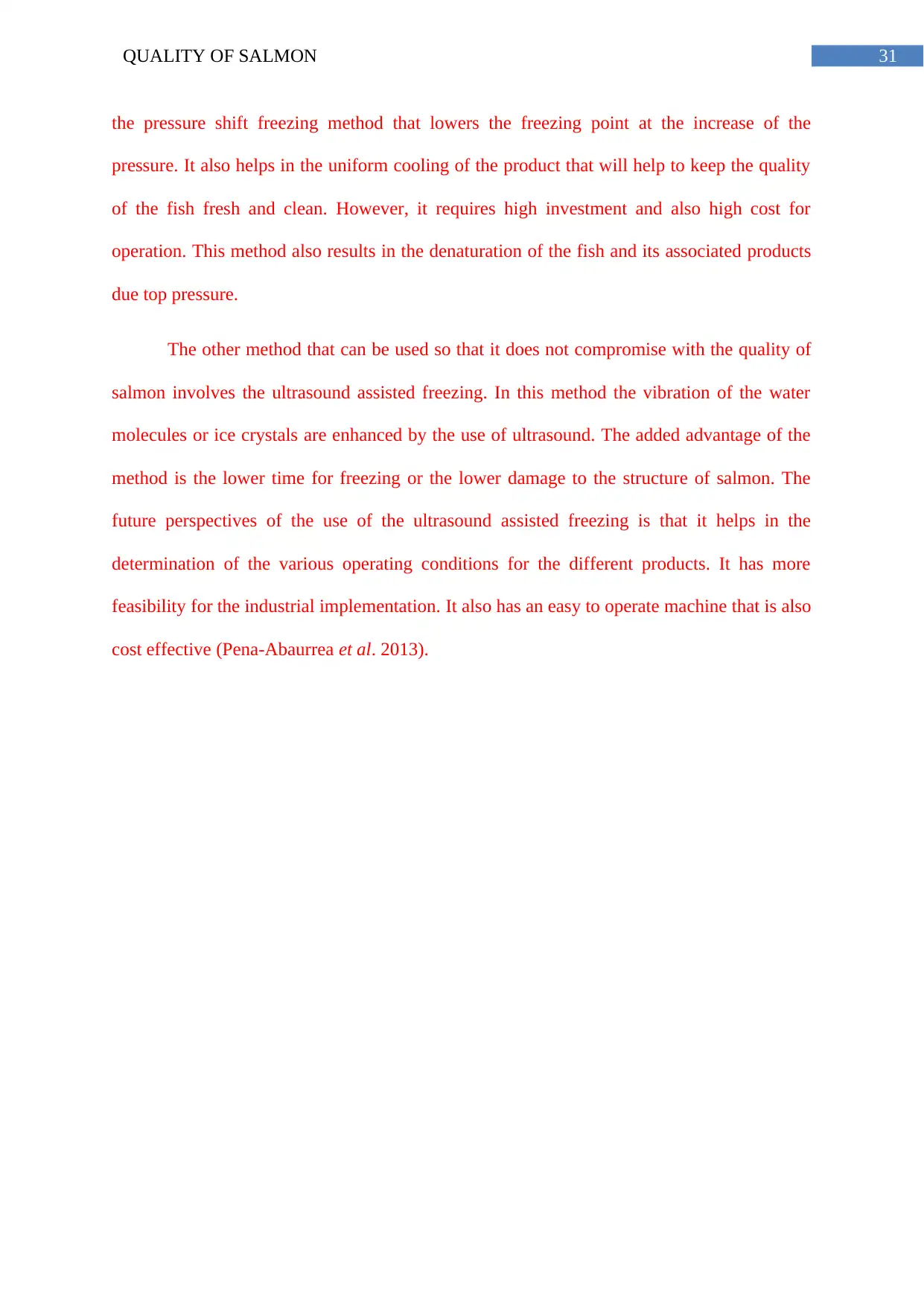
31QUALITY OF SALMON
the pressure shift freezing method that lowers the freezing point at the increase of the
pressure. It also helps in the uniform cooling of the product that will help to keep the quality
of the fish fresh and clean. However, it requires high investment and also high cost for
operation. This method also results in the denaturation of the fish and its associated products
due top pressure.
The other method that can be used so that it does not compromise with the quality of
salmon involves the ultrasound assisted freezing. In this method the vibration of the water
molecules or ice crystals are enhanced by the use of ultrasound. The added advantage of the
method is the lower time for freezing or the lower damage to the structure of salmon. The
future perspectives of the use of the ultrasound assisted freezing is that it helps in the
determination of the various operating conditions for the different products. It has more
feasibility for the industrial implementation. It also has an easy to operate machine that is also
cost effective (Pena-Abaurrea et al. 2013).
the pressure shift freezing method that lowers the freezing point at the increase of the
pressure. It also helps in the uniform cooling of the product that will help to keep the quality
of the fish fresh and clean. However, it requires high investment and also high cost for
operation. This method also results in the denaturation of the fish and its associated products
due top pressure.
The other method that can be used so that it does not compromise with the quality of
salmon involves the ultrasound assisted freezing. In this method the vibration of the water
molecules or ice crystals are enhanced by the use of ultrasound. The added advantage of the
method is the lower time for freezing or the lower damage to the structure of salmon. The
future perspectives of the use of the ultrasound assisted freezing is that it helps in the
determination of the various operating conditions for the different products. It has more
feasibility for the industrial implementation. It also has an easy to operate machine that is also
cost effective (Pena-Abaurrea et al. 2013).
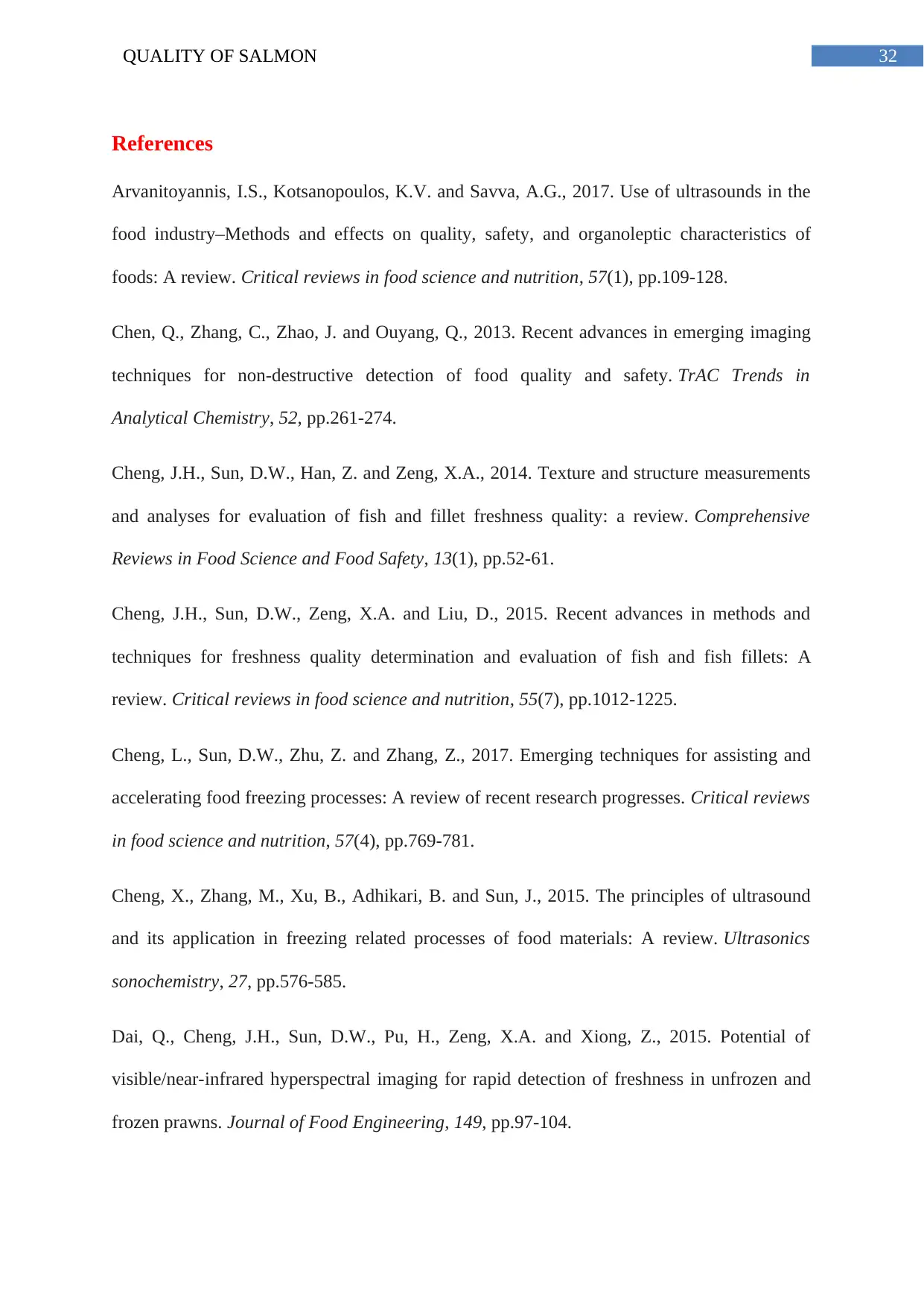
32QUALITY OF SALMON
References
Arvanitoyannis, I.S., Kotsanopoulos, K.V. and Savva, A.G., 2017. Use of ultrasounds in the
food industry–Methods and effects on quality, safety, and organoleptic characteristics of
foods: A review. Critical reviews in food science and nutrition, 57(1), pp.109-128.
Chen, Q., Zhang, C., Zhao, J. and Ouyang, Q., 2013. Recent advances in emerging imaging
techniques for non-destructive detection of food quality and safety. TrAC Trends in
Analytical Chemistry, 52, pp.261-274.
Cheng, J.H., Sun, D.W., Han, Z. and Zeng, X.A., 2014. Texture and structure measurements
and analyses for evaluation of fish and fillet freshness quality: a review. Comprehensive
Reviews in Food Science and Food Safety, 13(1), pp.52-61.
Cheng, J.H., Sun, D.W., Zeng, X.A. and Liu, D., 2015. Recent advances in methods and
techniques for freshness quality determination and evaluation of fish and fish fillets: A
review. Critical reviews in food science and nutrition, 55(7), pp.1012-1225.
Cheng, L., Sun, D.W., Zhu, Z. and Zhang, Z., 2017. Emerging techniques for assisting and
accelerating food freezing processes: A review of recent research progresses. Critical reviews
in food science and nutrition, 57(4), pp.769-781.
Cheng, X., Zhang, M., Xu, B., Adhikari, B. and Sun, J., 2015. The principles of ultrasound
and its application in freezing related processes of food materials: A review. Ultrasonics
sonochemistry, 27, pp.576-585.
Dai, Q., Cheng, J.H., Sun, D.W., Pu, H., Zeng, X.A. and Xiong, Z., 2015. Potential of
visible/near-infrared hyperspectral imaging for rapid detection of freshness in unfrozen and
frozen prawns. Journal of Food Engineering, 149, pp.97-104.
References
Arvanitoyannis, I.S., Kotsanopoulos, K.V. and Savva, A.G., 2017. Use of ultrasounds in the
food industry–Methods and effects on quality, safety, and organoleptic characteristics of
foods: A review. Critical reviews in food science and nutrition, 57(1), pp.109-128.
Chen, Q., Zhang, C., Zhao, J. and Ouyang, Q., 2013. Recent advances in emerging imaging
techniques for non-destructive detection of food quality and safety. TrAC Trends in
Analytical Chemistry, 52, pp.261-274.
Cheng, J.H., Sun, D.W., Han, Z. and Zeng, X.A., 2014. Texture and structure measurements
and analyses for evaluation of fish and fillet freshness quality: a review. Comprehensive
Reviews in Food Science and Food Safety, 13(1), pp.52-61.
Cheng, J.H., Sun, D.W., Zeng, X.A. and Liu, D., 2015. Recent advances in methods and
techniques for freshness quality determination and evaluation of fish and fish fillets: A
review. Critical reviews in food science and nutrition, 55(7), pp.1012-1225.
Cheng, L., Sun, D.W., Zhu, Z. and Zhang, Z., 2017. Emerging techniques for assisting and
accelerating food freezing processes: A review of recent research progresses. Critical reviews
in food science and nutrition, 57(4), pp.769-781.
Cheng, X., Zhang, M., Xu, B., Adhikari, B. and Sun, J., 2015. The principles of ultrasound
and its application in freezing related processes of food materials: A review. Ultrasonics
sonochemistry, 27, pp.576-585.
Dai, Q., Cheng, J.H., Sun, D.W., Pu, H., Zeng, X.A. and Xiong, Z., 2015. Potential of
visible/near-infrared hyperspectral imaging for rapid detection of freshness in unfrozen and
frozen prawns. Journal of Food Engineering, 149, pp.97-104.
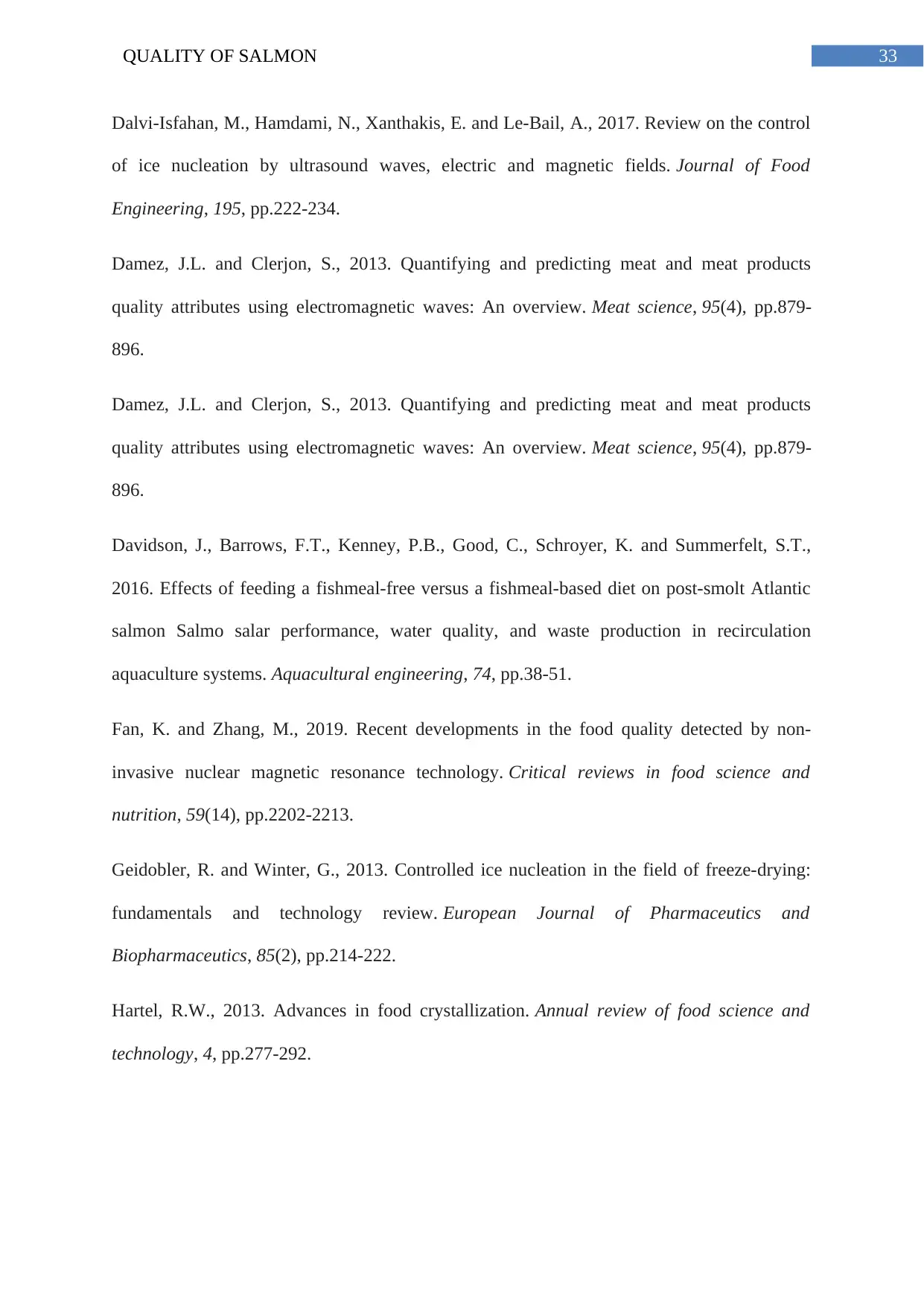
33QUALITY OF SALMON
Dalvi-Isfahan, M., Hamdami, N., Xanthakis, E. and Le-Bail, A., 2017. Review on the control
of ice nucleation by ultrasound waves, electric and magnetic fields. Journal of Food
Engineering, 195, pp.222-234.
Damez, J.L. and Clerjon, S., 2013. Quantifying and predicting meat and meat products
quality attributes using electromagnetic waves: An overview. Meat science, 95(4), pp.879-
896.
Damez, J.L. and Clerjon, S., 2013. Quantifying and predicting meat and meat products
quality attributes using electromagnetic waves: An overview. Meat science, 95(4), pp.879-
896.
Davidson, J., Barrows, F.T., Kenney, P.B., Good, C., Schroyer, K. and Summerfelt, S.T.,
2016. Effects of feeding a fishmeal-free versus a fishmeal-based diet on post-smolt Atlantic
salmon Salmo salar performance, water quality, and waste production in recirculation
aquaculture systems. Aquacultural engineering, 74, pp.38-51.
Fan, K. and Zhang, M., 2019. Recent developments in the food quality detected by non-
invasive nuclear magnetic resonance technology. Critical reviews in food science and
nutrition, 59(14), pp.2202-2213.
Geidobler, R. and Winter, G., 2013. Controlled ice nucleation in the field of freeze-drying:
fundamentals and technology review. European Journal of Pharmaceutics and
Biopharmaceutics, 85(2), pp.214-222.
Hartel, R.W., 2013. Advances in food crystallization. Annual review of food science and
technology, 4, pp.277-292.
Dalvi-Isfahan, M., Hamdami, N., Xanthakis, E. and Le-Bail, A., 2017. Review on the control
of ice nucleation by ultrasound waves, electric and magnetic fields. Journal of Food
Engineering, 195, pp.222-234.
Damez, J.L. and Clerjon, S., 2013. Quantifying and predicting meat and meat products
quality attributes using electromagnetic waves: An overview. Meat science, 95(4), pp.879-
896.
Damez, J.L. and Clerjon, S., 2013. Quantifying and predicting meat and meat products
quality attributes using electromagnetic waves: An overview. Meat science, 95(4), pp.879-
896.
Davidson, J., Barrows, F.T., Kenney, P.B., Good, C., Schroyer, K. and Summerfelt, S.T.,
2016. Effects of feeding a fishmeal-free versus a fishmeal-based diet on post-smolt Atlantic
salmon Salmo salar performance, water quality, and waste production in recirculation
aquaculture systems. Aquacultural engineering, 74, pp.38-51.
Fan, K. and Zhang, M., 2019. Recent developments in the food quality detected by non-
invasive nuclear magnetic resonance technology. Critical reviews in food science and
nutrition, 59(14), pp.2202-2213.
Geidobler, R. and Winter, G., 2013. Controlled ice nucleation in the field of freeze-drying:
fundamentals and technology review. European Journal of Pharmaceutics and
Biopharmaceutics, 85(2), pp.214-222.
Hartel, R.W., 2013. Advances in food crystallization. Annual review of food science and
technology, 4, pp.277-292.
Secure Best Marks with AI Grader
Need help grading? Try our AI Grader for instant feedback on your assignments.
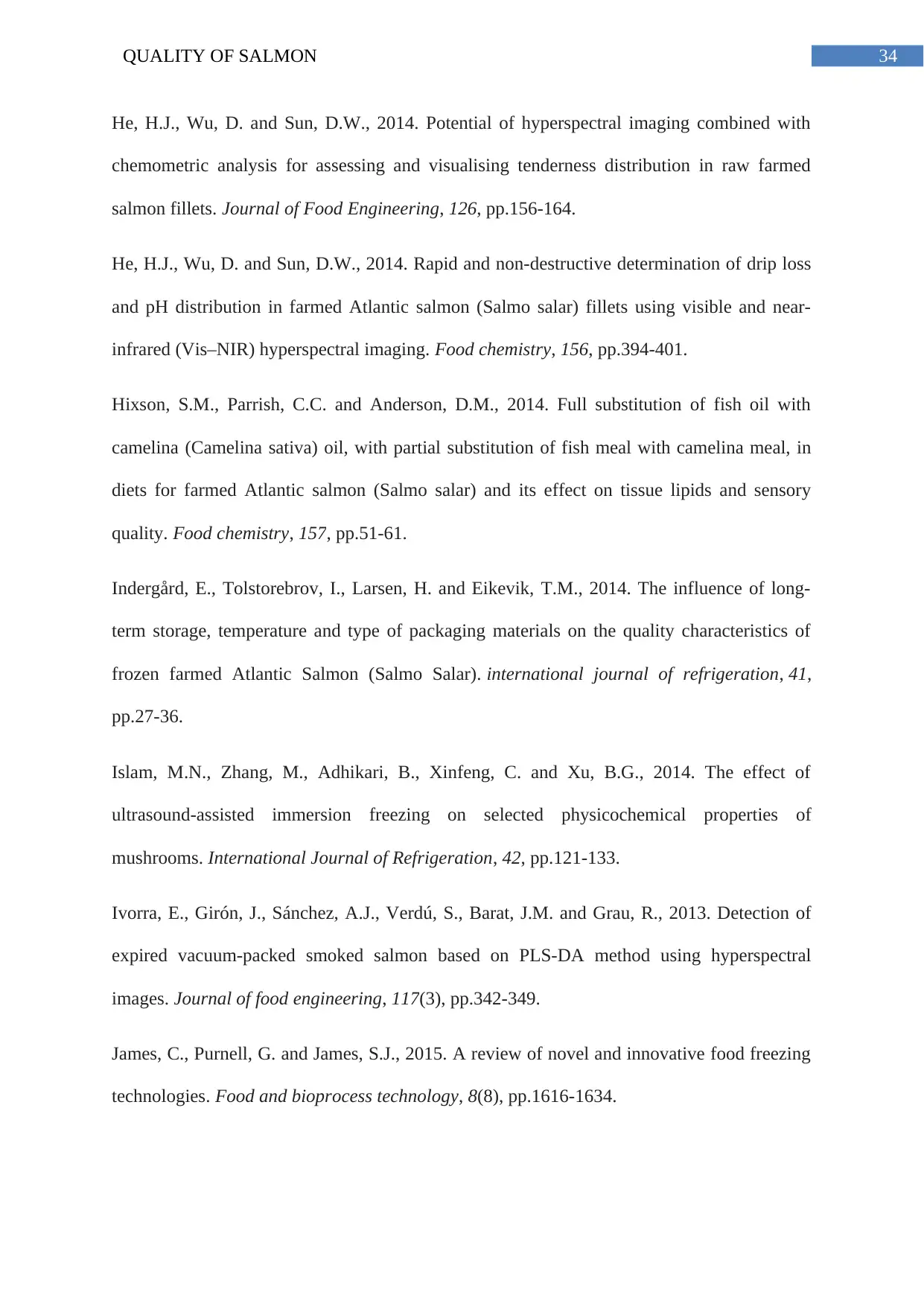
34QUALITY OF SALMON
He, H.J., Wu, D. and Sun, D.W., 2014. Potential of hyperspectral imaging combined with
chemometric analysis for assessing and visualising tenderness distribution in raw farmed
salmon fillets. Journal of Food Engineering, 126, pp.156-164.
He, H.J., Wu, D. and Sun, D.W., 2014. Rapid and non-destructive determination of drip loss
and pH distribution in farmed Atlantic salmon (Salmo salar) fillets using visible and near-
infrared (Vis–NIR) hyperspectral imaging. Food chemistry, 156, pp.394-401.
Hixson, S.M., Parrish, C.C. and Anderson, D.M., 2014. Full substitution of fish oil with
camelina (Camelina sativa) oil, with partial substitution of fish meal with camelina meal, in
diets for farmed Atlantic salmon (Salmo salar) and its effect on tissue lipids and sensory
quality. Food chemistry, 157, pp.51-61.
Indergård, E., Tolstorebrov, I., Larsen, H. and Eikevik, T.M., 2014. The influence of long-
term storage, temperature and type of packaging materials on the quality characteristics of
frozen farmed Atlantic Salmon (Salmo Salar). international journal of refrigeration, 41,
pp.27-36.
Islam, M.N., Zhang, M., Adhikari, B., Xinfeng, C. and Xu, B.G., 2014. The effect of
ultrasound-assisted immersion freezing on selected physicochemical properties of
mushrooms. International Journal of Refrigeration, 42, pp.121-133.
Ivorra, E., Girón, J., Sánchez, A.J., Verdú, S., Barat, J.M. and Grau, R., 2013. Detection of
expired vacuum-packed smoked salmon based on PLS-DA method using hyperspectral
images. Journal of food engineering, 117(3), pp.342-349.
James, C., Purnell, G. and James, S.J., 2015. A review of novel and innovative food freezing
technologies. Food and bioprocess technology, 8(8), pp.1616-1634.
He, H.J., Wu, D. and Sun, D.W., 2014. Potential of hyperspectral imaging combined with
chemometric analysis for assessing and visualising tenderness distribution in raw farmed
salmon fillets. Journal of Food Engineering, 126, pp.156-164.
He, H.J., Wu, D. and Sun, D.W., 2014. Rapid and non-destructive determination of drip loss
and pH distribution in farmed Atlantic salmon (Salmo salar) fillets using visible and near-
infrared (Vis–NIR) hyperspectral imaging. Food chemistry, 156, pp.394-401.
Hixson, S.M., Parrish, C.C. and Anderson, D.M., 2014. Full substitution of fish oil with
camelina (Camelina sativa) oil, with partial substitution of fish meal with camelina meal, in
diets for farmed Atlantic salmon (Salmo salar) and its effect on tissue lipids and sensory
quality. Food chemistry, 157, pp.51-61.
Indergård, E., Tolstorebrov, I., Larsen, H. and Eikevik, T.M., 2014. The influence of long-
term storage, temperature and type of packaging materials on the quality characteristics of
frozen farmed Atlantic Salmon (Salmo Salar). international journal of refrigeration, 41,
pp.27-36.
Islam, M.N., Zhang, M., Adhikari, B., Xinfeng, C. and Xu, B.G., 2014. The effect of
ultrasound-assisted immersion freezing on selected physicochemical properties of
mushrooms. International Journal of Refrigeration, 42, pp.121-133.
Ivorra, E., Girón, J., Sánchez, A.J., Verdú, S., Barat, J.M. and Grau, R., 2013. Detection of
expired vacuum-packed smoked salmon based on PLS-DA method using hyperspectral
images. Journal of food engineering, 117(3), pp.342-349.
James, C., Purnell, G. and James, S.J., 2015. A review of novel and innovative food freezing
technologies. Food and bioprocess technology, 8(8), pp.1616-1634.
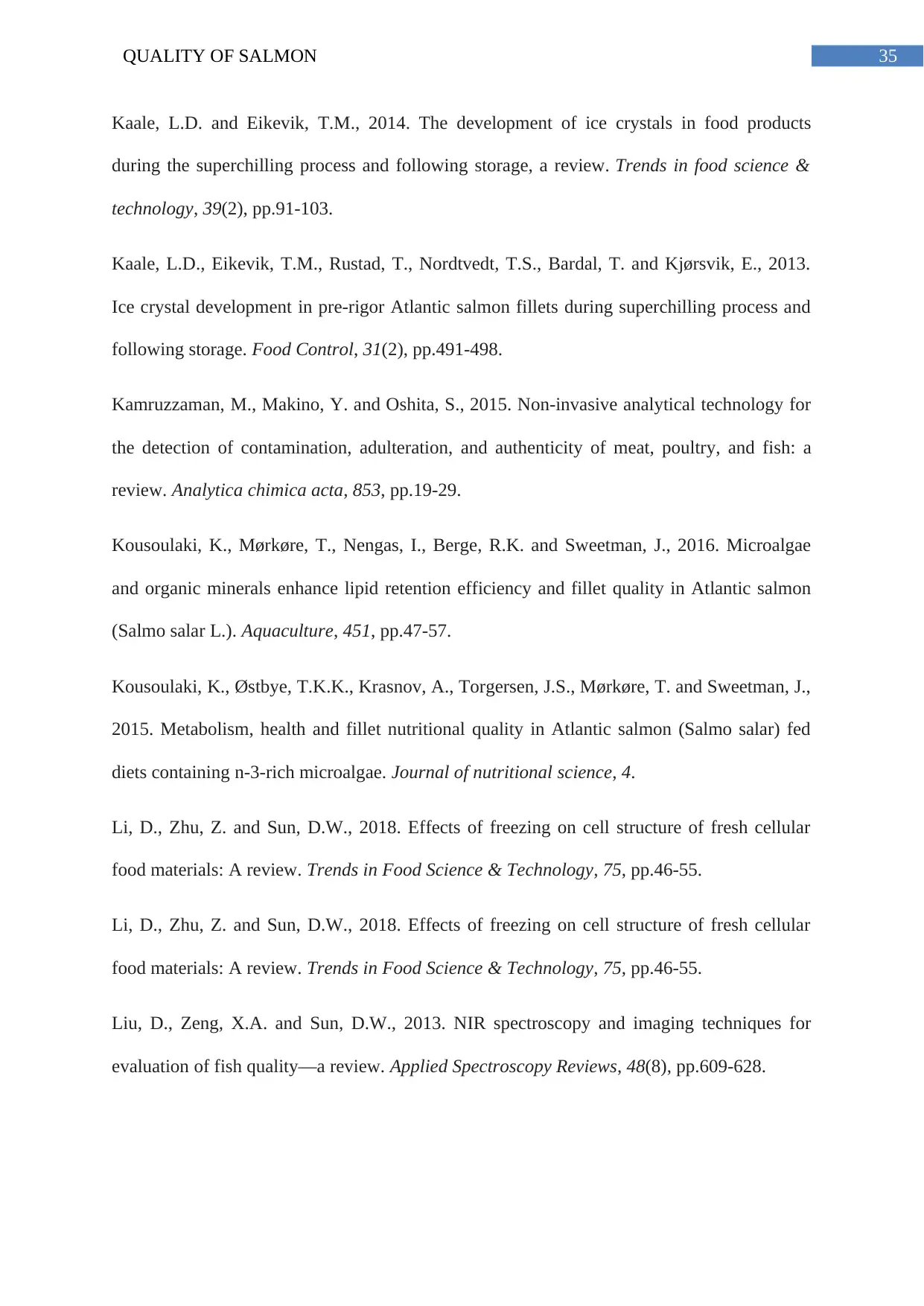
35QUALITY OF SALMON
Kaale, L.D. and Eikevik, T.M., 2014. The development of ice crystals in food products
during the superchilling process and following storage, a review. Trends in food science &
technology, 39(2), pp.91-103.
Kaale, L.D., Eikevik, T.M., Rustad, T., Nordtvedt, T.S., Bardal, T. and Kjørsvik, E., 2013.
Ice crystal development in pre-rigor Atlantic salmon fillets during superchilling process and
following storage. Food Control, 31(2), pp.491-498.
Kamruzzaman, M., Makino, Y. and Oshita, S., 2015. Non-invasive analytical technology for
the detection of contamination, adulteration, and authenticity of meat, poultry, and fish: a
review. Analytica chimica acta, 853, pp.19-29.
Kousoulaki, K., Mørkøre, T., Nengas, I., Berge, R.K. and Sweetman, J., 2016. Microalgae
and organic minerals enhance lipid retention efficiency and fillet quality in Atlantic salmon
(Salmo salar L.). Aquaculture, 451, pp.47-57.
Kousoulaki, K., Østbye, T.K.K., Krasnov, A., Torgersen, J.S., Mørkøre, T. and Sweetman, J.,
2015. Metabolism, health and fillet nutritional quality in Atlantic salmon (Salmo salar) fed
diets containing n-3-rich microalgae. Journal of nutritional science, 4.
Li, D., Zhu, Z. and Sun, D.W., 2018. Effects of freezing on cell structure of fresh cellular
food materials: A review. Trends in Food Science & Technology, 75, pp.46-55.
Li, D., Zhu, Z. and Sun, D.W., 2018. Effects of freezing on cell structure of fresh cellular
food materials: A review. Trends in Food Science & Technology, 75, pp.46-55.
Liu, D., Zeng, X.A. and Sun, D.W., 2013. NIR spectroscopy and imaging techniques for
evaluation of fish quality—a review. Applied Spectroscopy Reviews, 48(8), pp.609-628.
Kaale, L.D. and Eikevik, T.M., 2014. The development of ice crystals in food products
during the superchilling process and following storage, a review. Trends in food science &
technology, 39(2), pp.91-103.
Kaale, L.D., Eikevik, T.M., Rustad, T., Nordtvedt, T.S., Bardal, T. and Kjørsvik, E., 2013.
Ice crystal development in pre-rigor Atlantic salmon fillets during superchilling process and
following storage. Food Control, 31(2), pp.491-498.
Kamruzzaman, M., Makino, Y. and Oshita, S., 2015. Non-invasive analytical technology for
the detection of contamination, adulteration, and authenticity of meat, poultry, and fish: a
review. Analytica chimica acta, 853, pp.19-29.
Kousoulaki, K., Mørkøre, T., Nengas, I., Berge, R.K. and Sweetman, J., 2016. Microalgae
and organic minerals enhance lipid retention efficiency and fillet quality in Atlantic salmon
(Salmo salar L.). Aquaculture, 451, pp.47-57.
Kousoulaki, K., Østbye, T.K.K., Krasnov, A., Torgersen, J.S., Mørkøre, T. and Sweetman, J.,
2015. Metabolism, health and fillet nutritional quality in Atlantic salmon (Salmo salar) fed
diets containing n-3-rich microalgae. Journal of nutritional science, 4.
Li, D., Zhu, Z. and Sun, D.W., 2018. Effects of freezing on cell structure of fresh cellular
food materials: A review. Trends in Food Science & Technology, 75, pp.46-55.
Li, D., Zhu, Z. and Sun, D.W., 2018. Effects of freezing on cell structure of fresh cellular
food materials: A review. Trends in Food Science & Technology, 75, pp.46-55.
Liu, D., Zeng, X.A. and Sun, D.W., 2013. NIR spectroscopy and imaging techniques for
evaluation of fish quality—a review. Applied Spectroscopy Reviews, 48(8), pp.609-628.
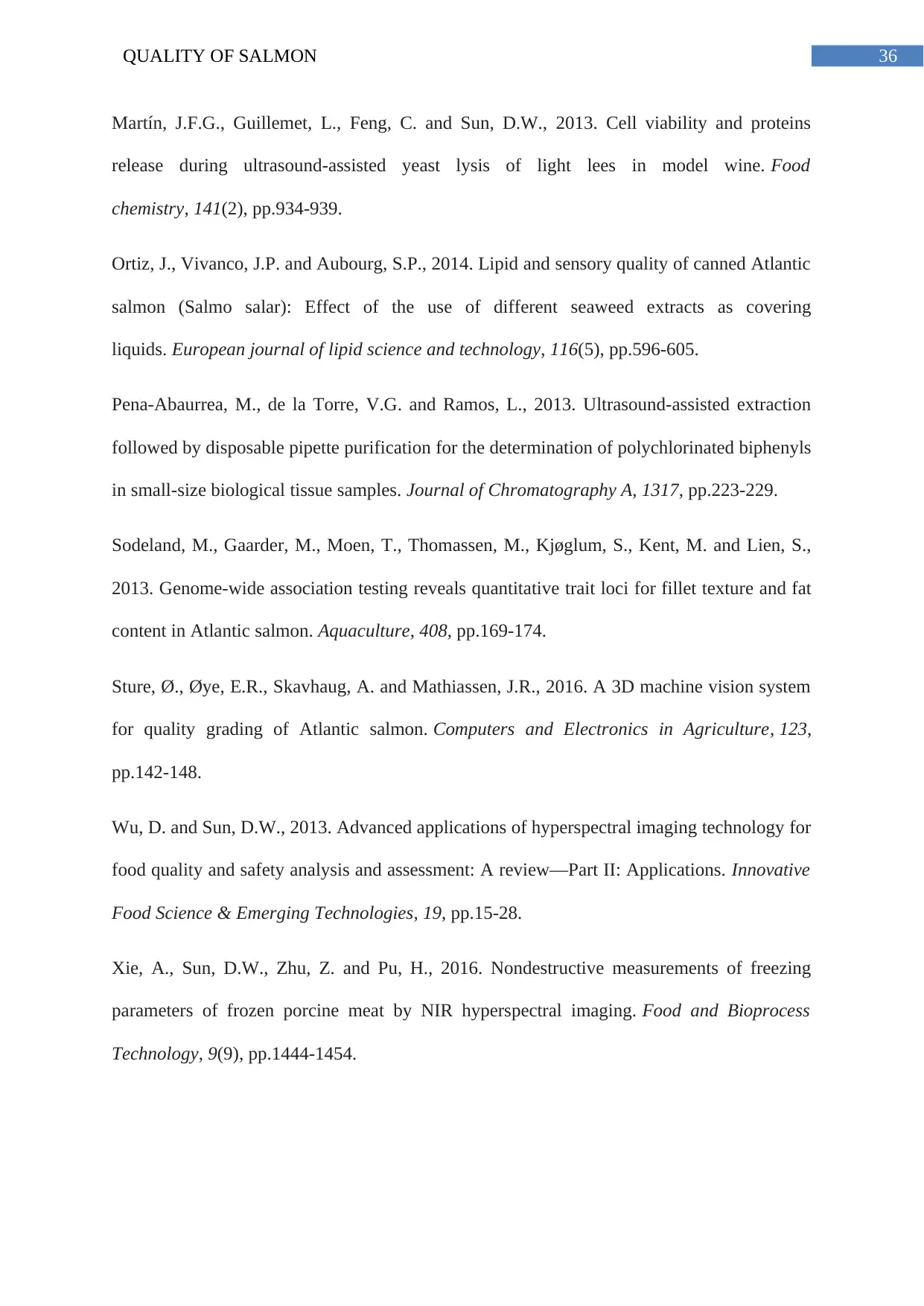
36QUALITY OF SALMON
Martín, J.F.G., Guillemet, L., Feng, C. and Sun, D.W., 2013. Cell viability and proteins
release during ultrasound-assisted yeast lysis of light lees in model wine. Food
chemistry, 141(2), pp.934-939.
Ortiz, J., Vivanco, J.P. and Aubourg, S.P., 2014. Lipid and sensory quality of canned Atlantic
salmon (Salmo salar): Effect of the use of different seaweed extracts as covering
liquids. European journal of lipid science and technology, 116(5), pp.596-605.
Pena-Abaurrea, M., de la Torre, V.G. and Ramos, L., 2013. Ultrasound-assisted extraction
followed by disposable pipette purification for the determination of polychlorinated biphenyls
in small-size biological tissue samples. Journal of Chromatography A, 1317, pp.223-229.
Sodeland, M., Gaarder, M., Moen, T., Thomassen, M., Kjøglum, S., Kent, M. and Lien, S.,
2013. Genome-wide association testing reveals quantitative trait loci for fillet texture and fat
content in Atlantic salmon. Aquaculture, 408, pp.169-174.
Sture, Ø., Øye, E.R., Skavhaug, A. and Mathiassen, J.R., 2016. A 3D machine vision system
for quality grading of Atlantic salmon. Computers and Electronics in Agriculture, 123,
pp.142-148.
Wu, D. and Sun, D.W., 2013. Advanced applications of hyperspectral imaging technology for
food quality and safety analysis and assessment: A review—Part II: Applications. Innovative
Food Science & Emerging Technologies, 19, pp.15-28.
Xie, A., Sun, D.W., Zhu, Z. and Pu, H., 2016. Nondestructive measurements of freezing
parameters of frozen porcine meat by NIR hyperspectral imaging. Food and Bioprocess
Technology, 9(9), pp.1444-1454.
Martín, J.F.G., Guillemet, L., Feng, C. and Sun, D.W., 2013. Cell viability and proteins
release during ultrasound-assisted yeast lysis of light lees in model wine. Food
chemistry, 141(2), pp.934-939.
Ortiz, J., Vivanco, J.P. and Aubourg, S.P., 2014. Lipid and sensory quality of canned Atlantic
salmon (Salmo salar): Effect of the use of different seaweed extracts as covering
liquids. European journal of lipid science and technology, 116(5), pp.596-605.
Pena-Abaurrea, M., de la Torre, V.G. and Ramos, L., 2013. Ultrasound-assisted extraction
followed by disposable pipette purification for the determination of polychlorinated biphenyls
in small-size biological tissue samples. Journal of Chromatography A, 1317, pp.223-229.
Sodeland, M., Gaarder, M., Moen, T., Thomassen, M., Kjøglum, S., Kent, M. and Lien, S.,
2013. Genome-wide association testing reveals quantitative trait loci for fillet texture and fat
content in Atlantic salmon. Aquaculture, 408, pp.169-174.
Sture, Ø., Øye, E.R., Skavhaug, A. and Mathiassen, J.R., 2016. A 3D machine vision system
for quality grading of Atlantic salmon. Computers and Electronics in Agriculture, 123,
pp.142-148.
Wu, D. and Sun, D.W., 2013. Advanced applications of hyperspectral imaging technology for
food quality and safety analysis and assessment: A review—Part II: Applications. Innovative
Food Science & Emerging Technologies, 19, pp.15-28.
Xie, A., Sun, D.W., Zhu, Z. and Pu, H., 2016. Nondestructive measurements of freezing
parameters of frozen porcine meat by NIR hyperspectral imaging. Food and Bioprocess
Technology, 9(9), pp.1444-1454.
Paraphrase This Document
Need a fresh take? Get an instant paraphrase of this document with our AI Paraphraser
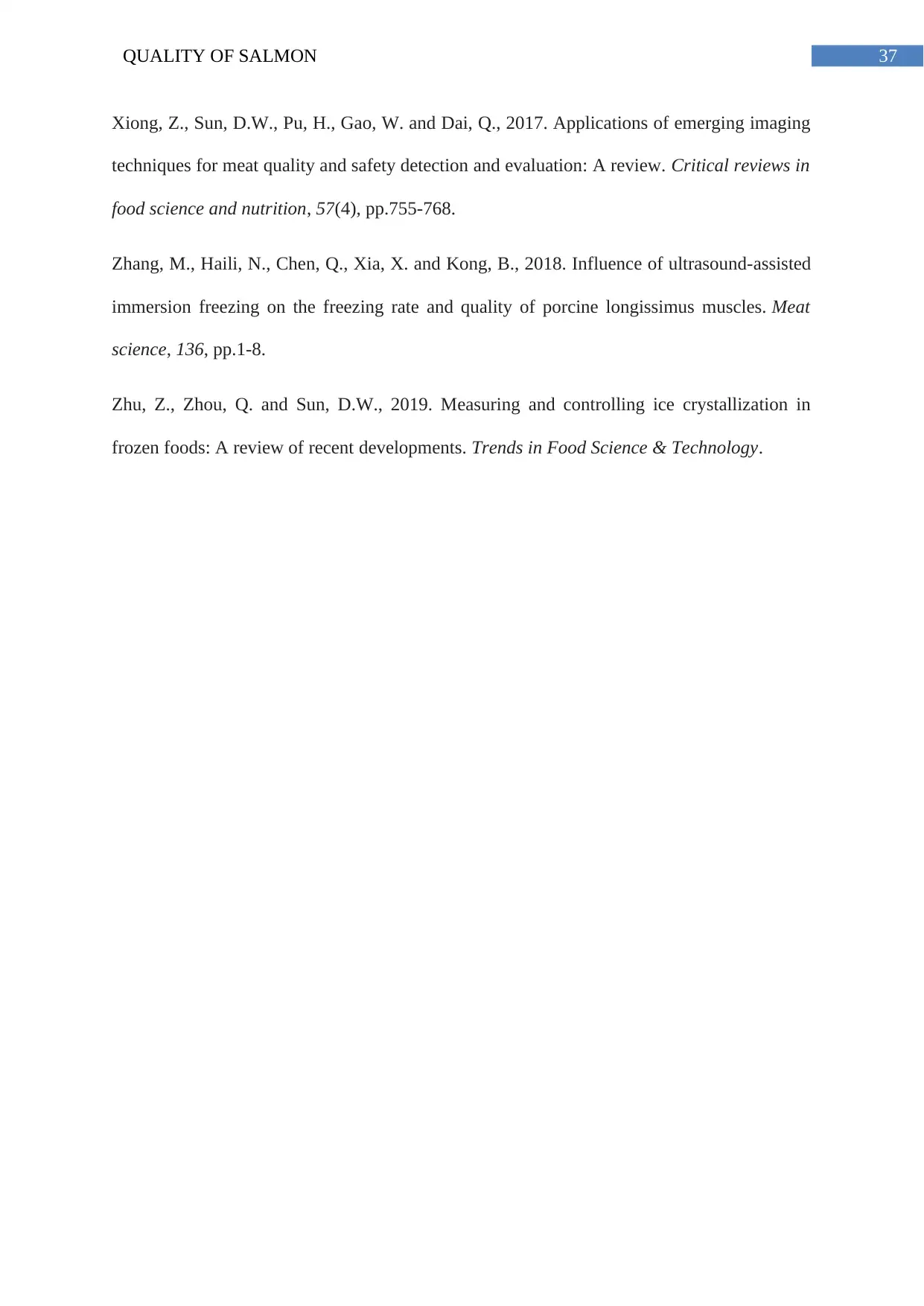
37QUALITY OF SALMON
Xiong, Z., Sun, D.W., Pu, H., Gao, W. and Dai, Q., 2017. Applications of emerging imaging
techniques for meat quality and safety detection and evaluation: A review. Critical reviews in
food science and nutrition, 57(4), pp.755-768.
Zhang, M., Haili, N., Chen, Q., Xia, X. and Kong, B., 2018. Influence of ultrasound-assisted
immersion freezing on the freezing rate and quality of porcine longissimus muscles. Meat
science, 136, pp.1-8.
Zhu, Z., Zhou, Q. and Sun, D.W., 2019. Measuring and controlling ice crystallization in
frozen foods: A review of recent developments. Trends in Food Science & Technology.
Xiong, Z., Sun, D.W., Pu, H., Gao, W. and Dai, Q., 2017. Applications of emerging imaging
techniques for meat quality and safety detection and evaluation: A review. Critical reviews in
food science and nutrition, 57(4), pp.755-768.
Zhang, M., Haili, N., Chen, Q., Xia, X. and Kong, B., 2018. Influence of ultrasound-assisted
immersion freezing on the freezing rate and quality of porcine longissimus muscles. Meat
science, 136, pp.1-8.
Zhu, Z., Zhou, Q. and Sun, D.W., 2019. Measuring and controlling ice crystallization in
frozen foods: A review of recent developments. Trends in Food Science & Technology.
1 out of 38
Related Documents
Your All-in-One AI-Powered Toolkit for Academic Success.
+13062052269
info@desklib.com
Available 24*7 on WhatsApp / Email
![[object Object]](/_next/static/media/star-bottom.7253800d.svg)
Unlock your academic potential
© 2024 | Zucol Services PVT LTD | All rights reserved.
